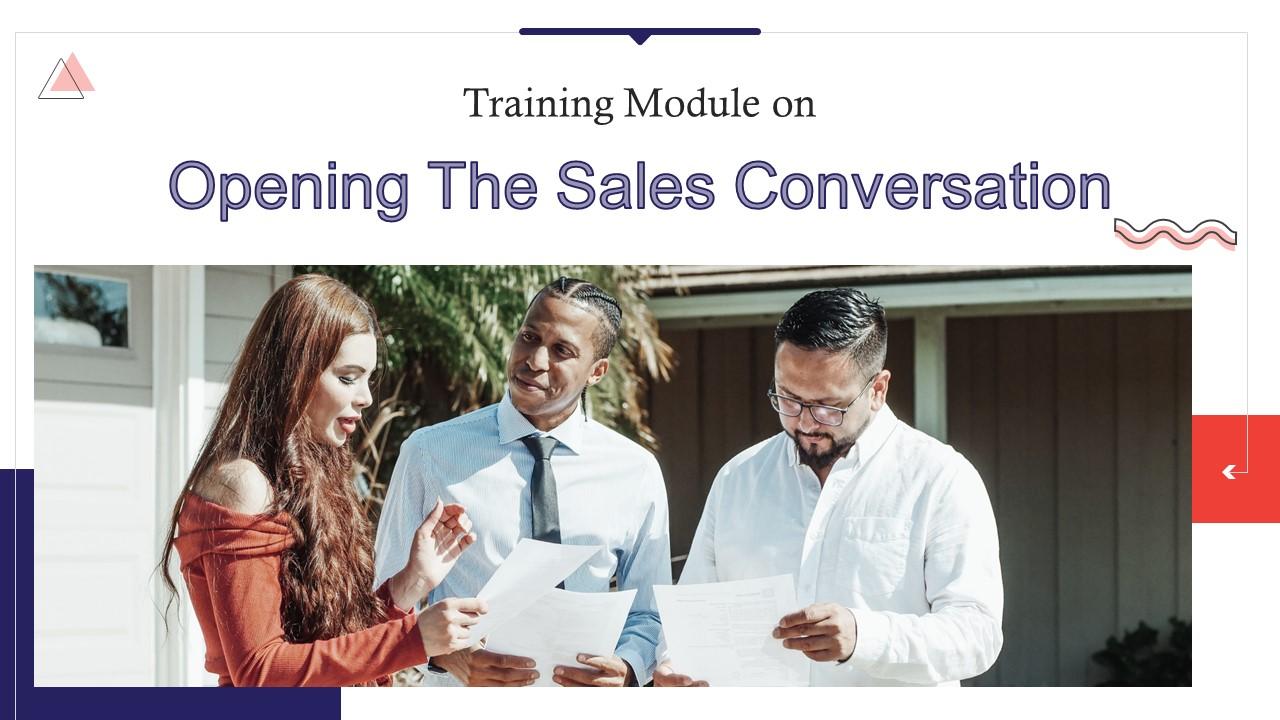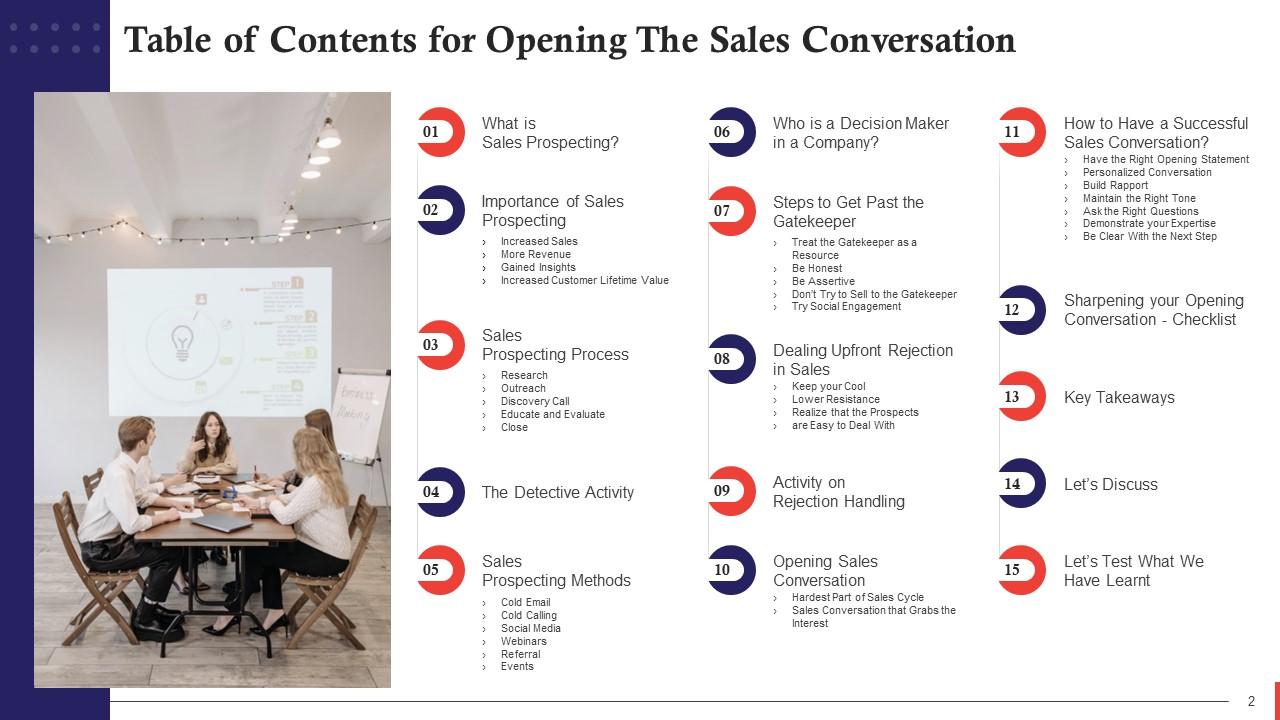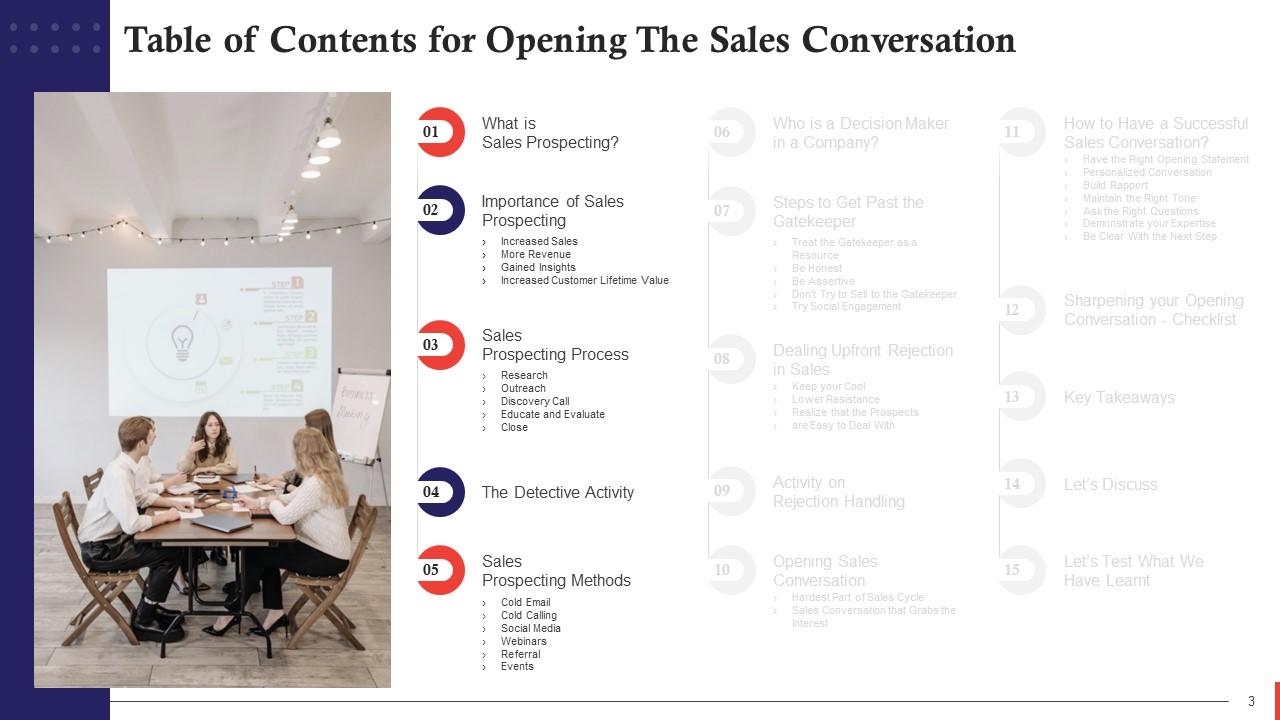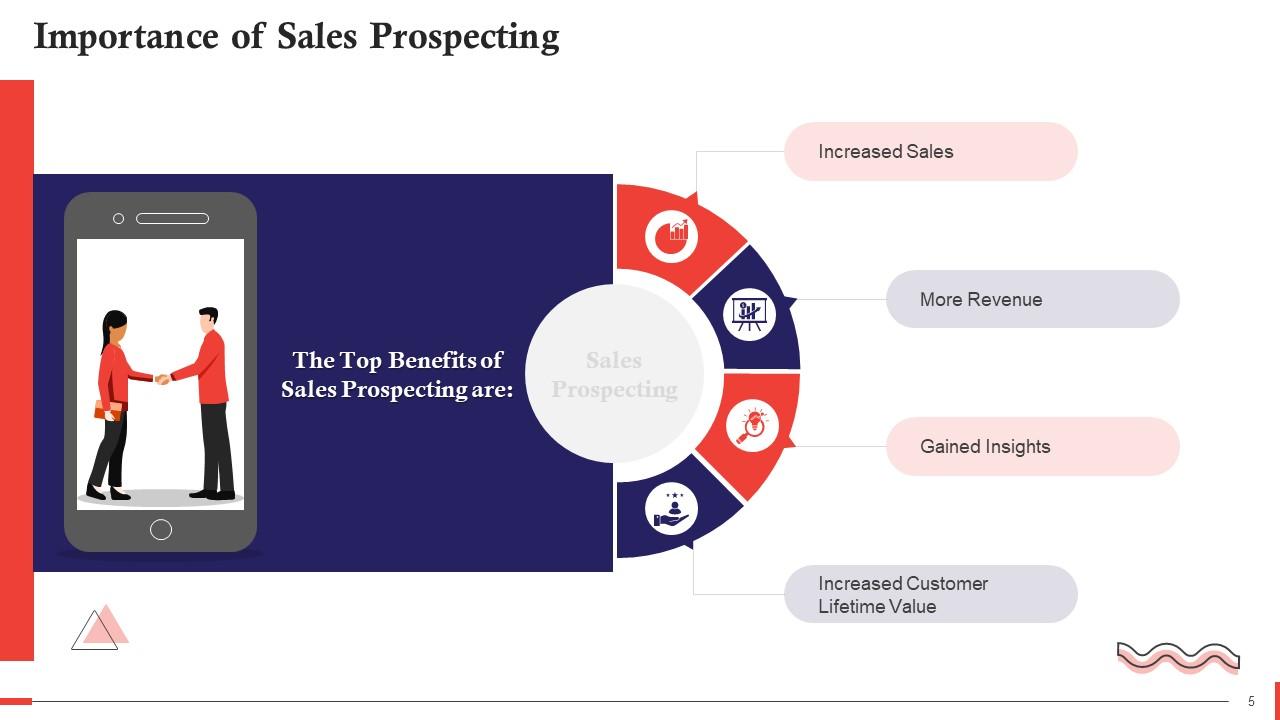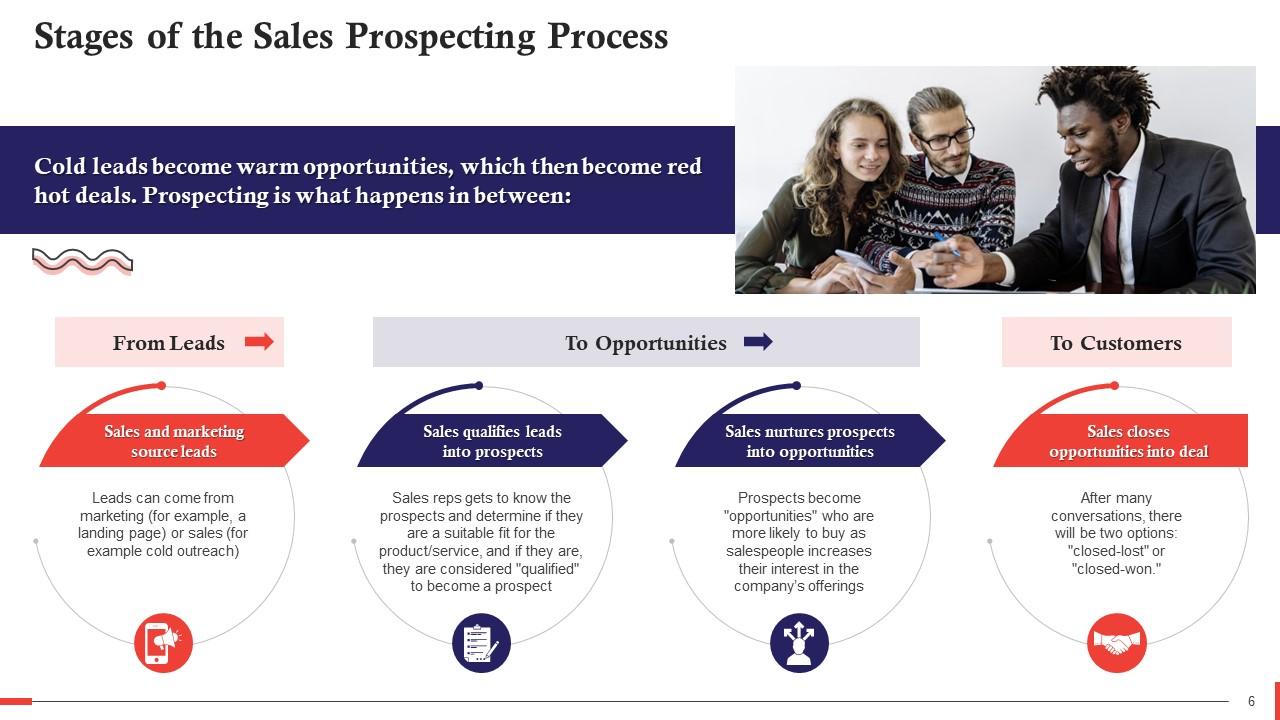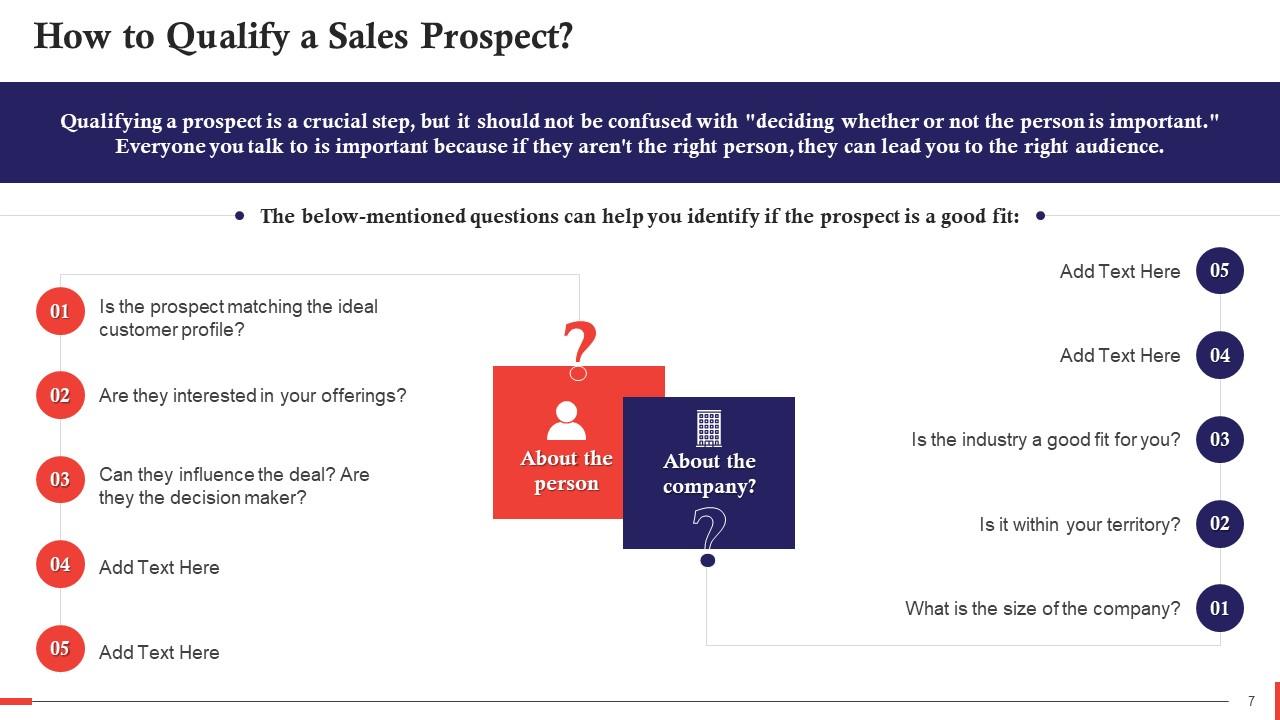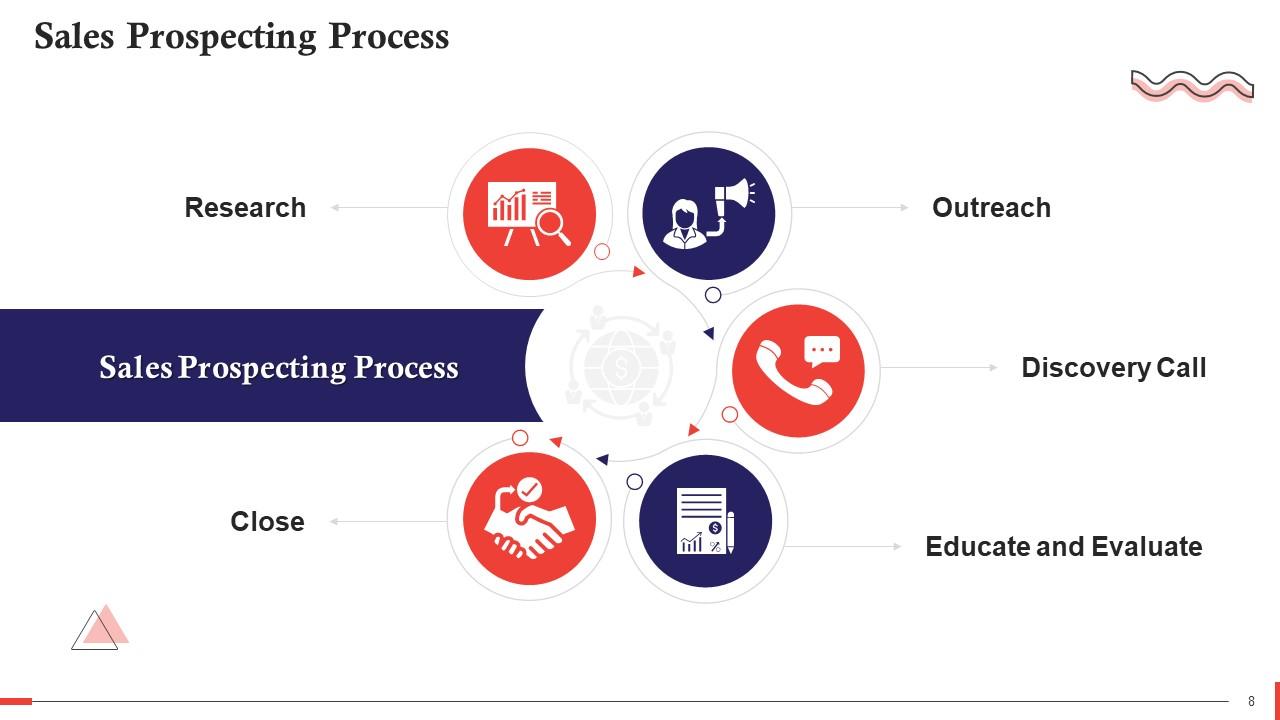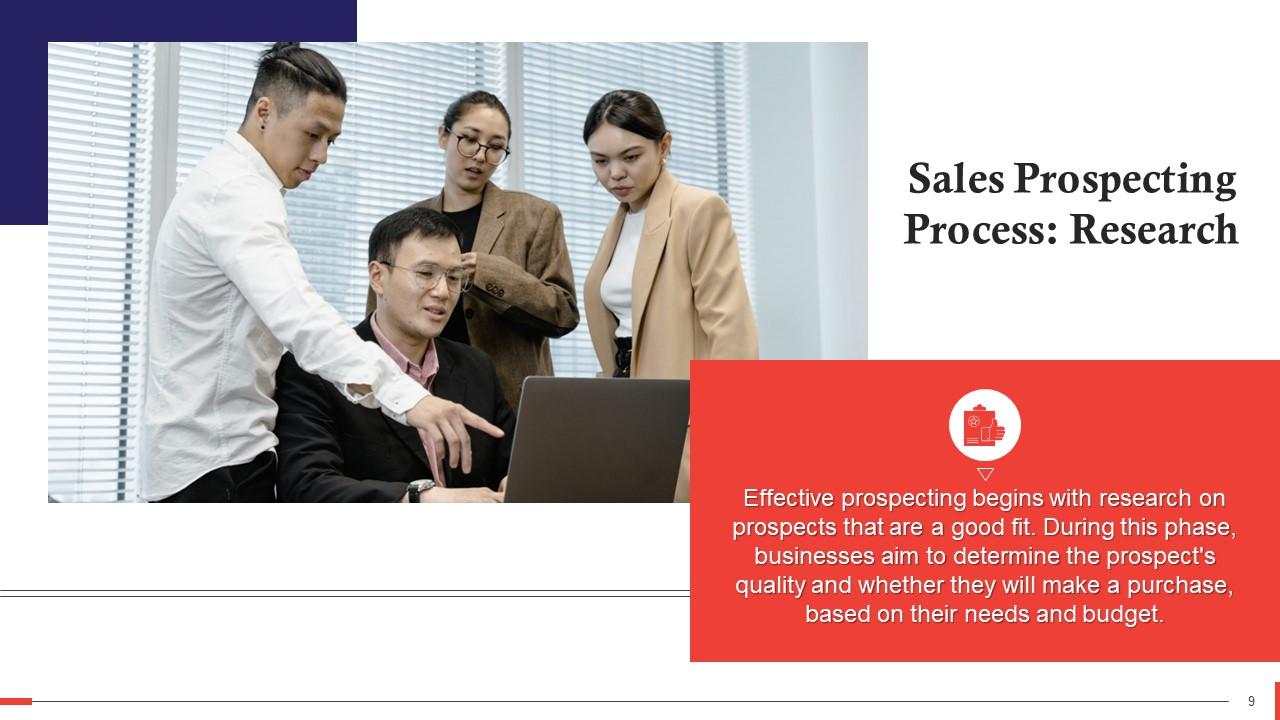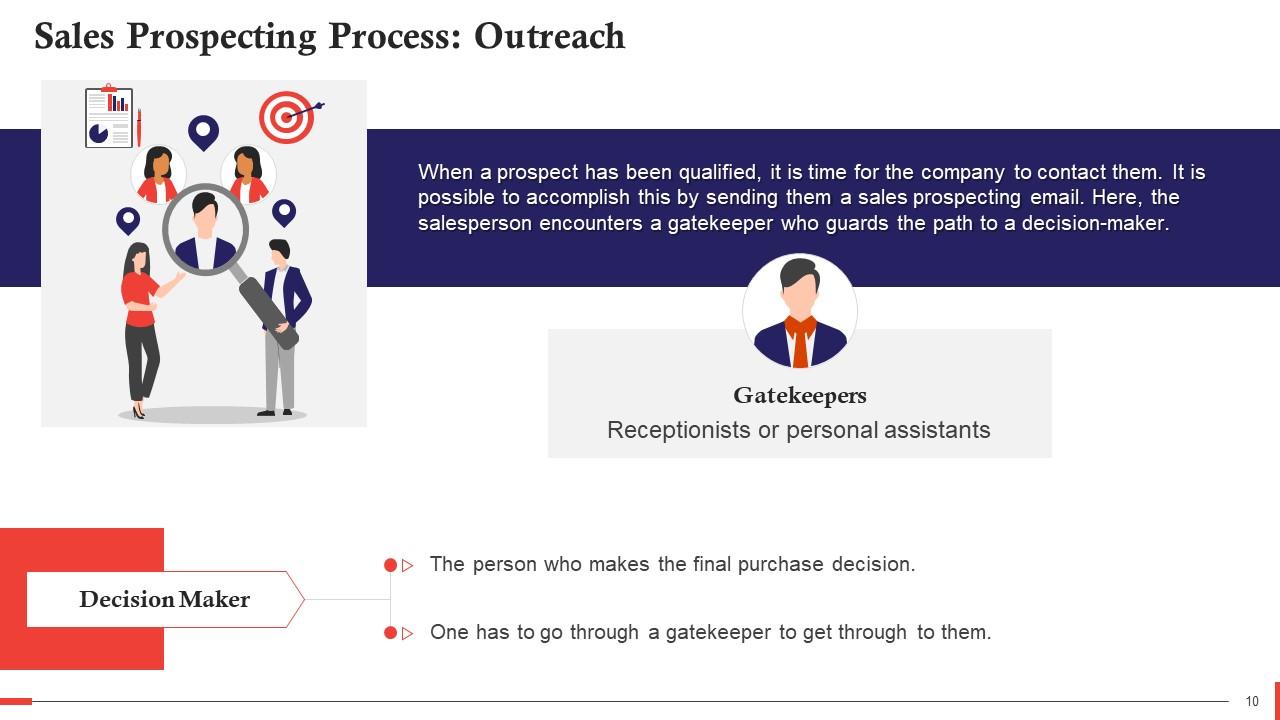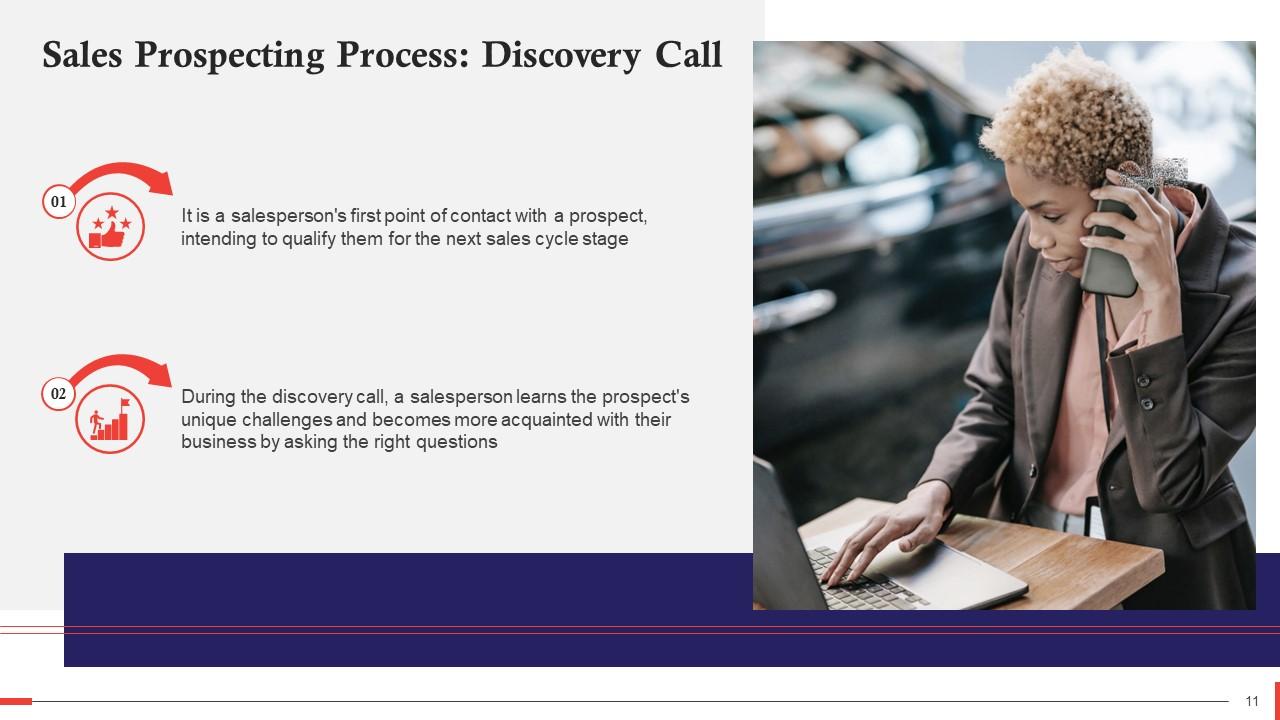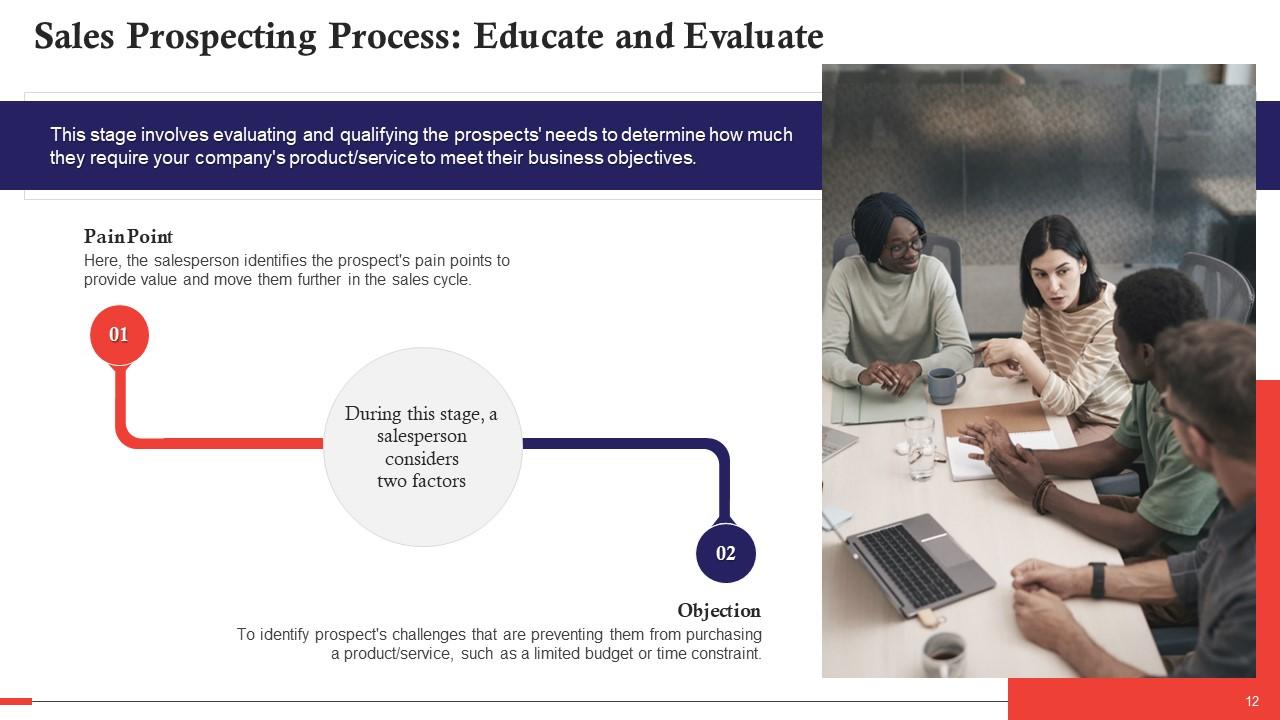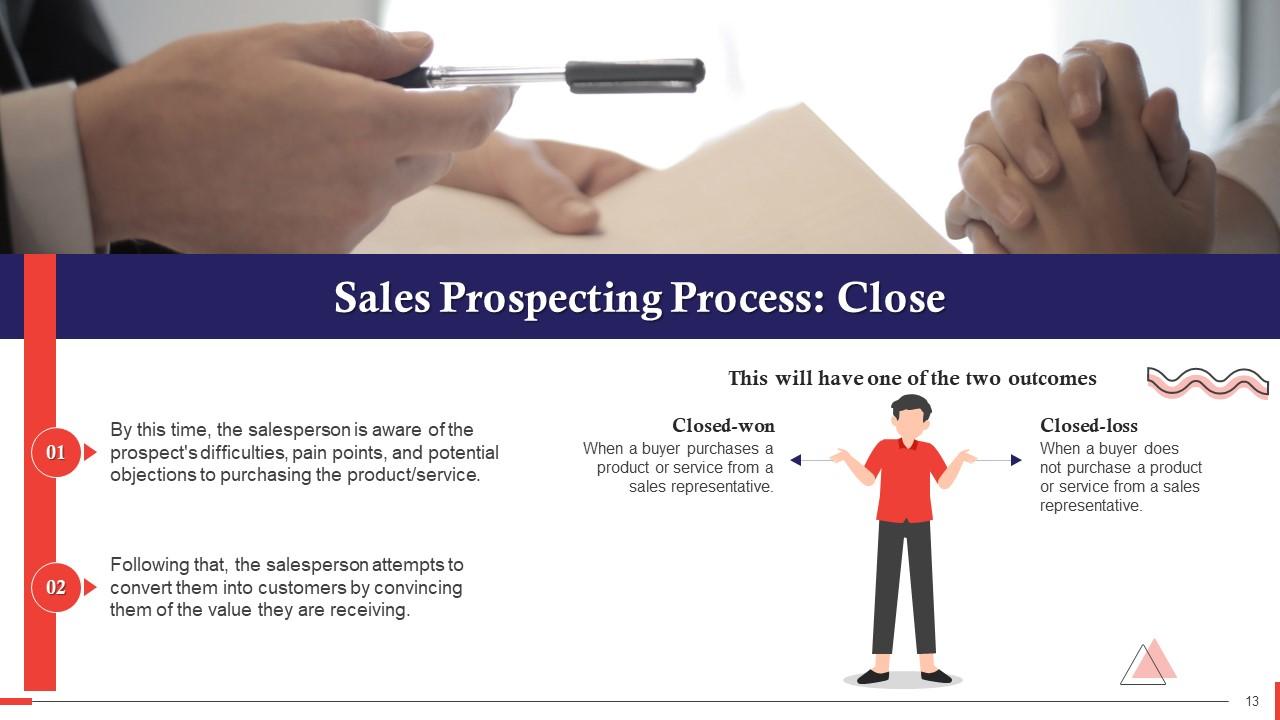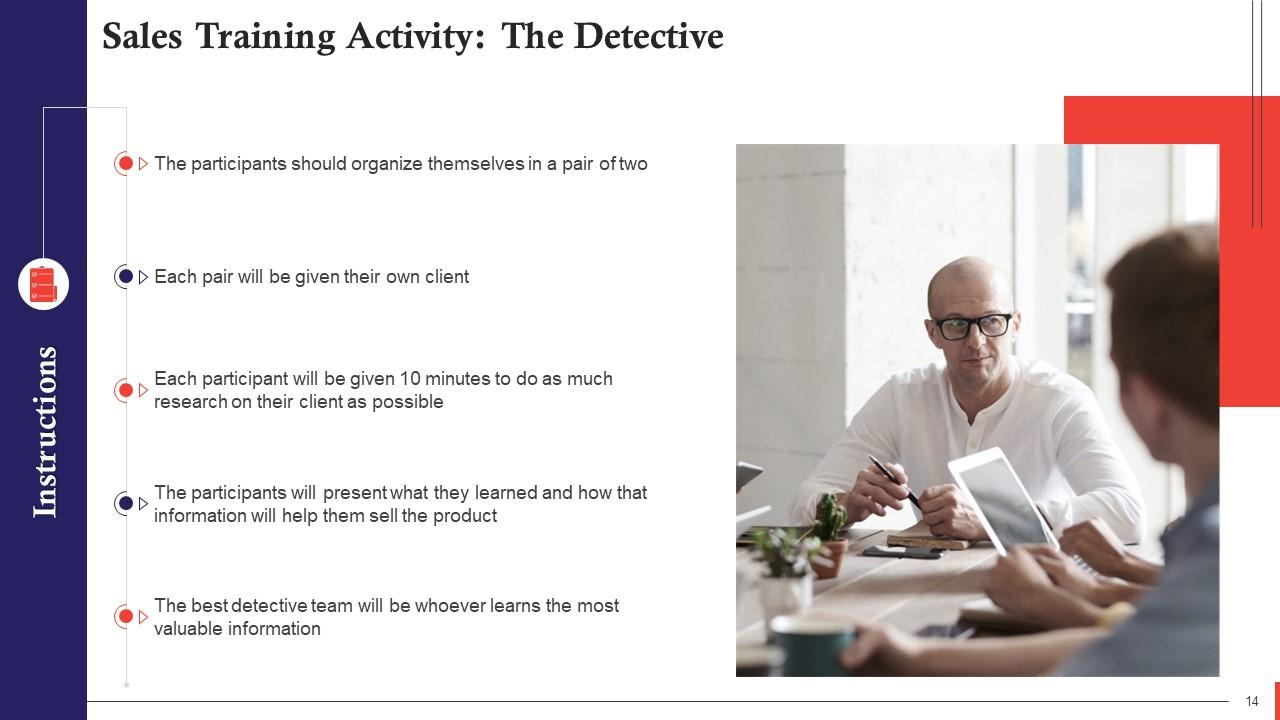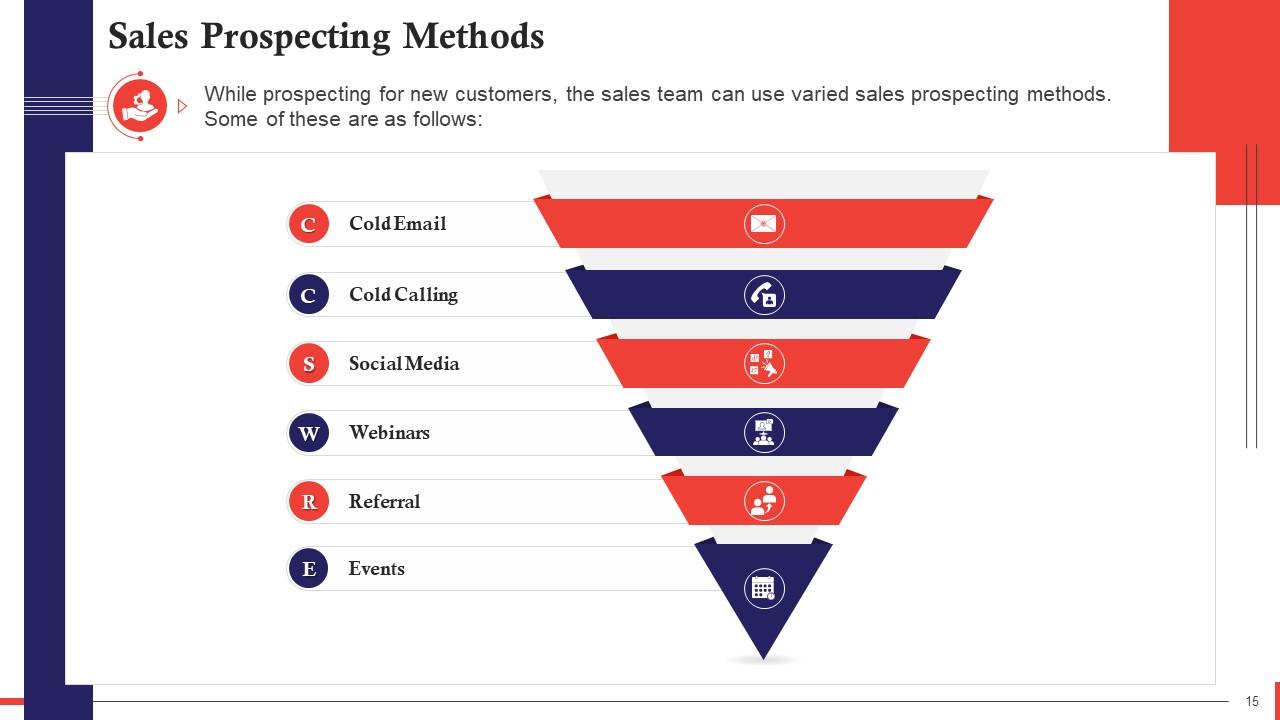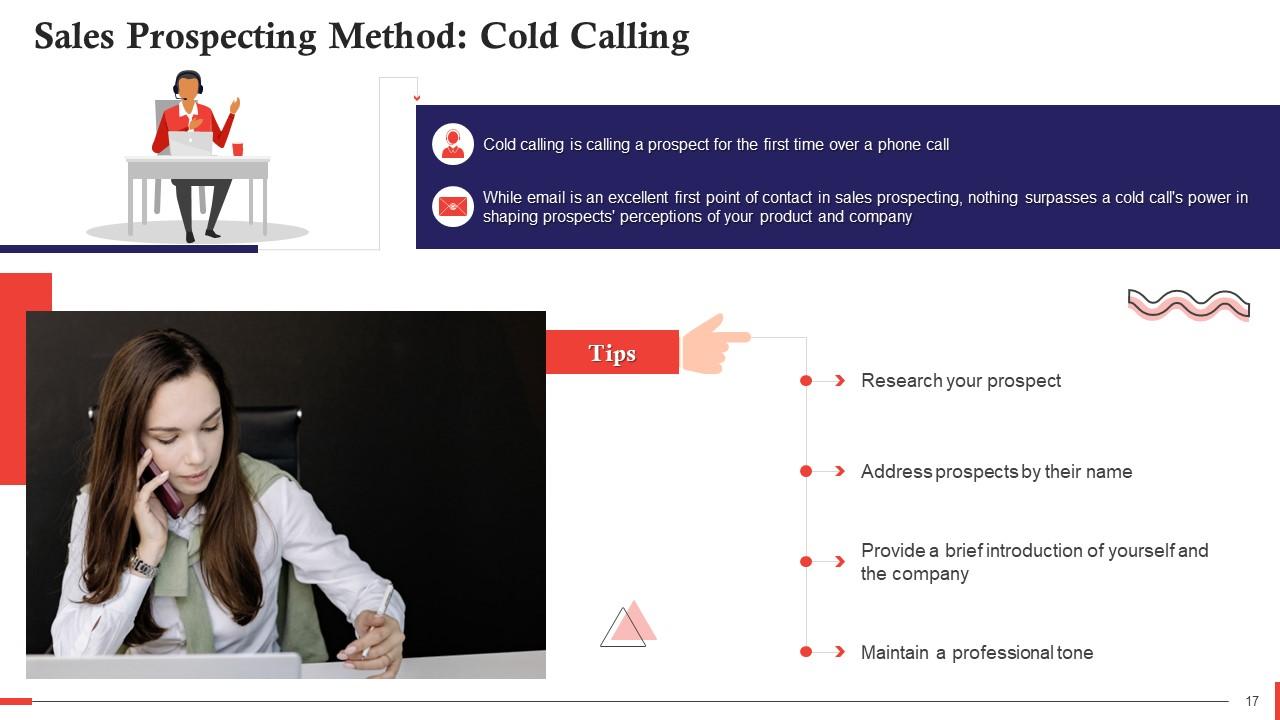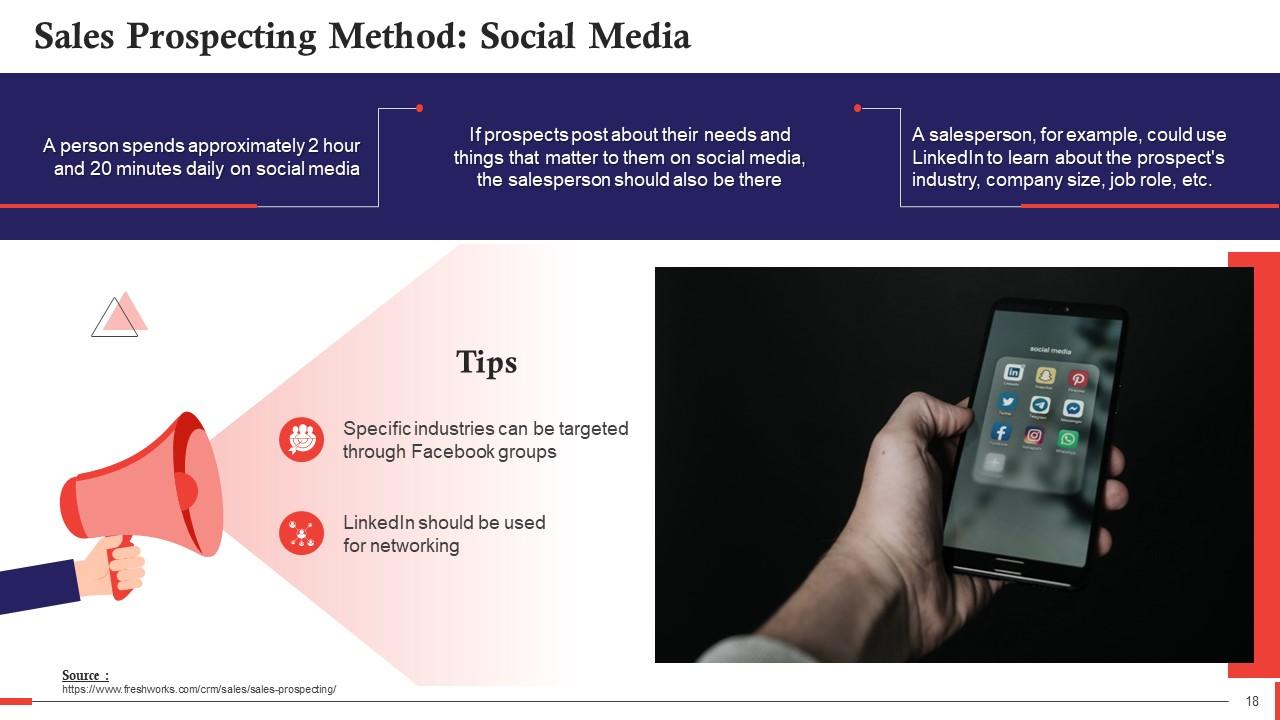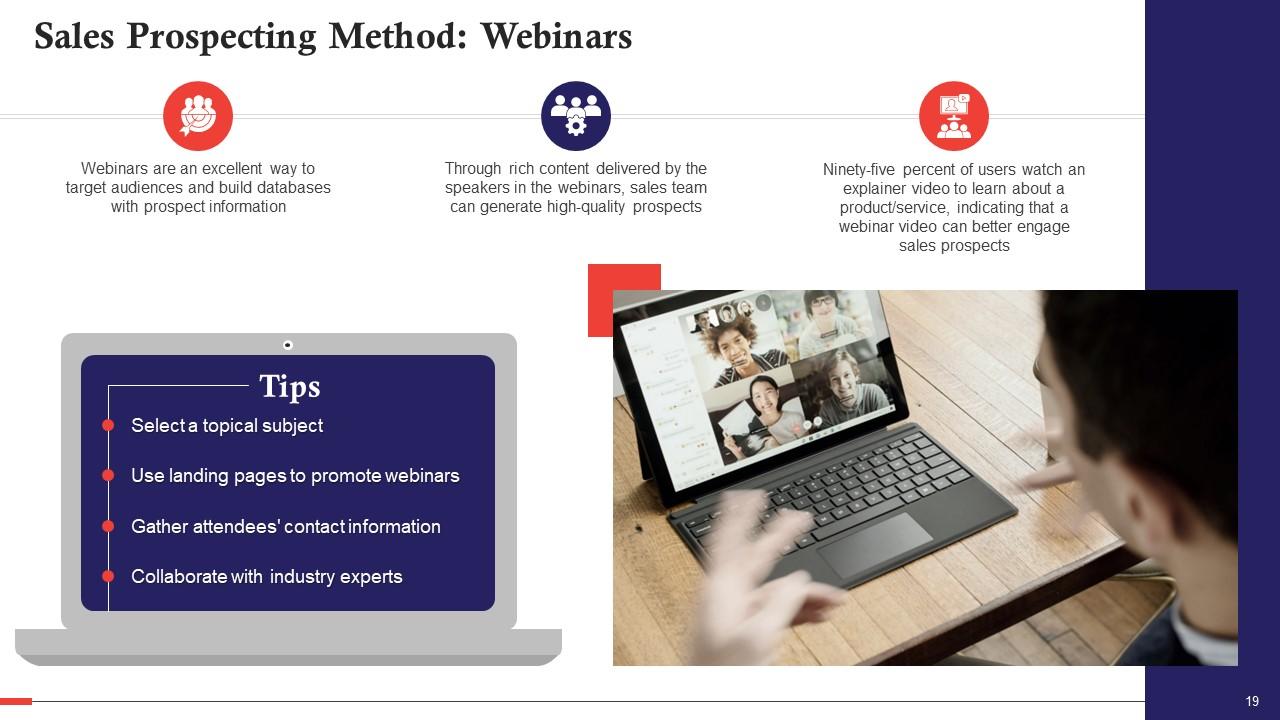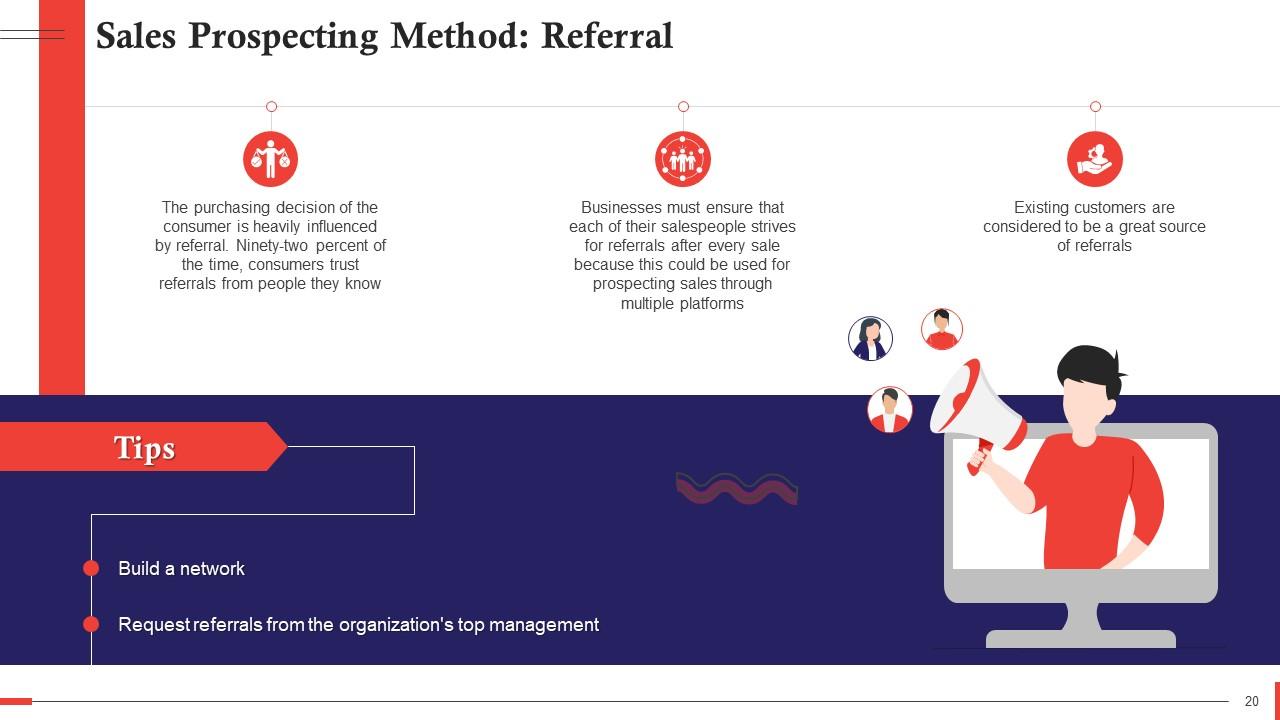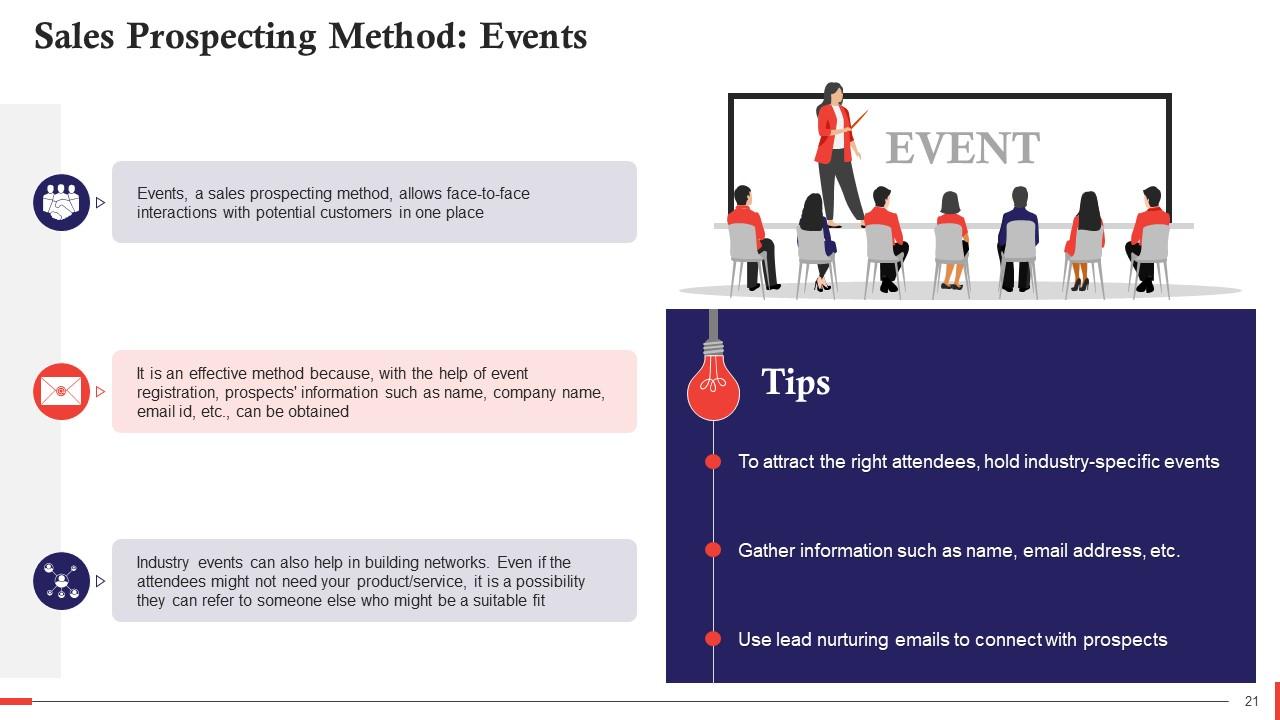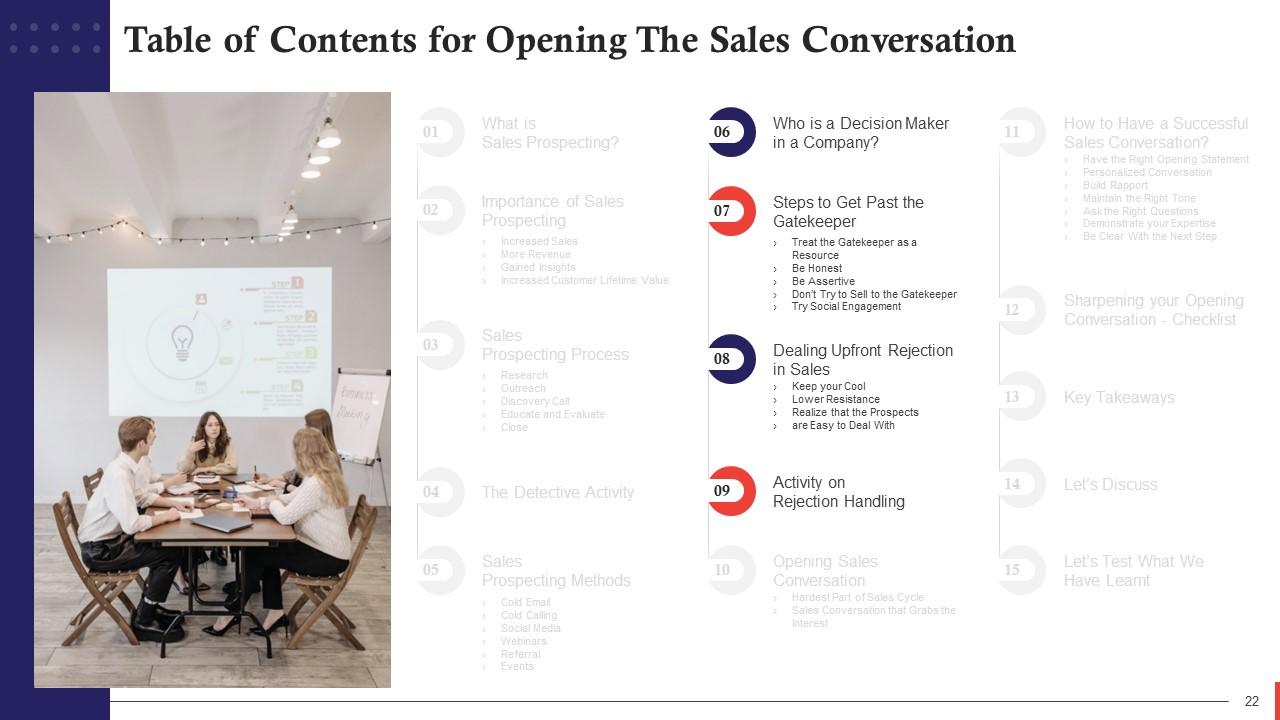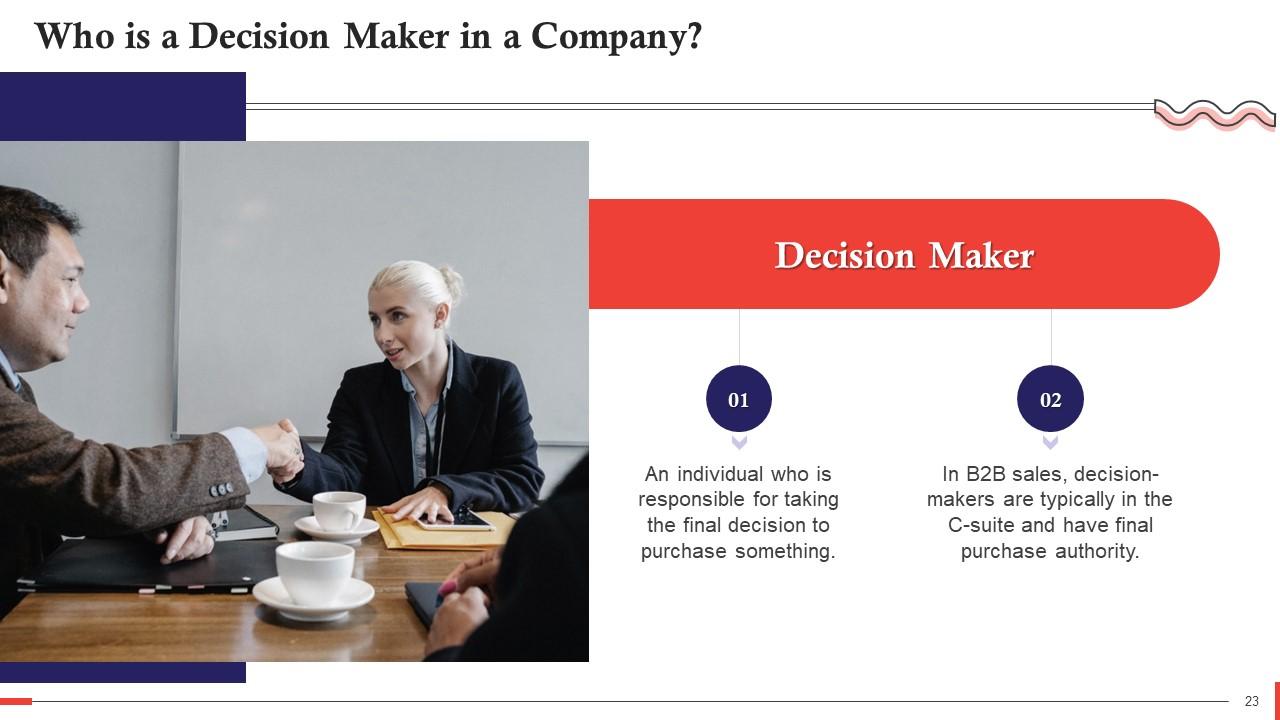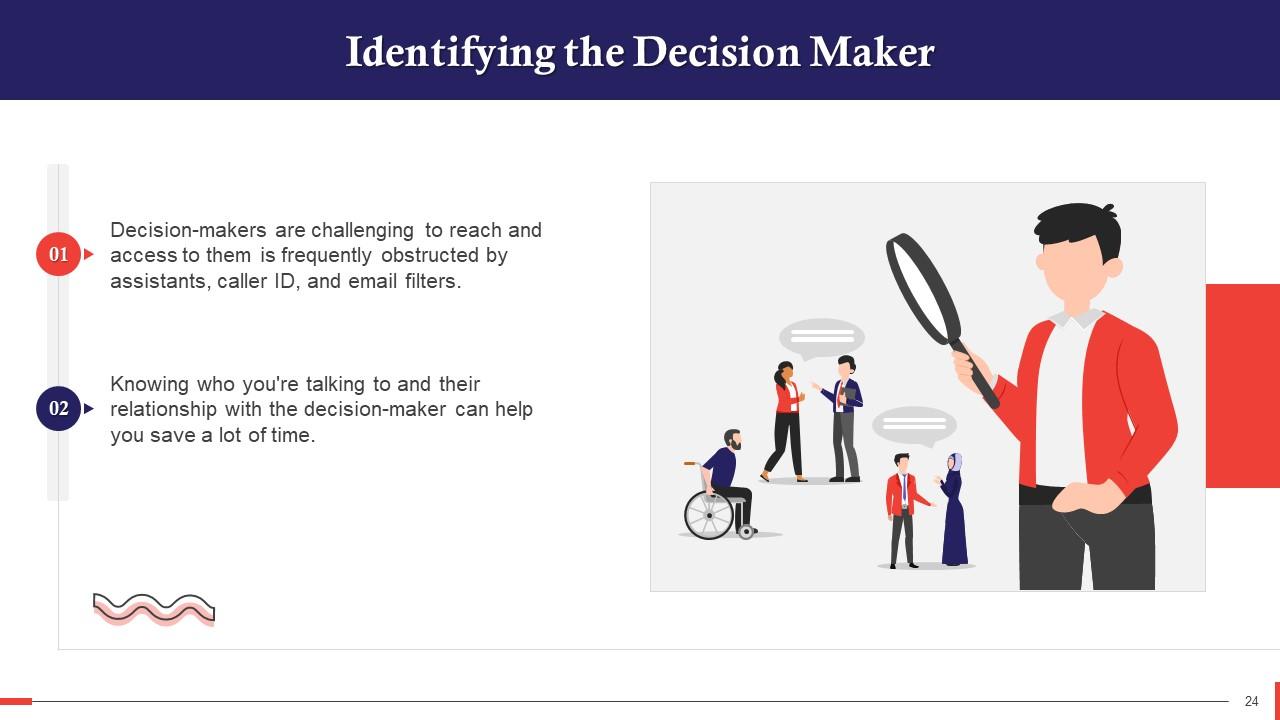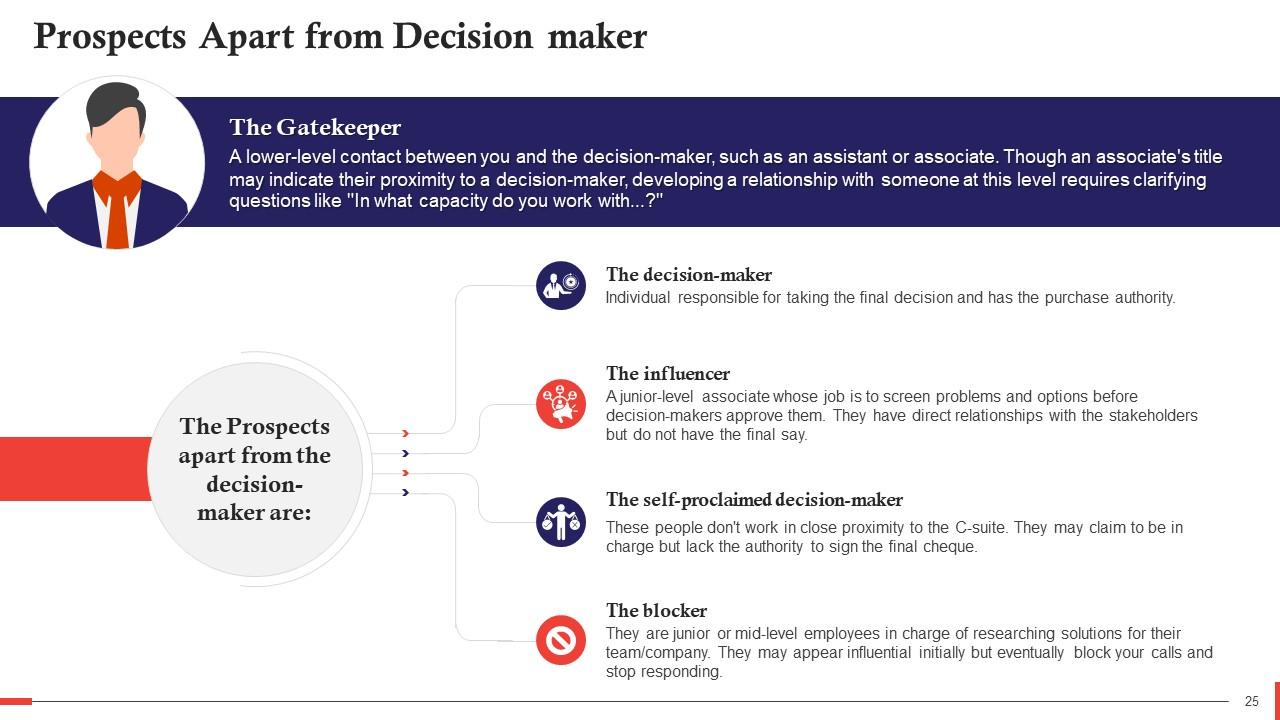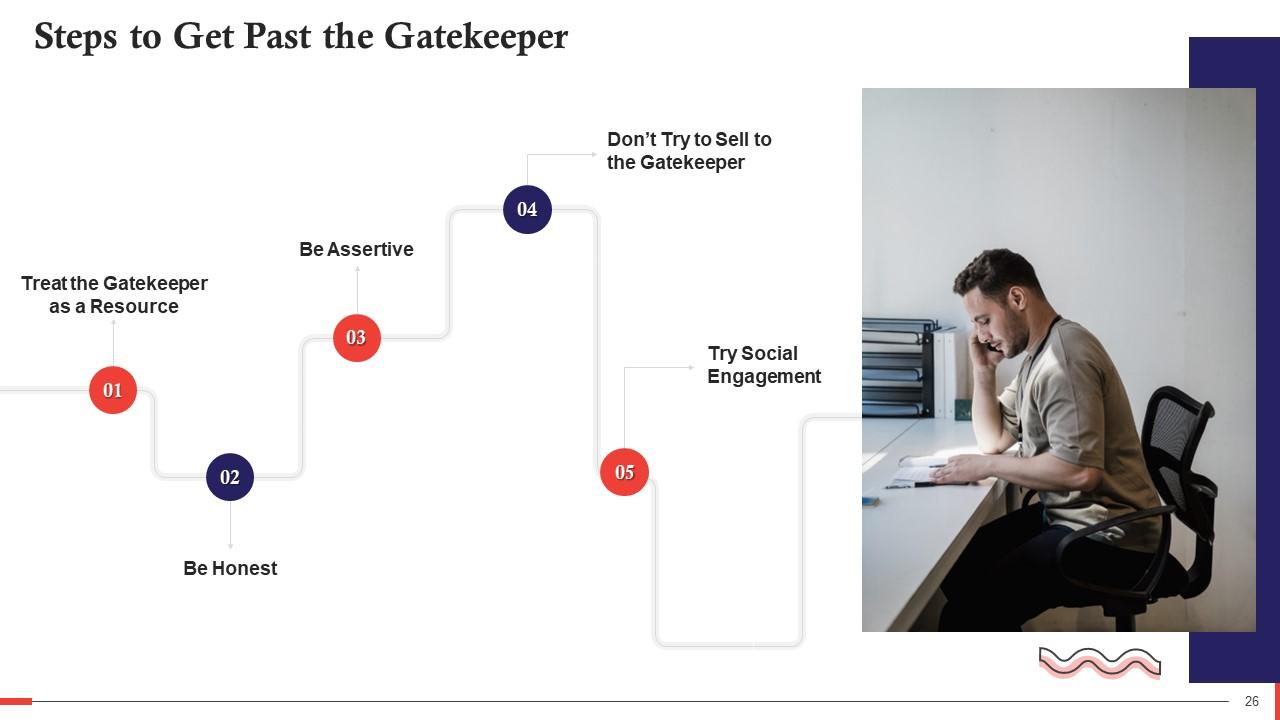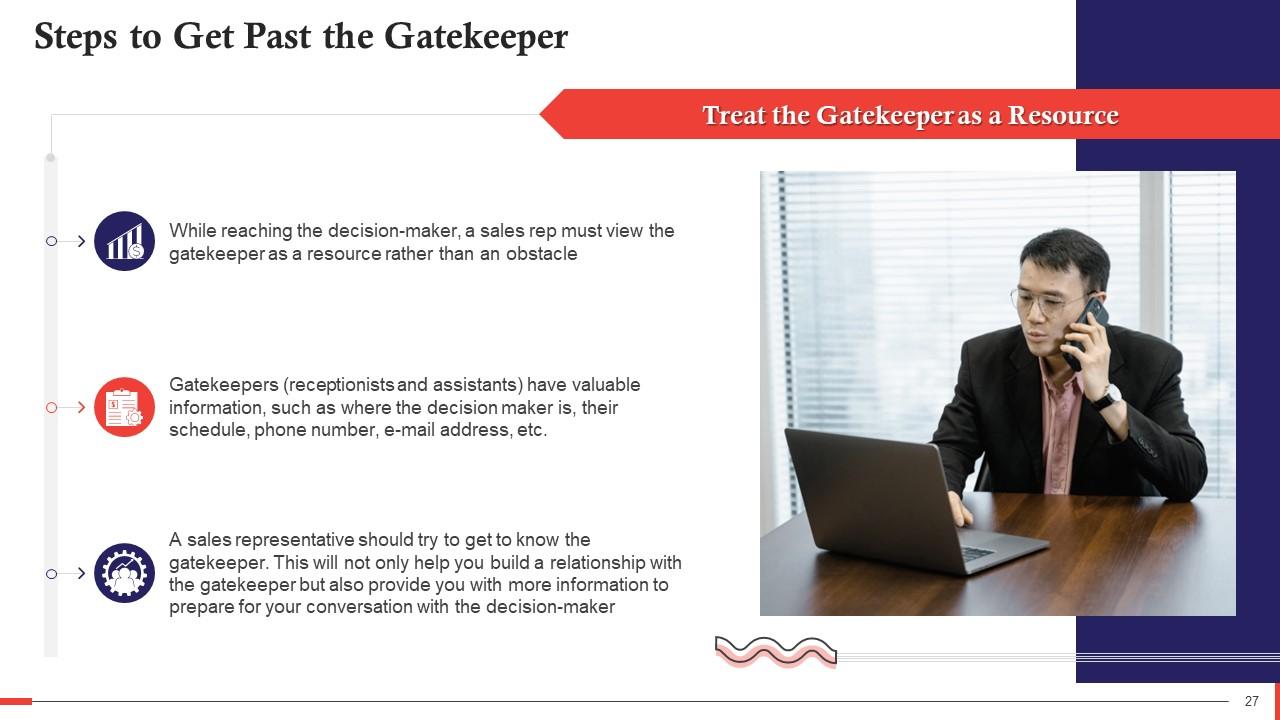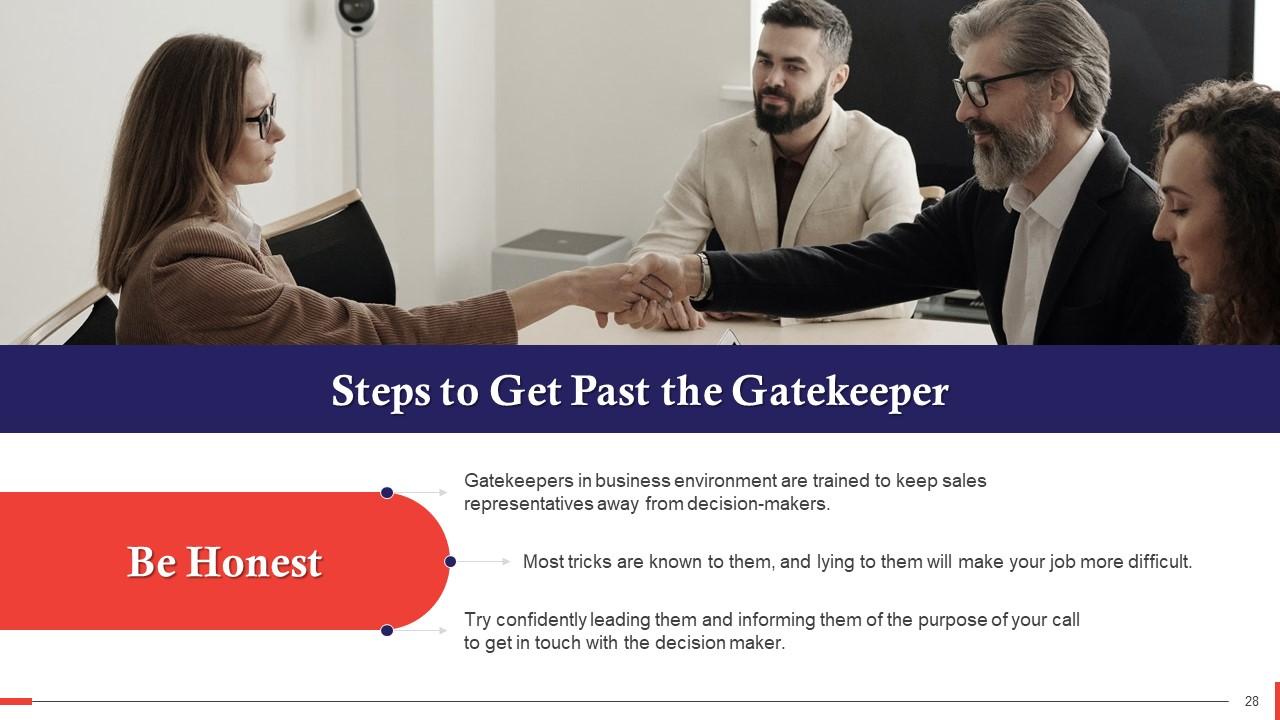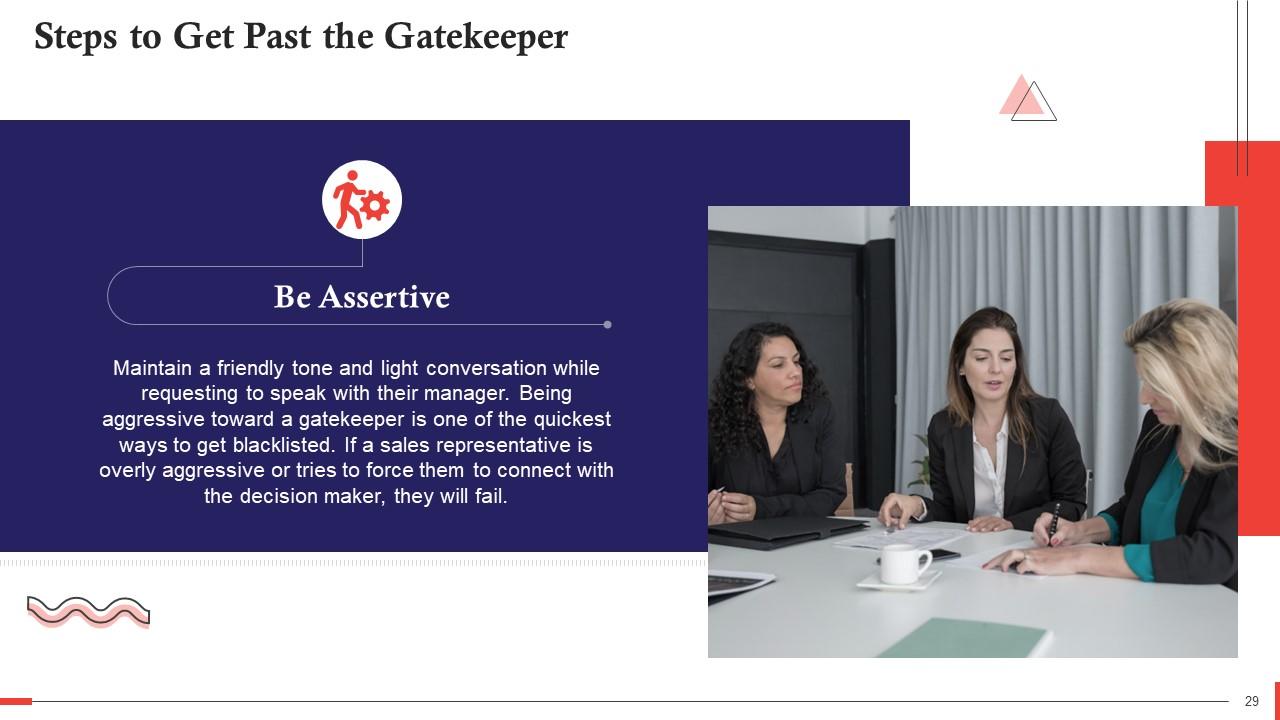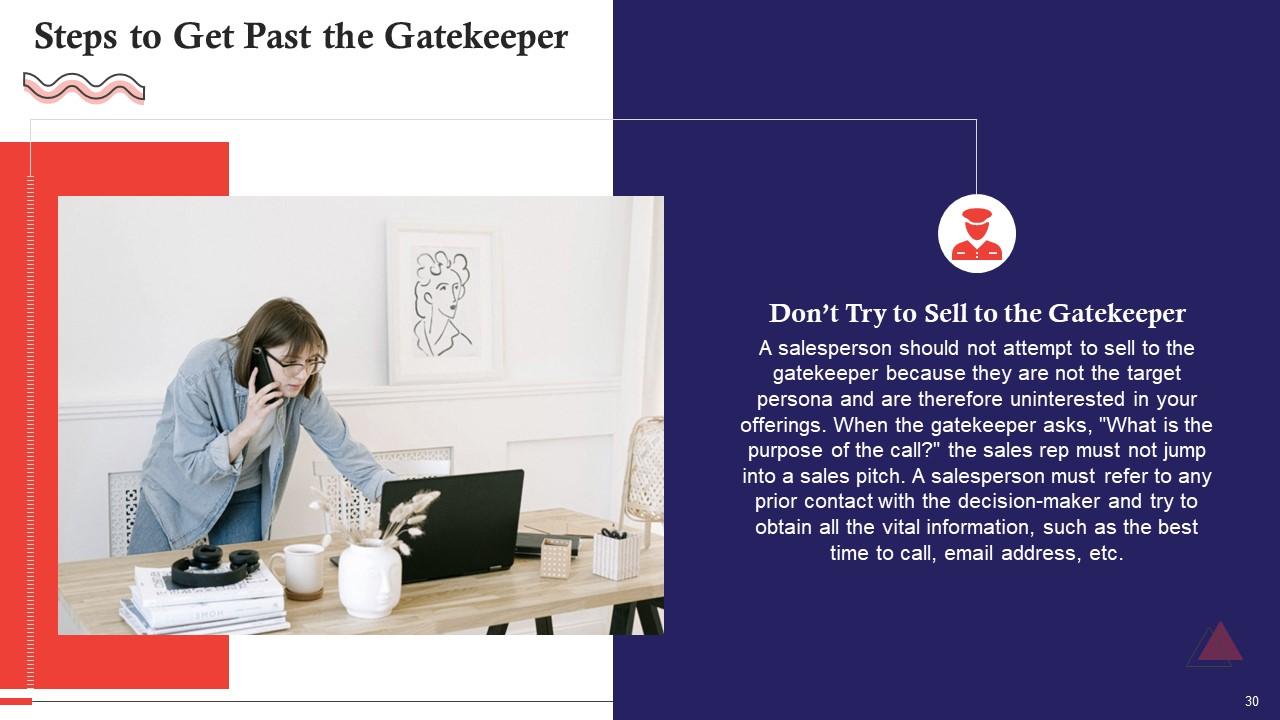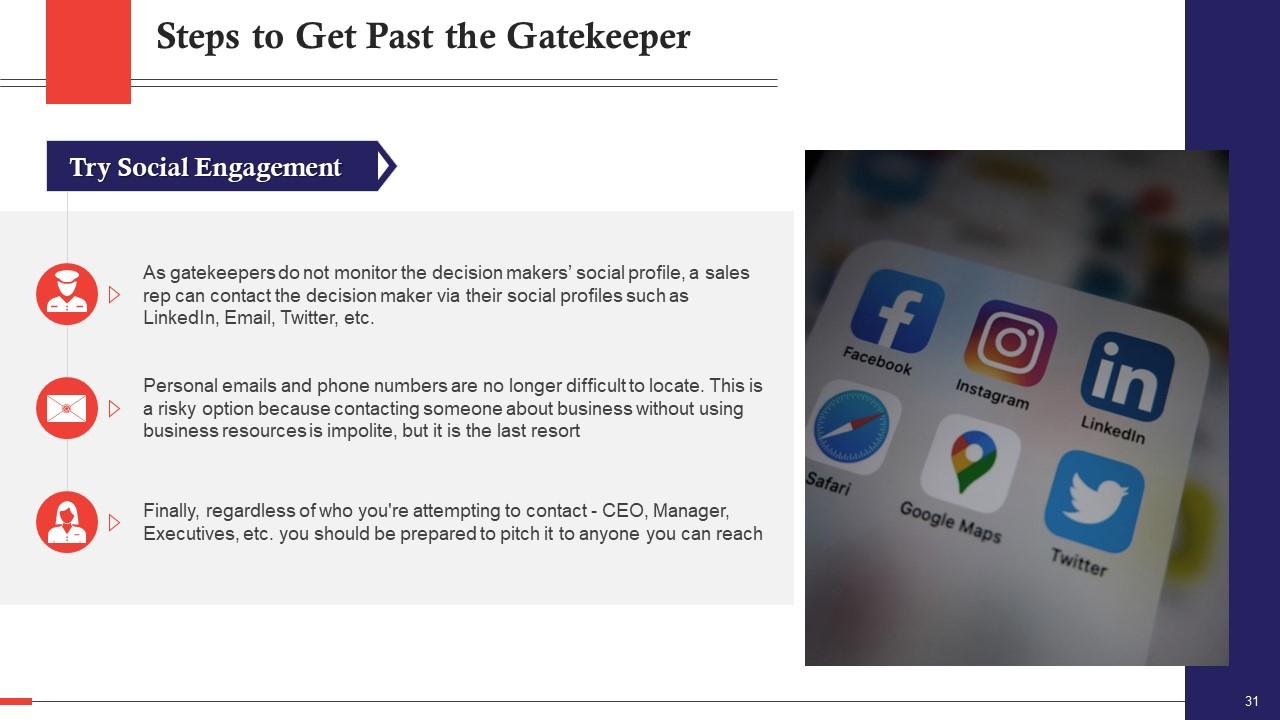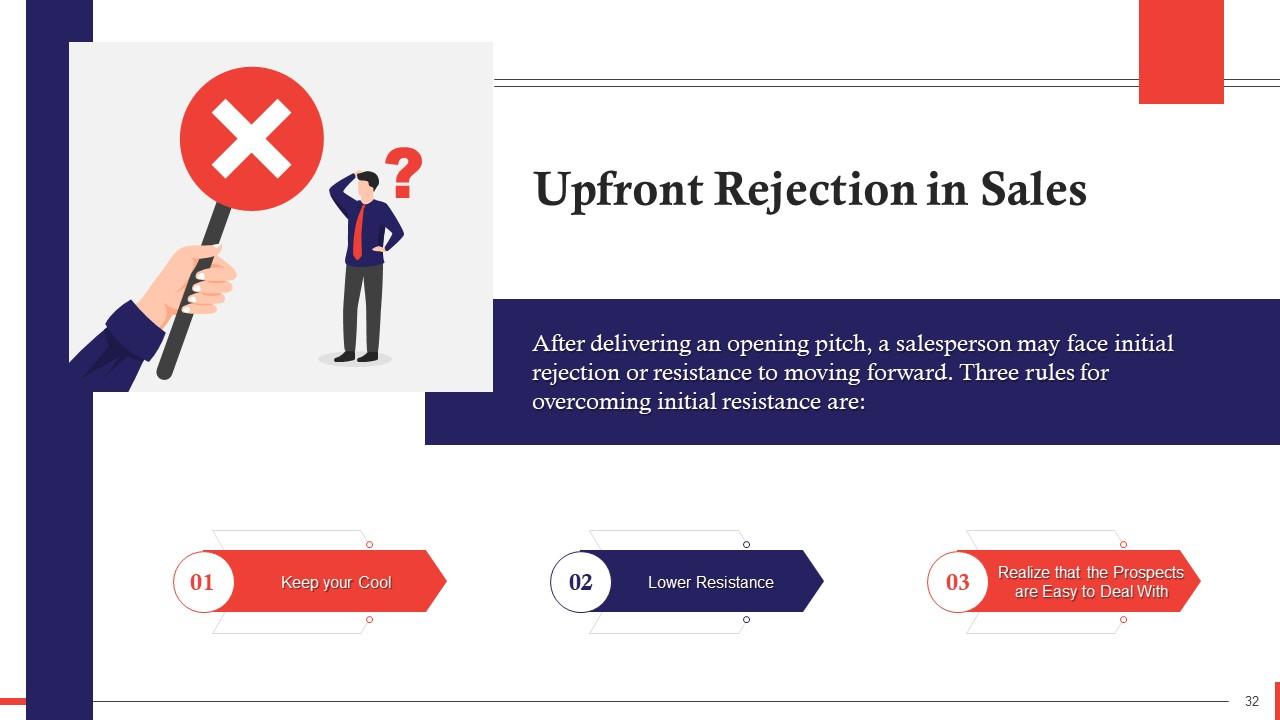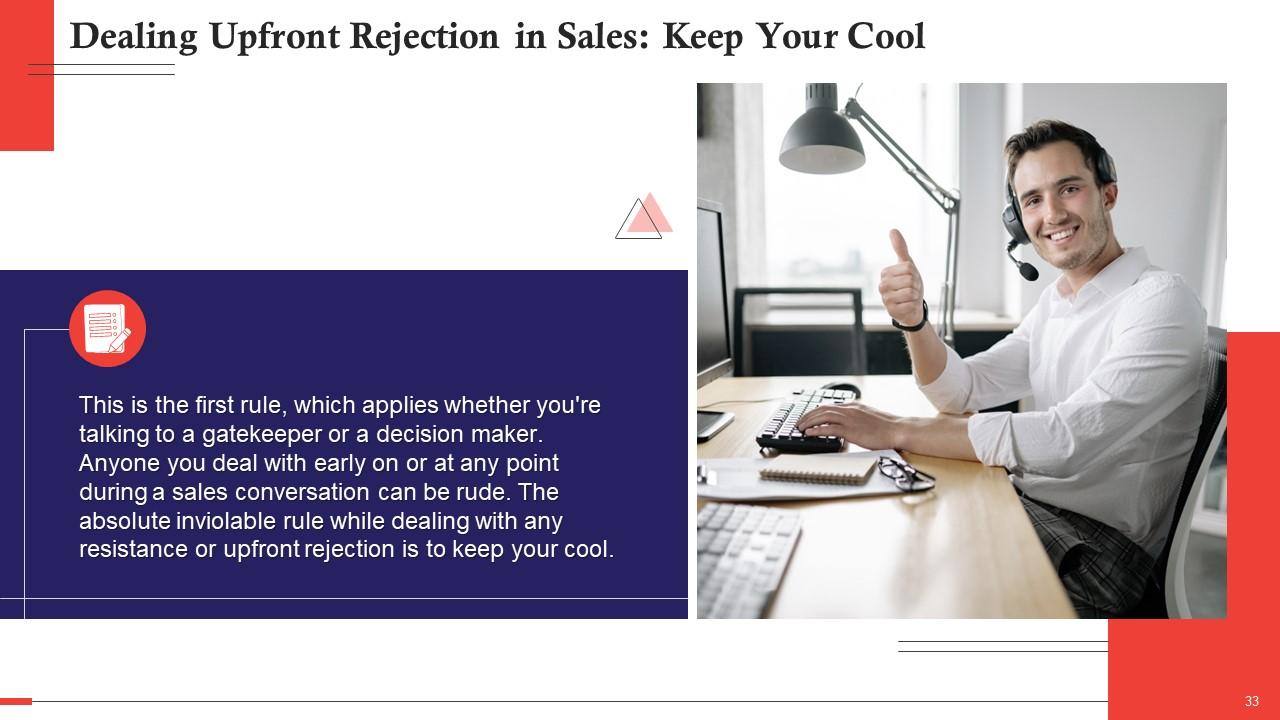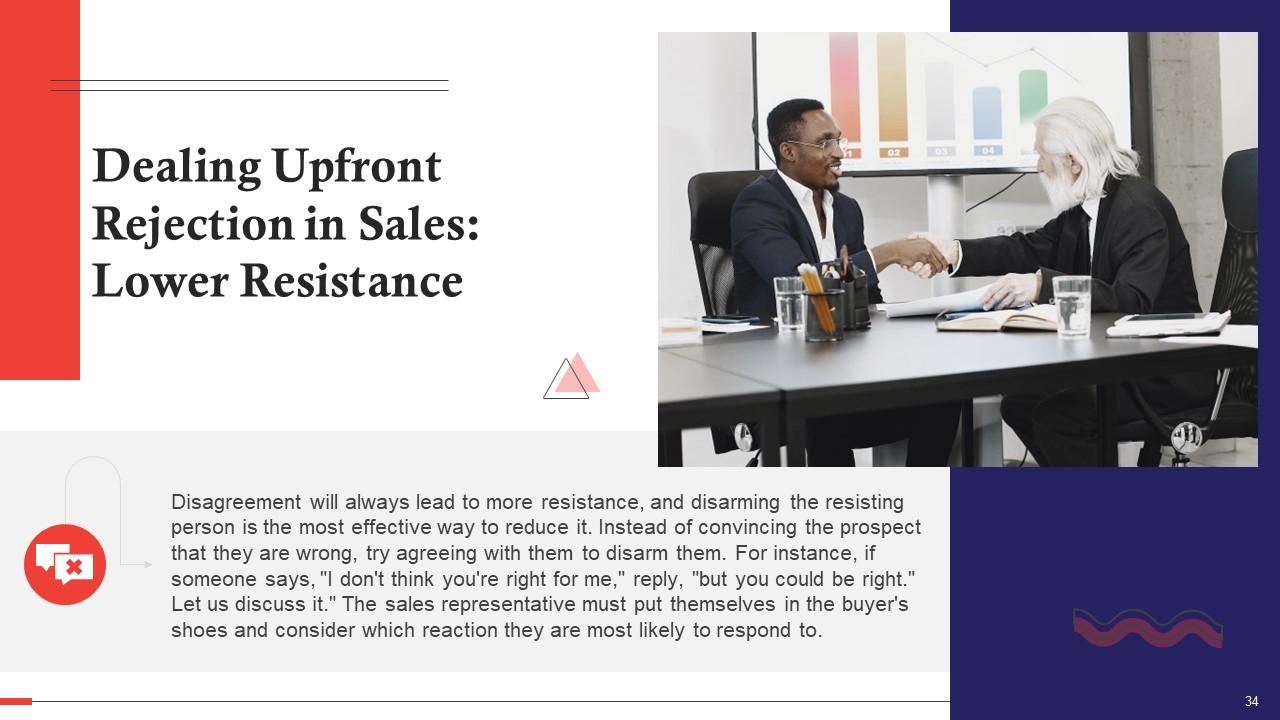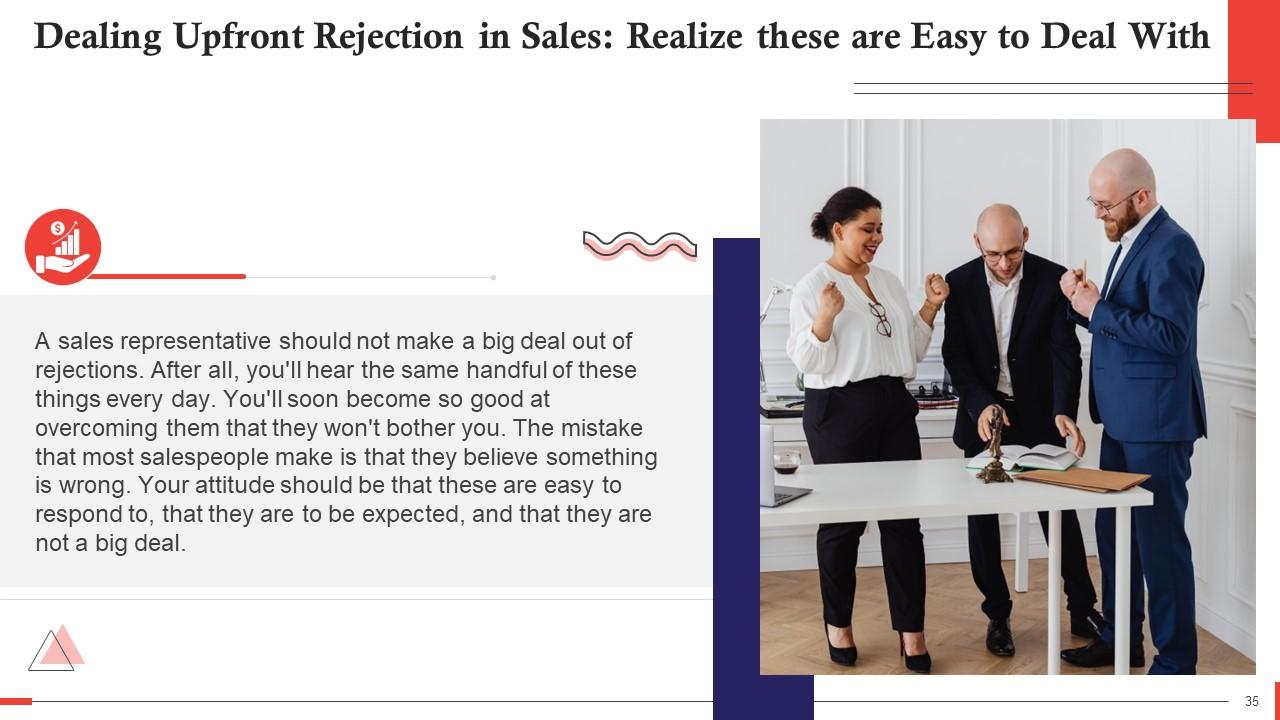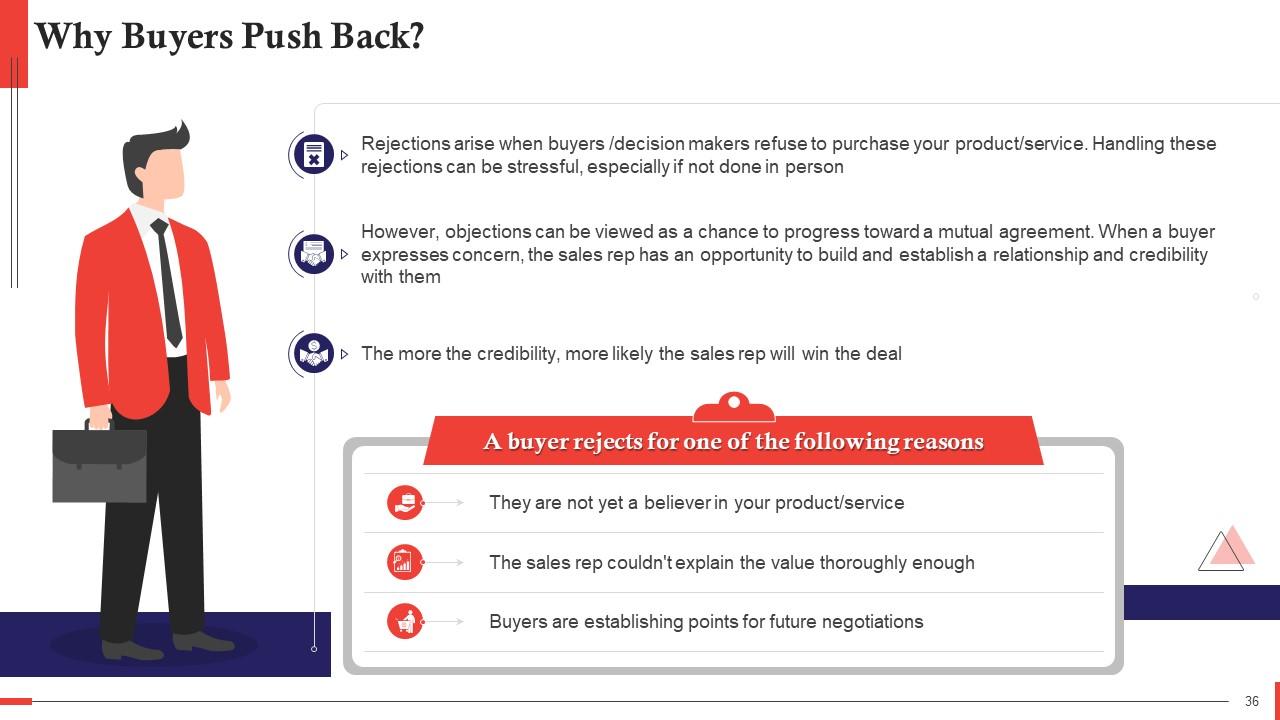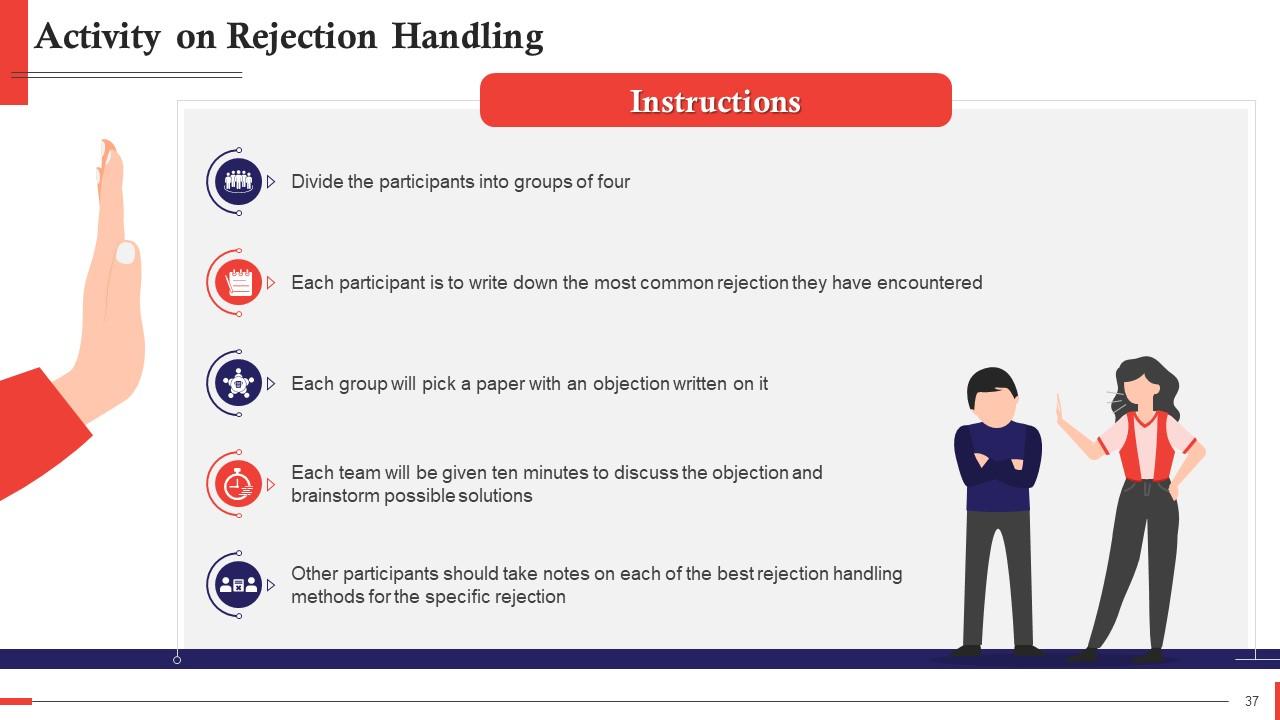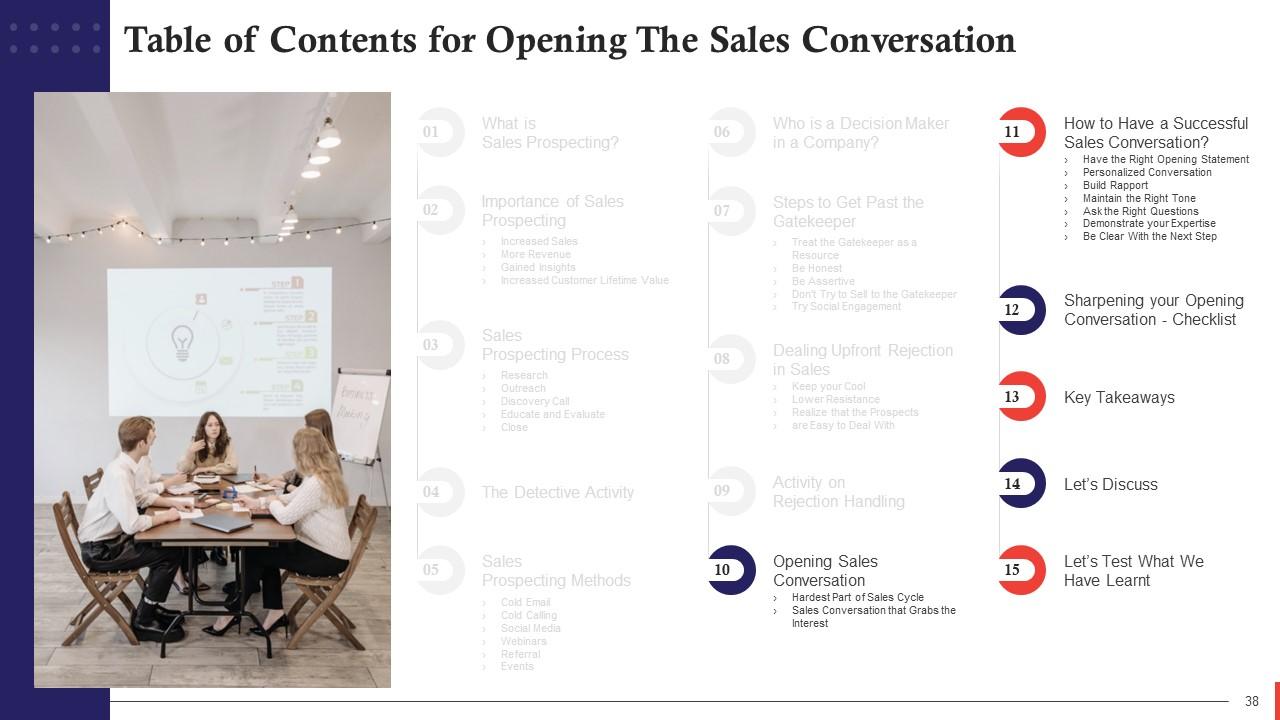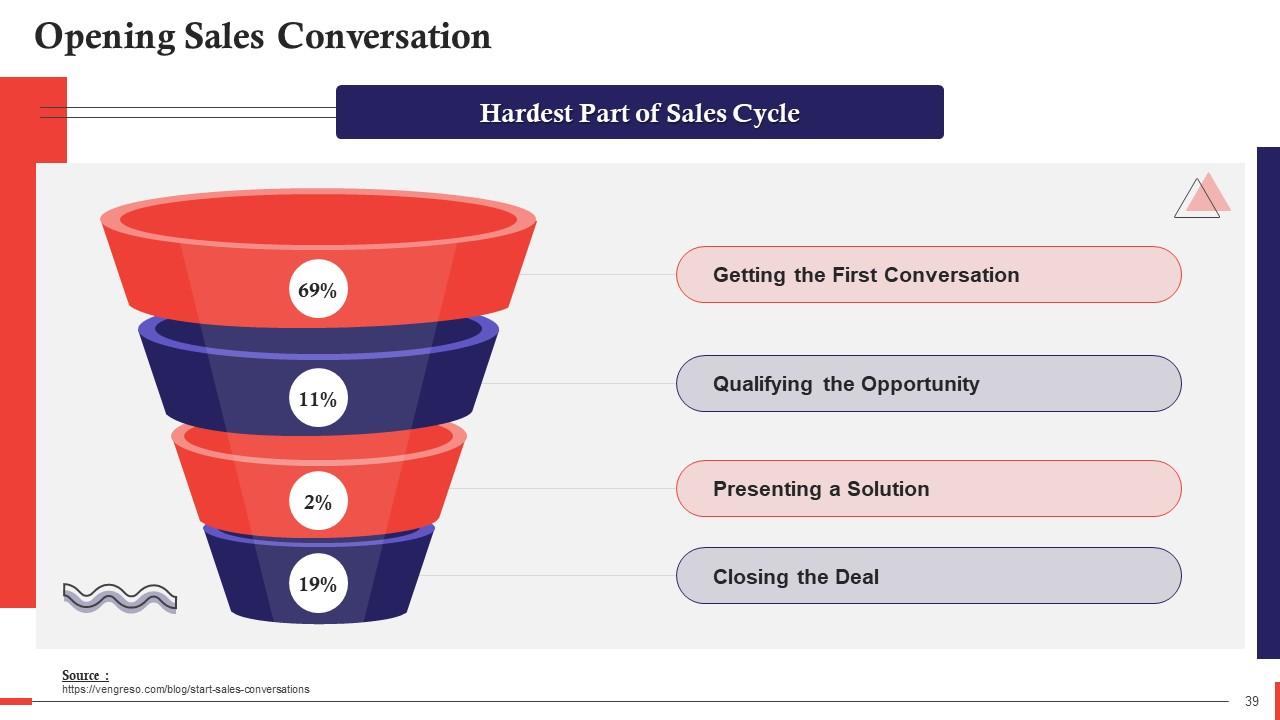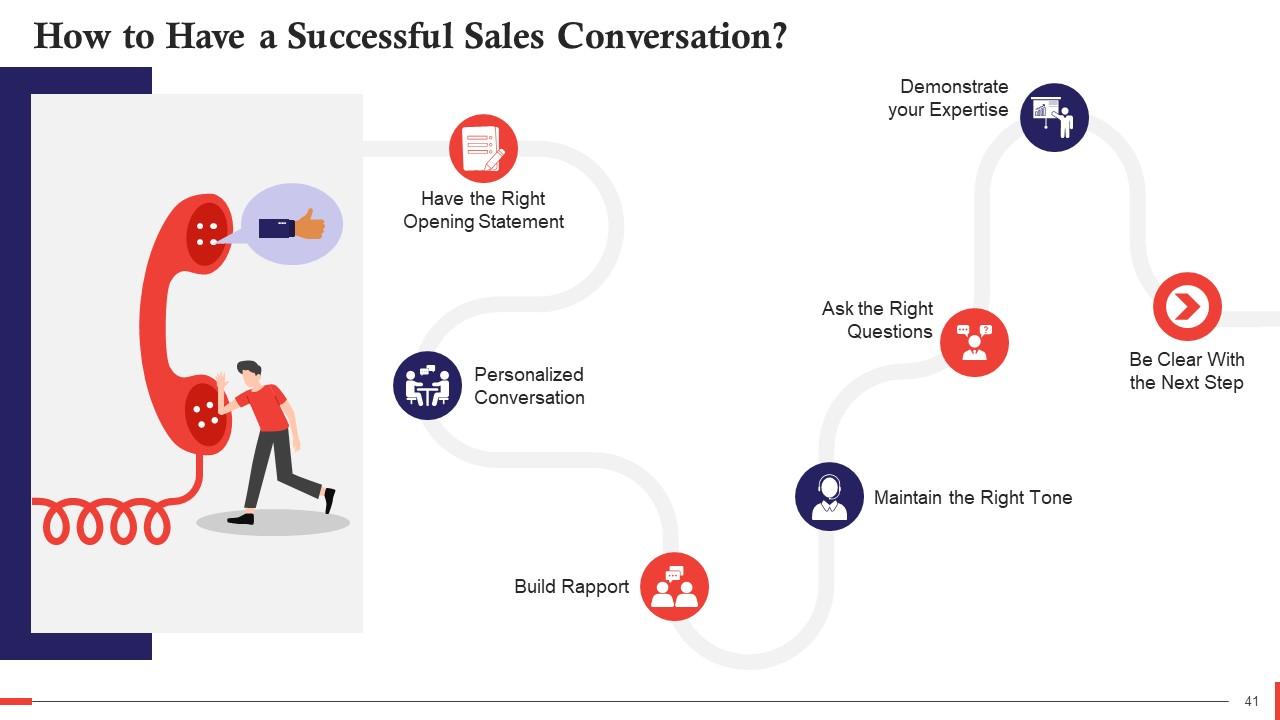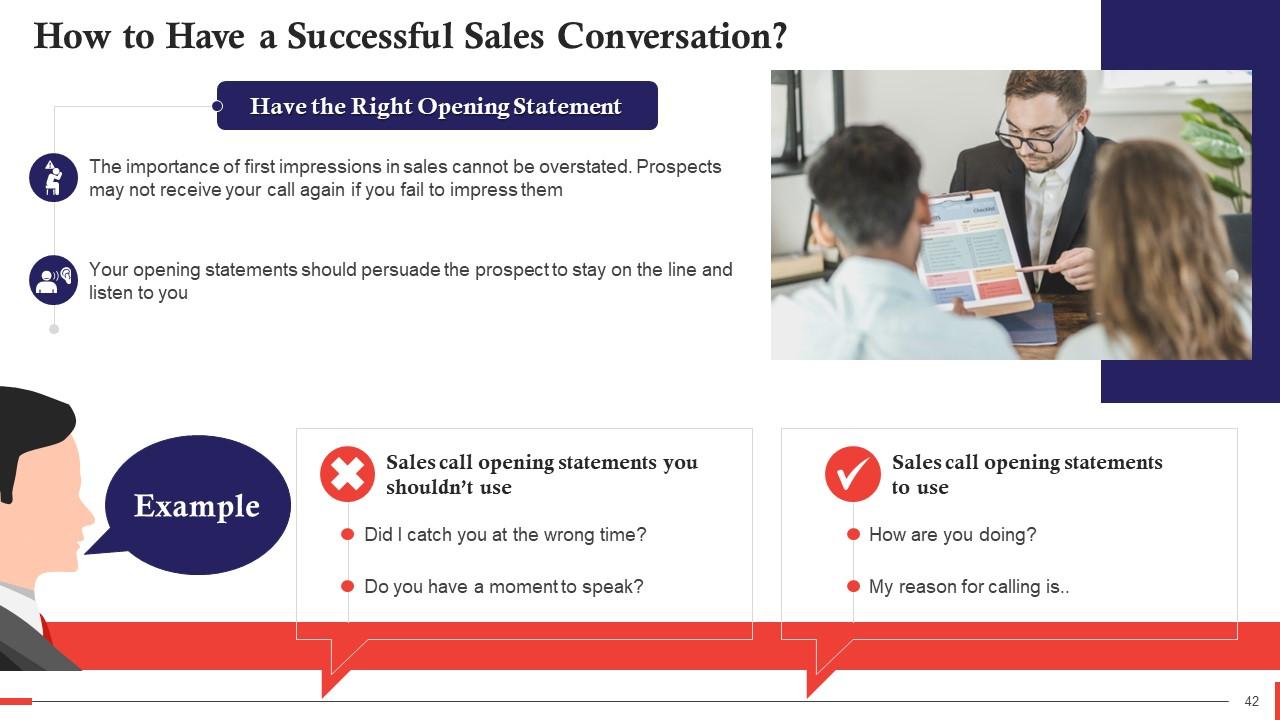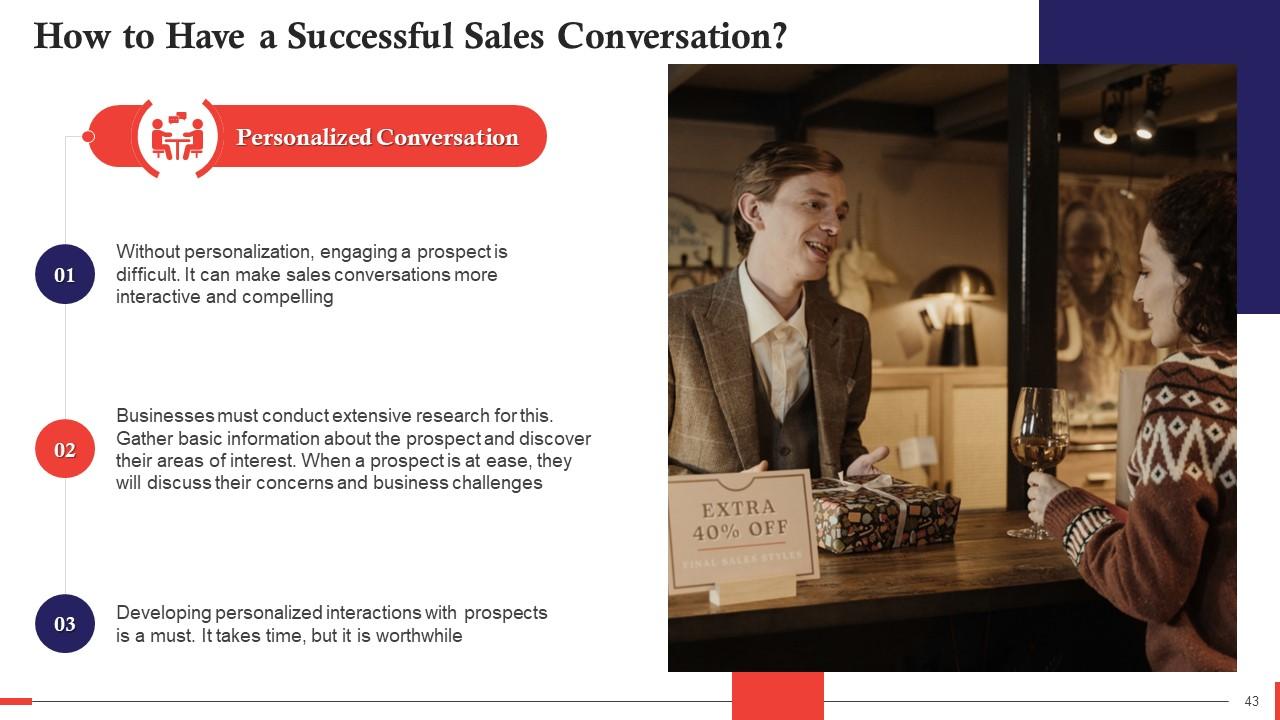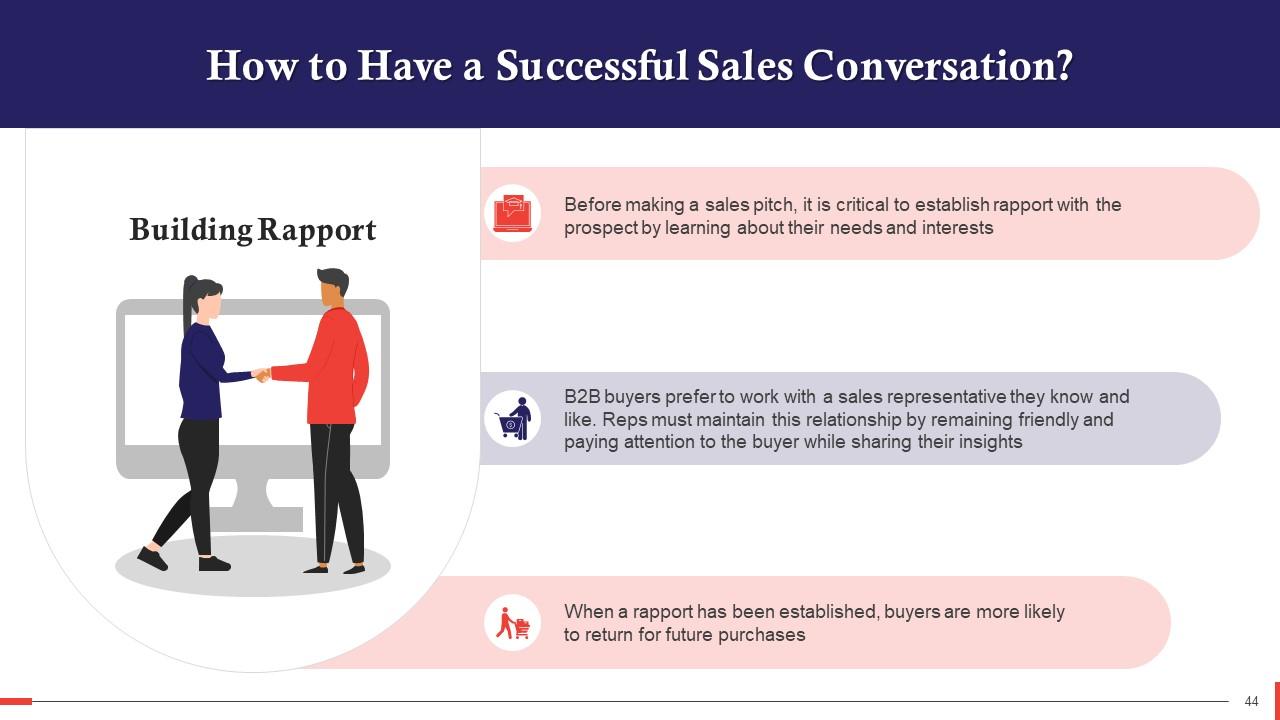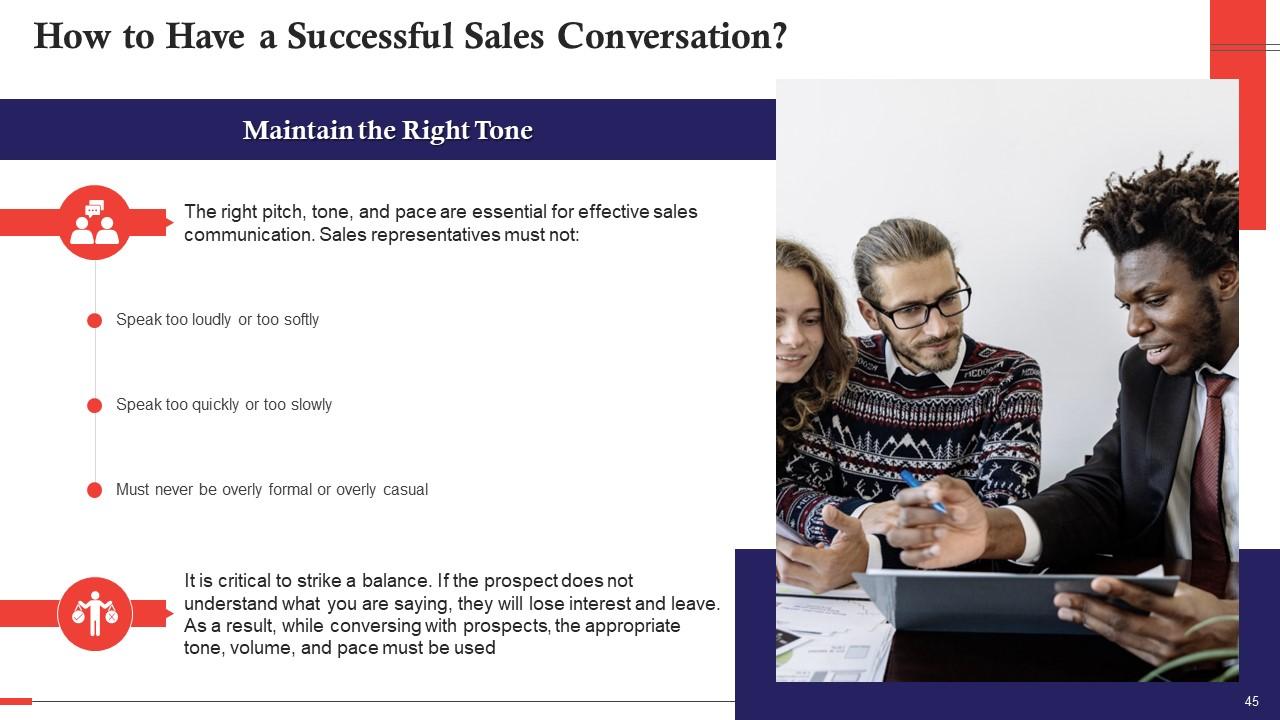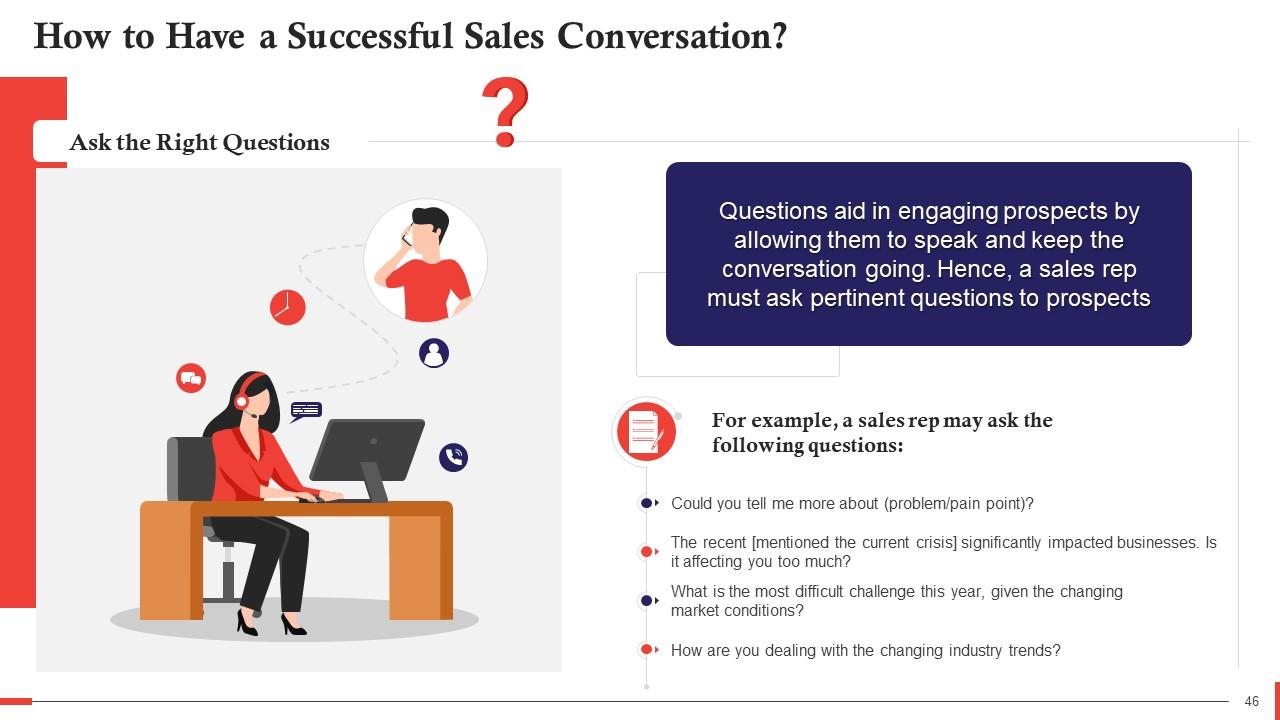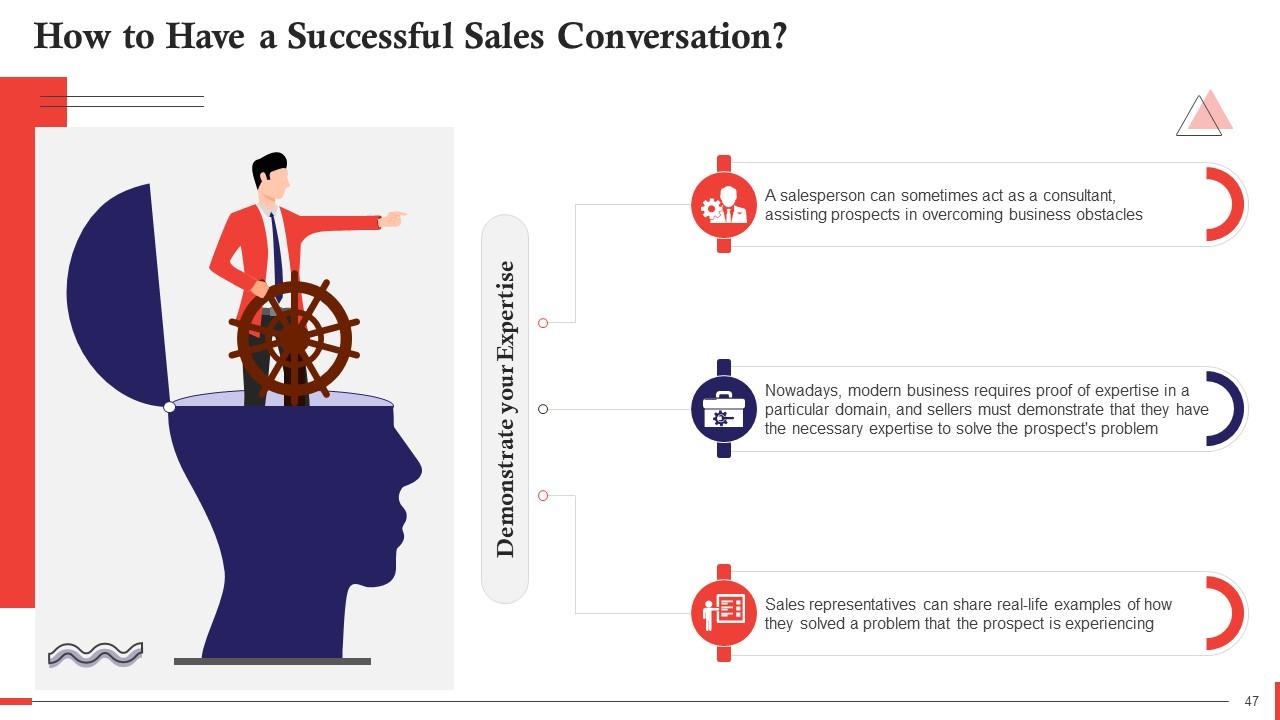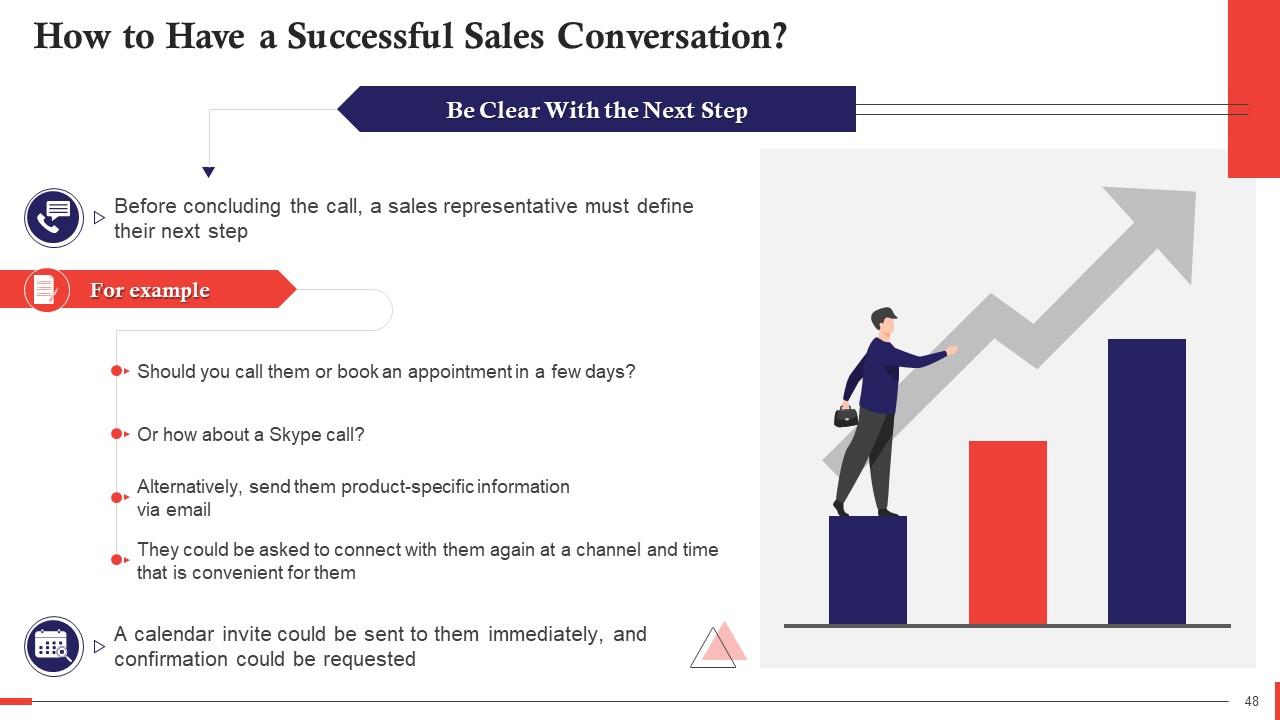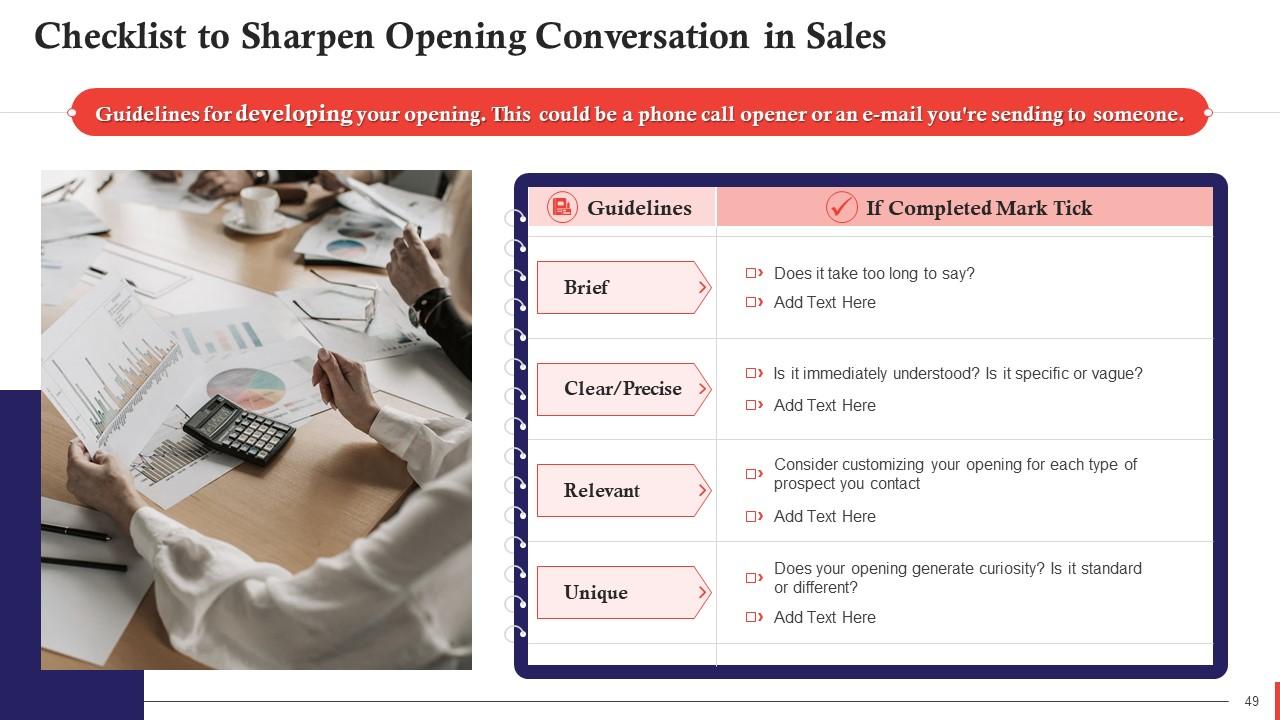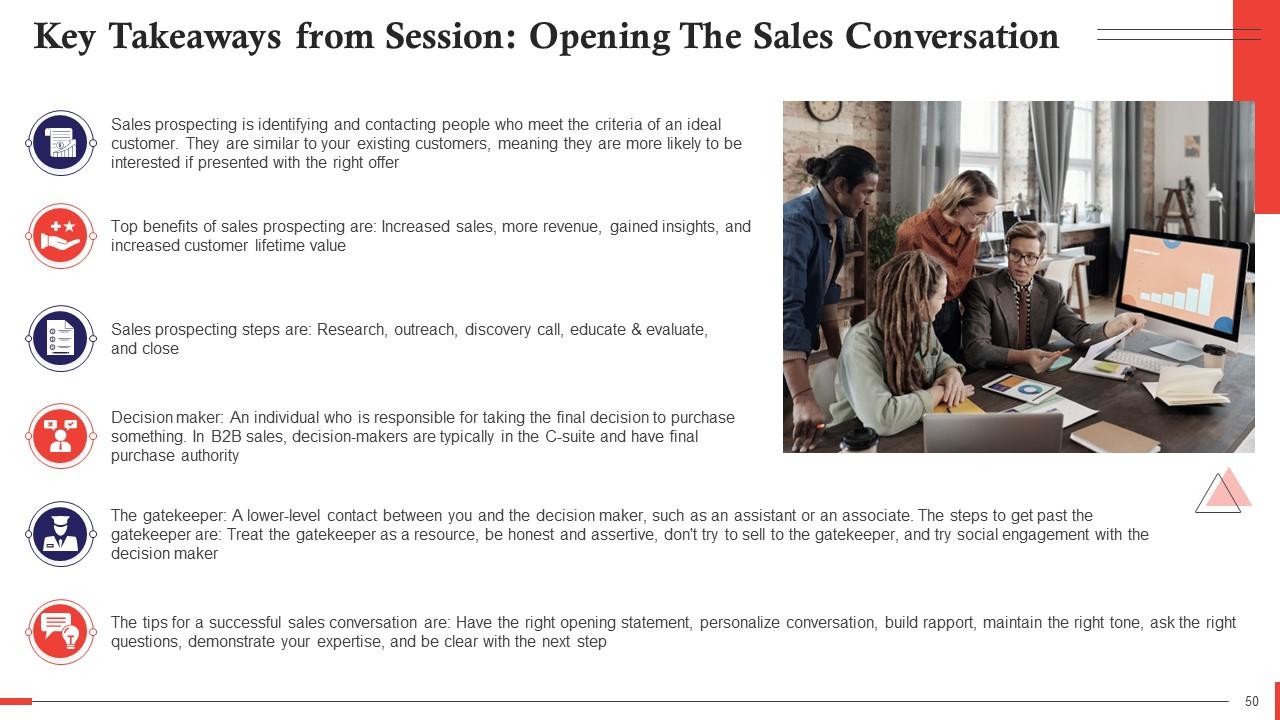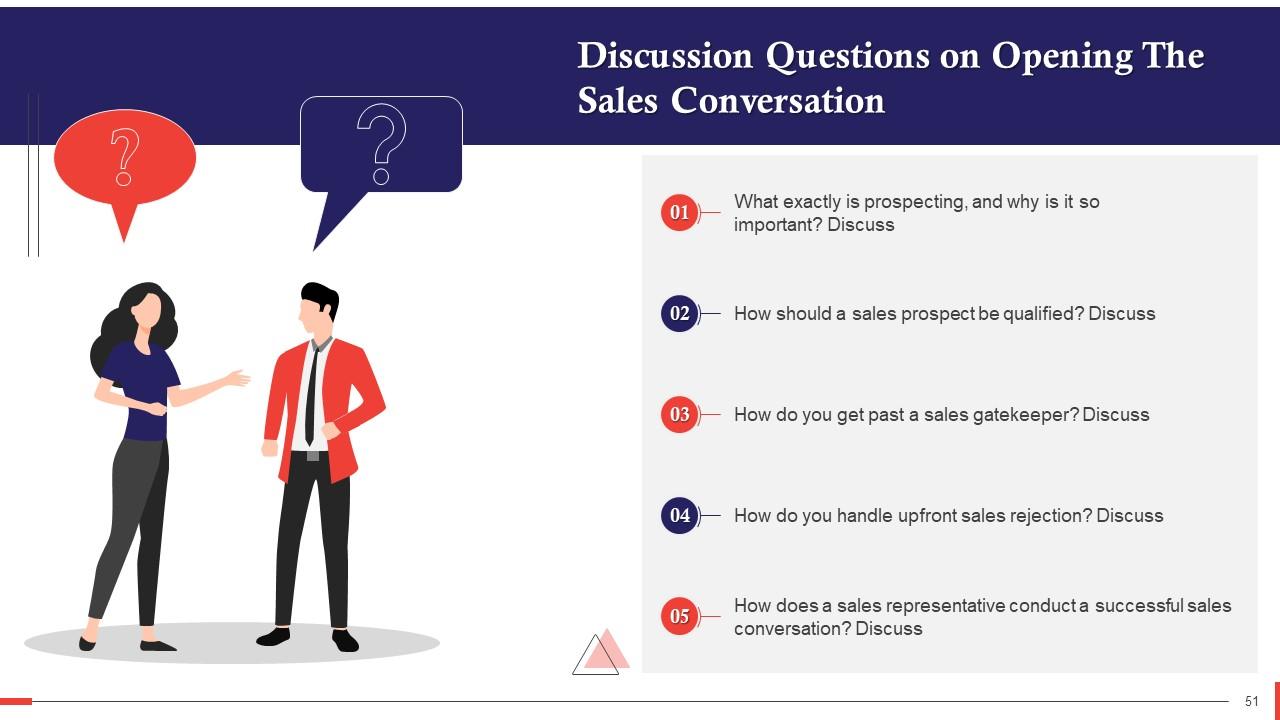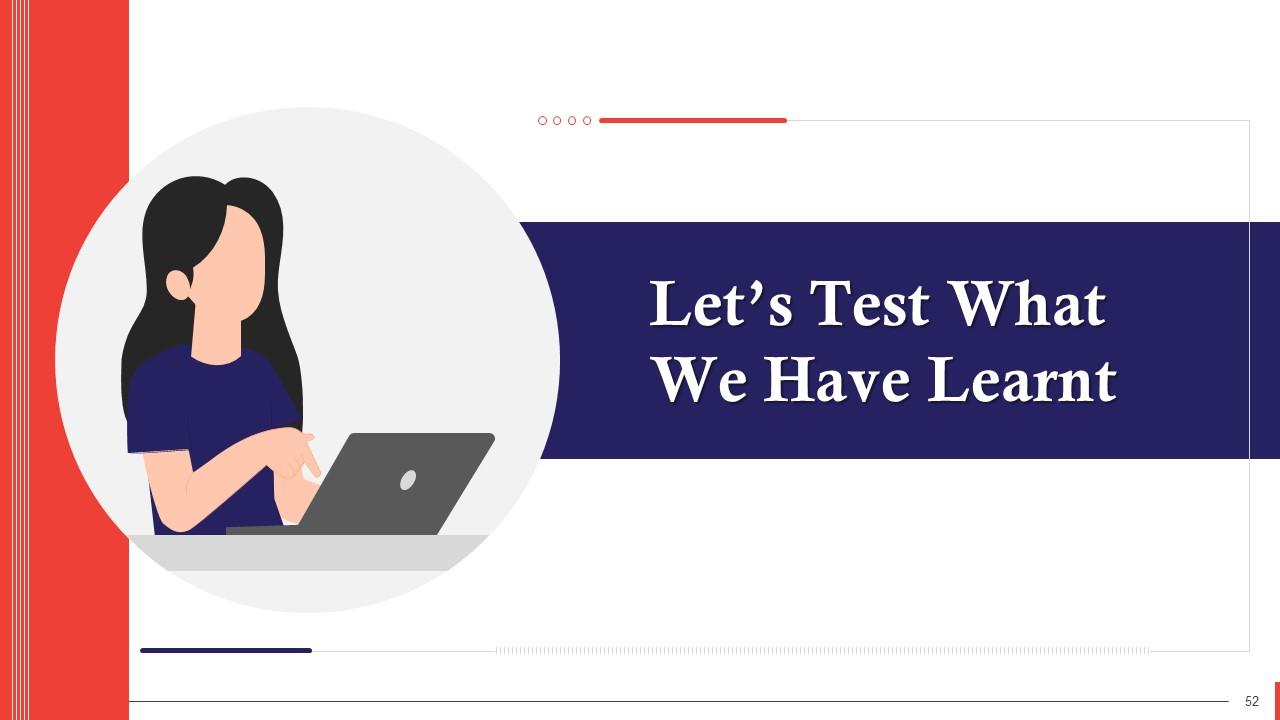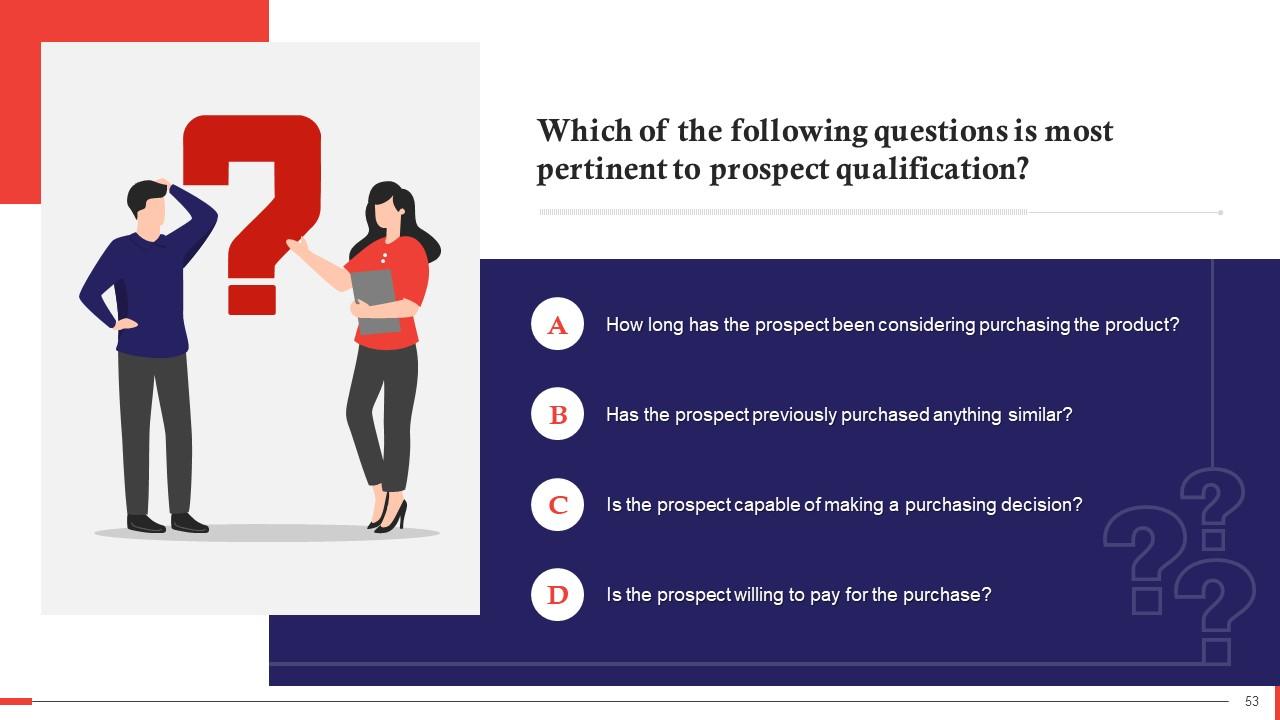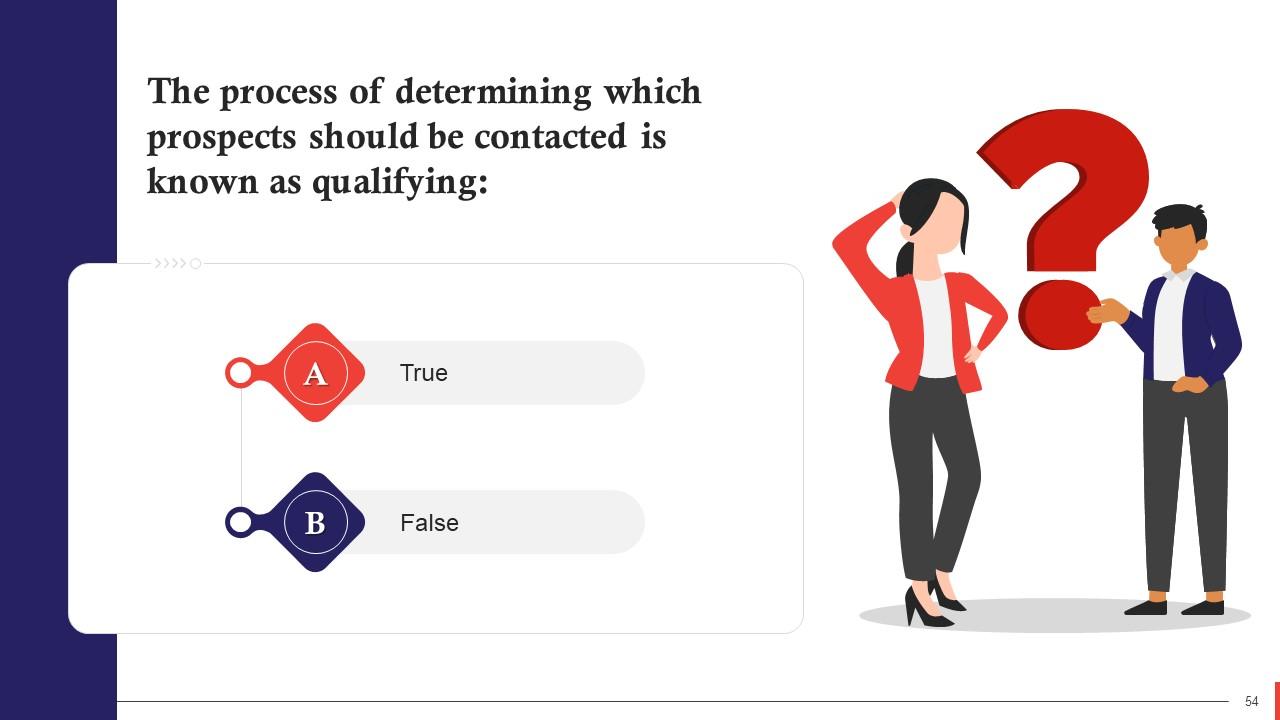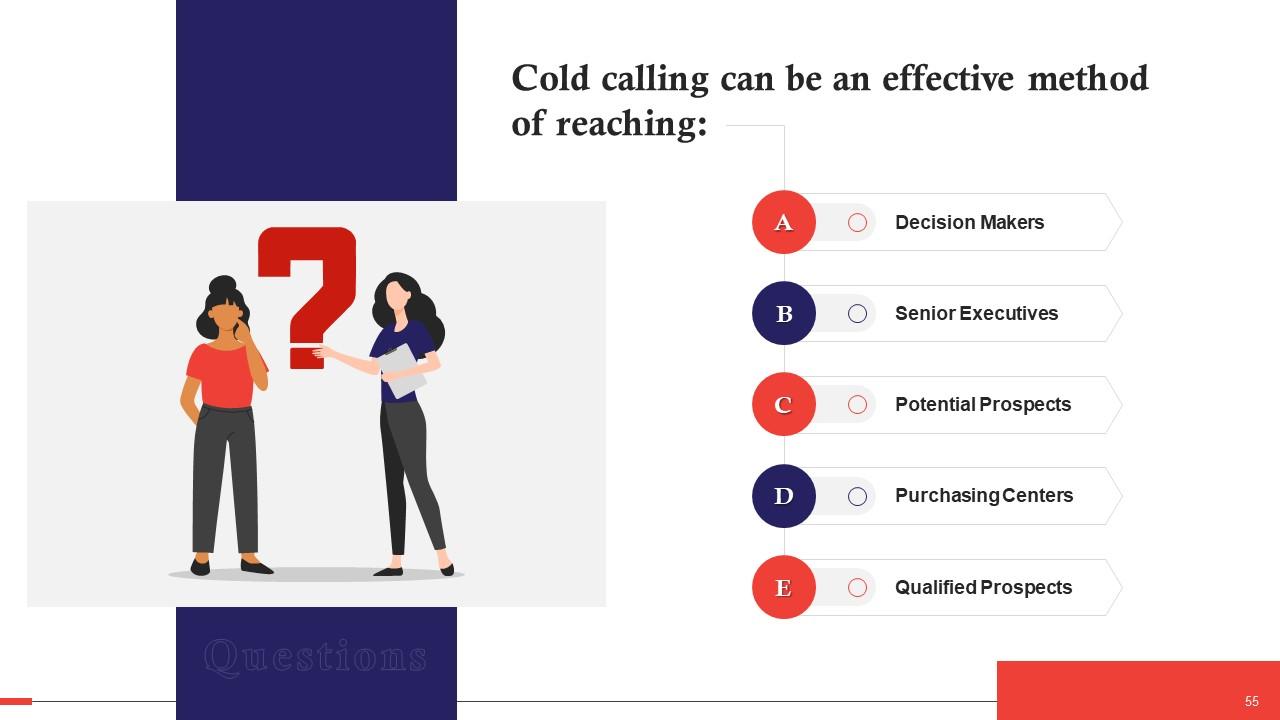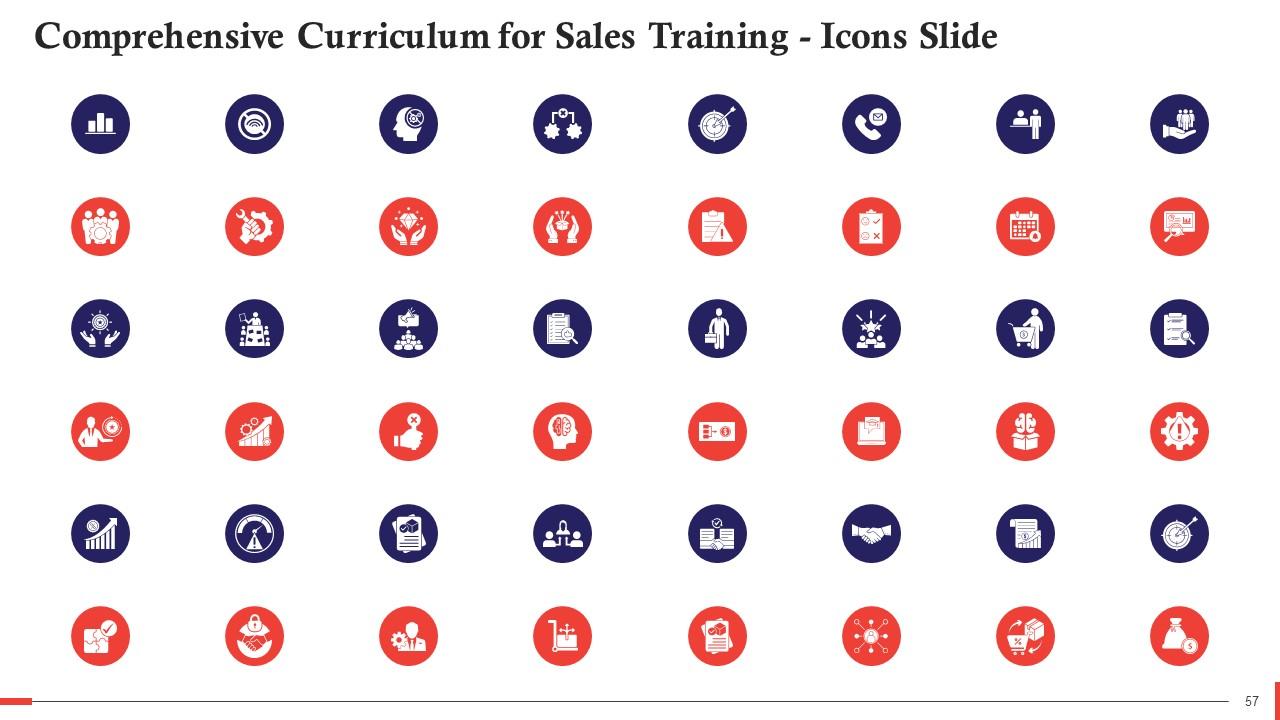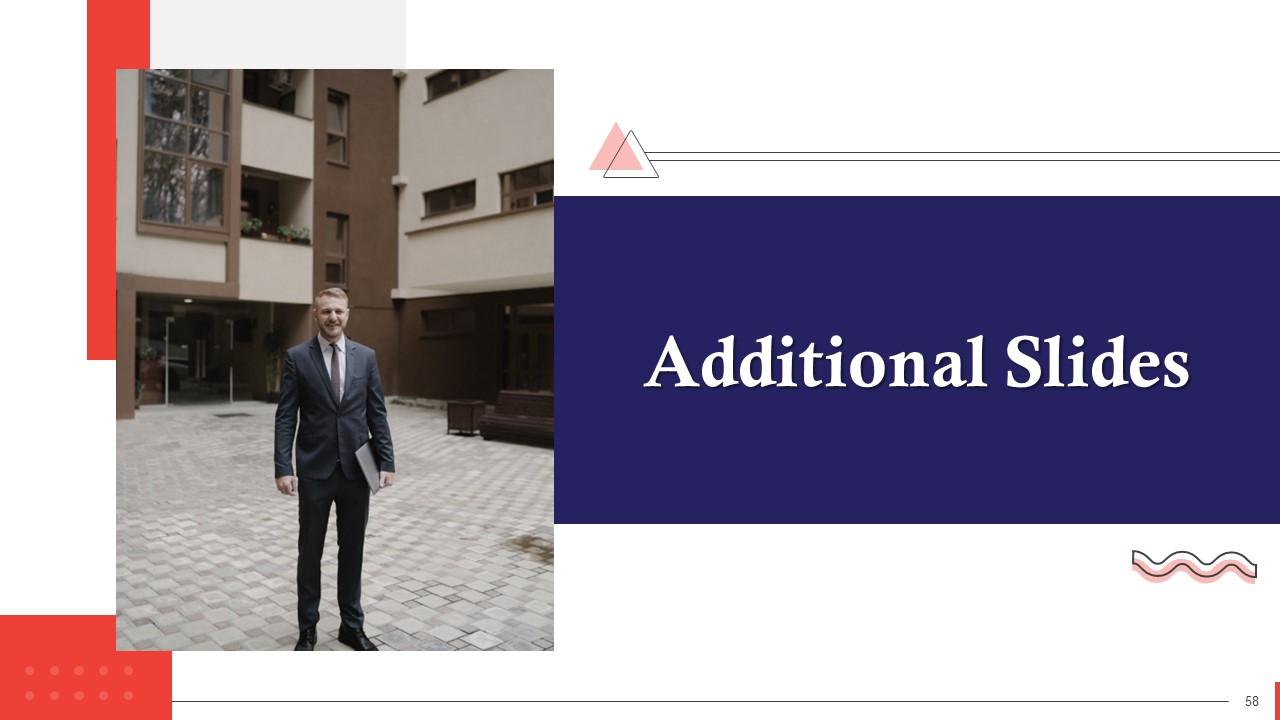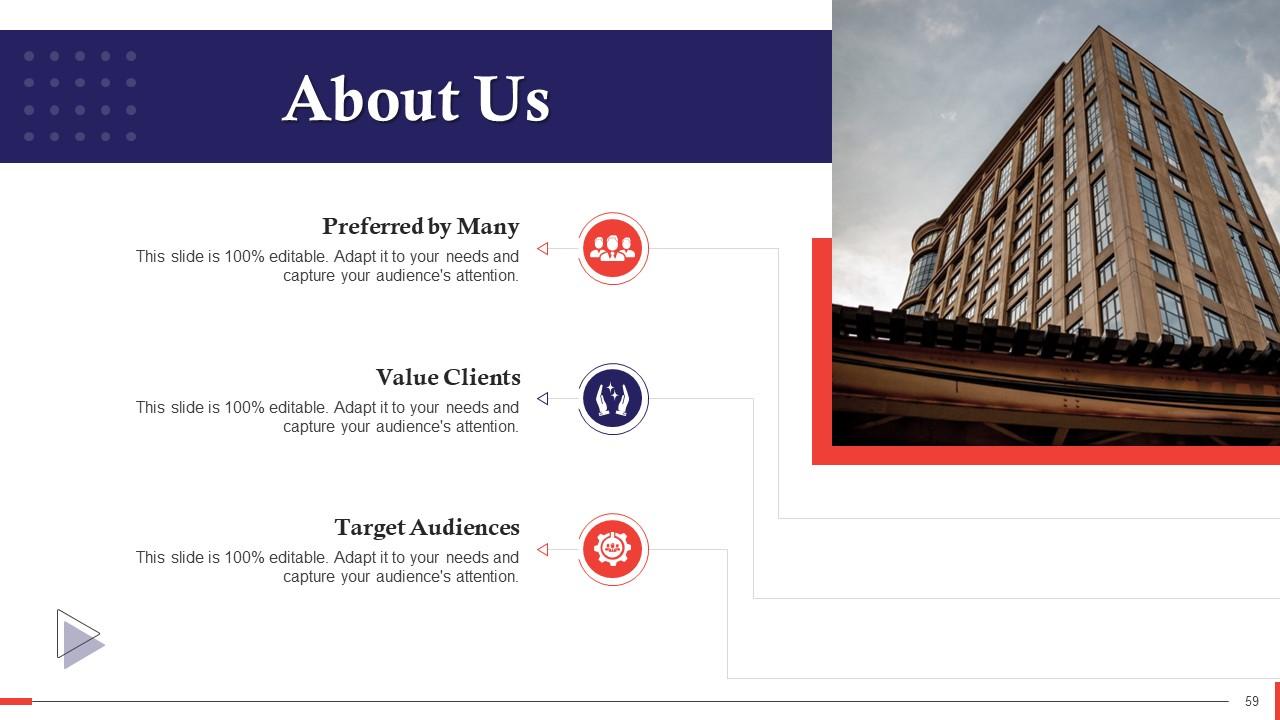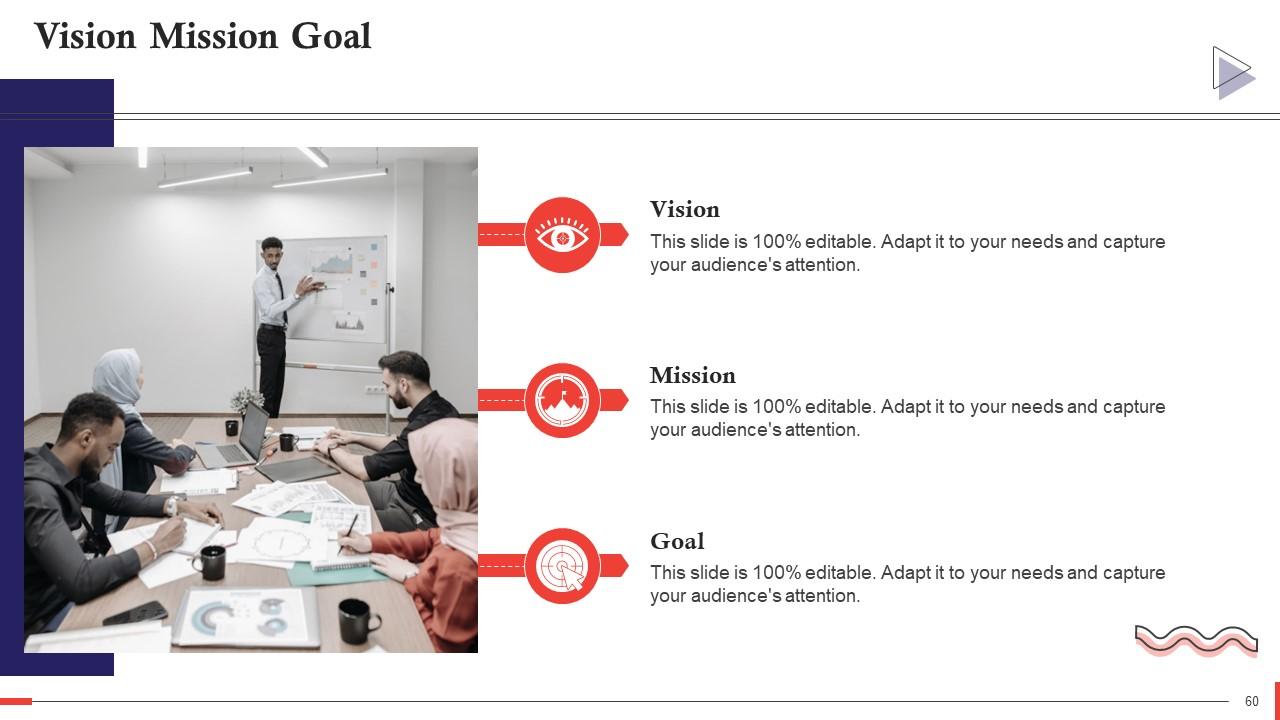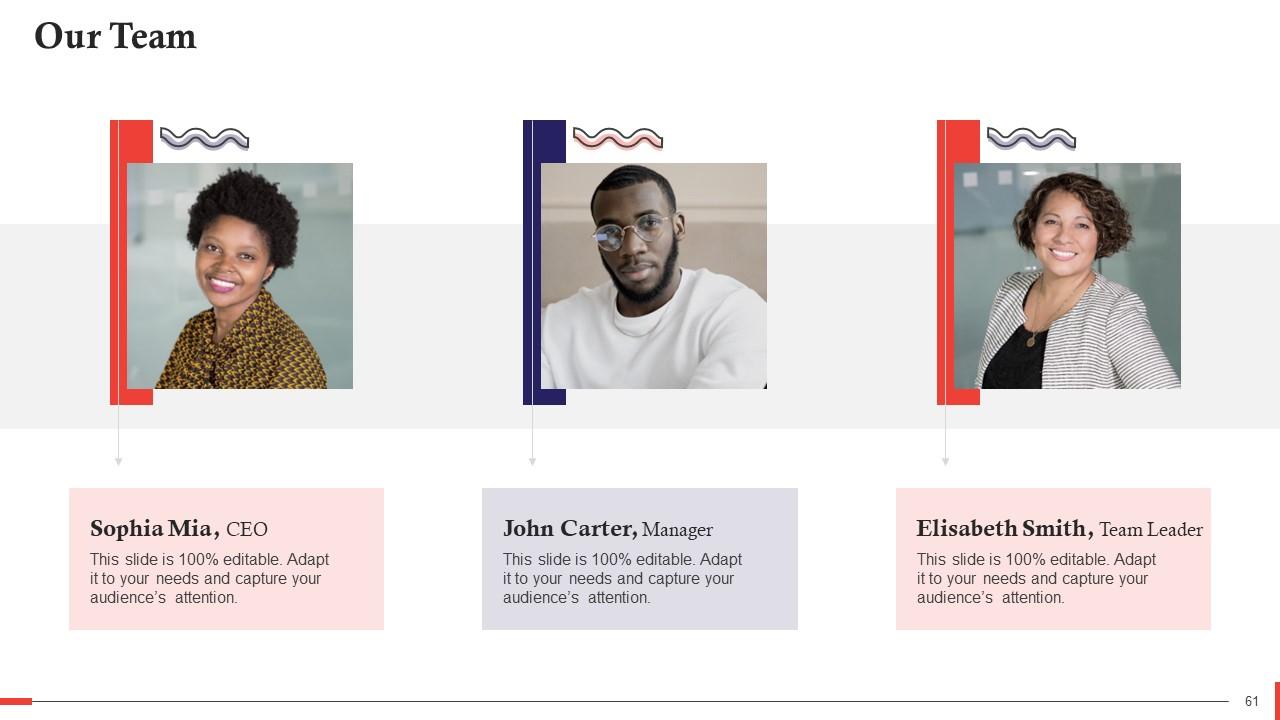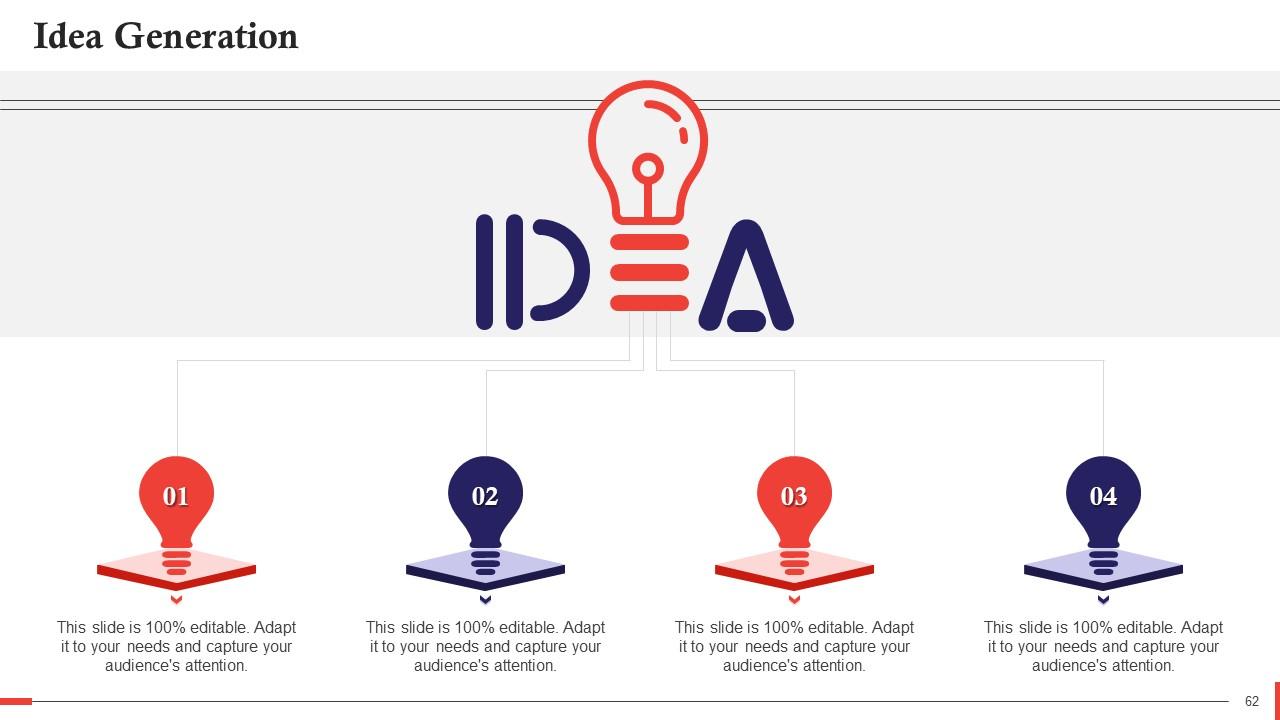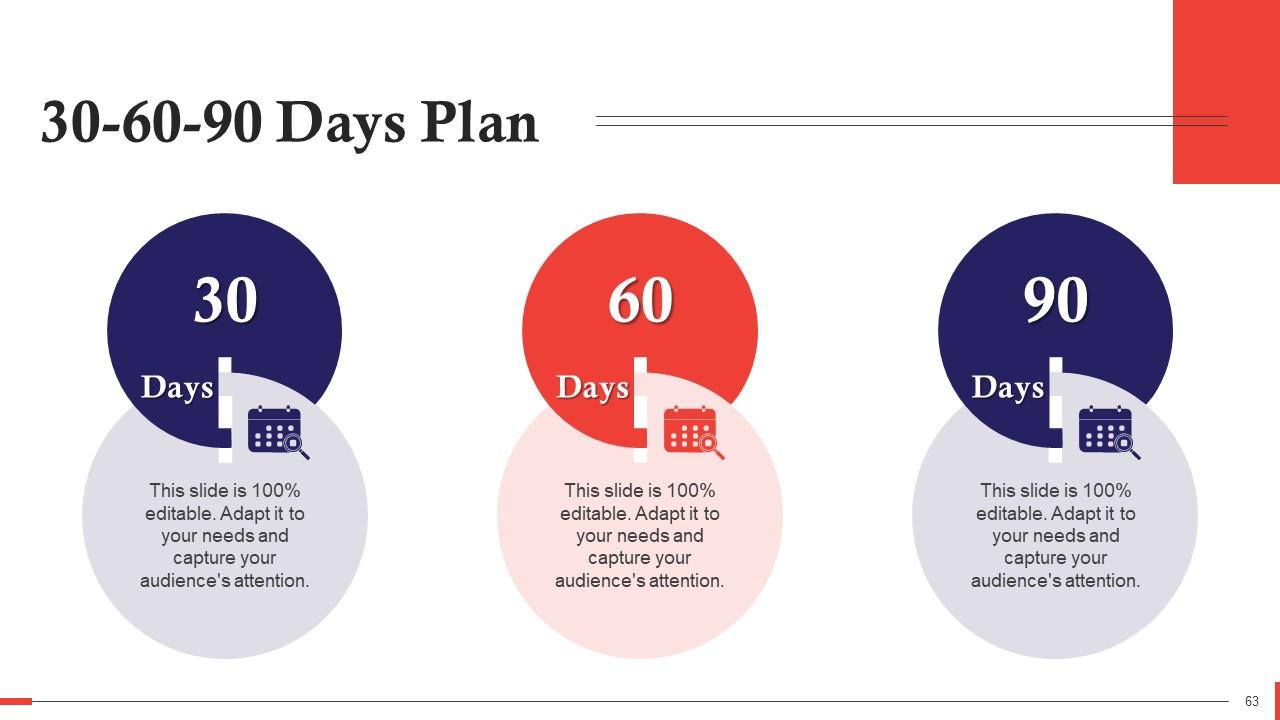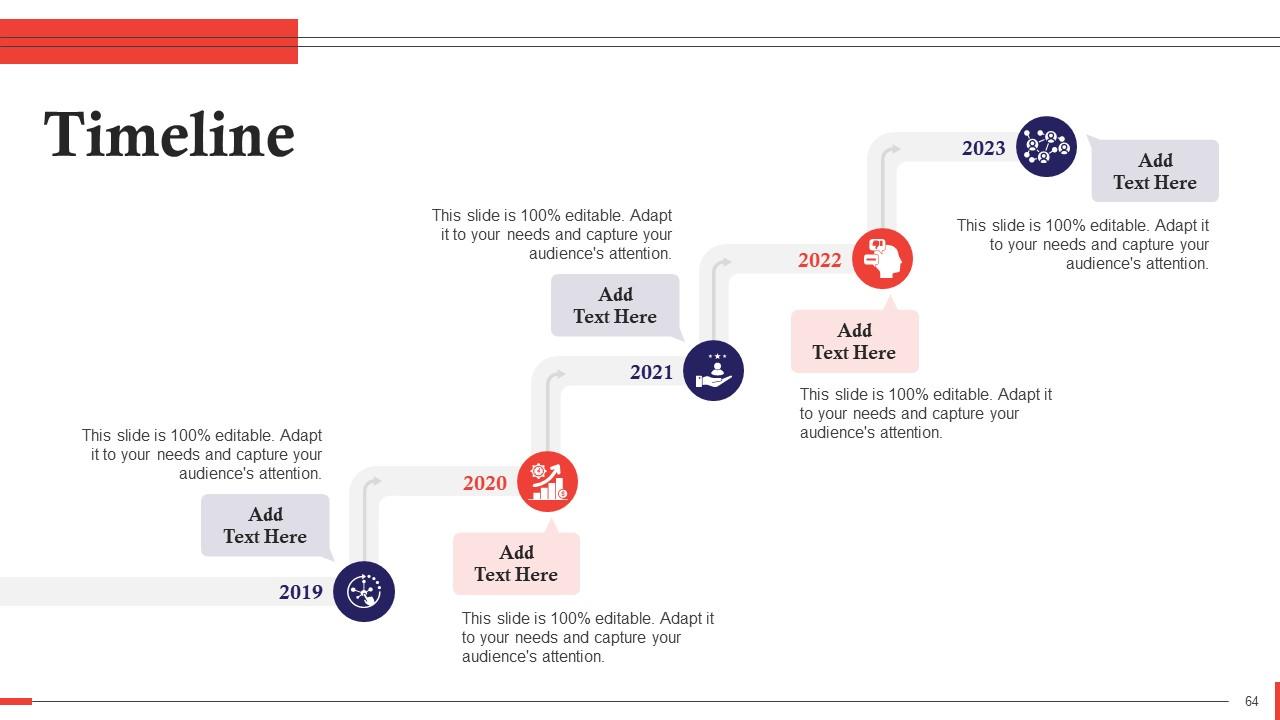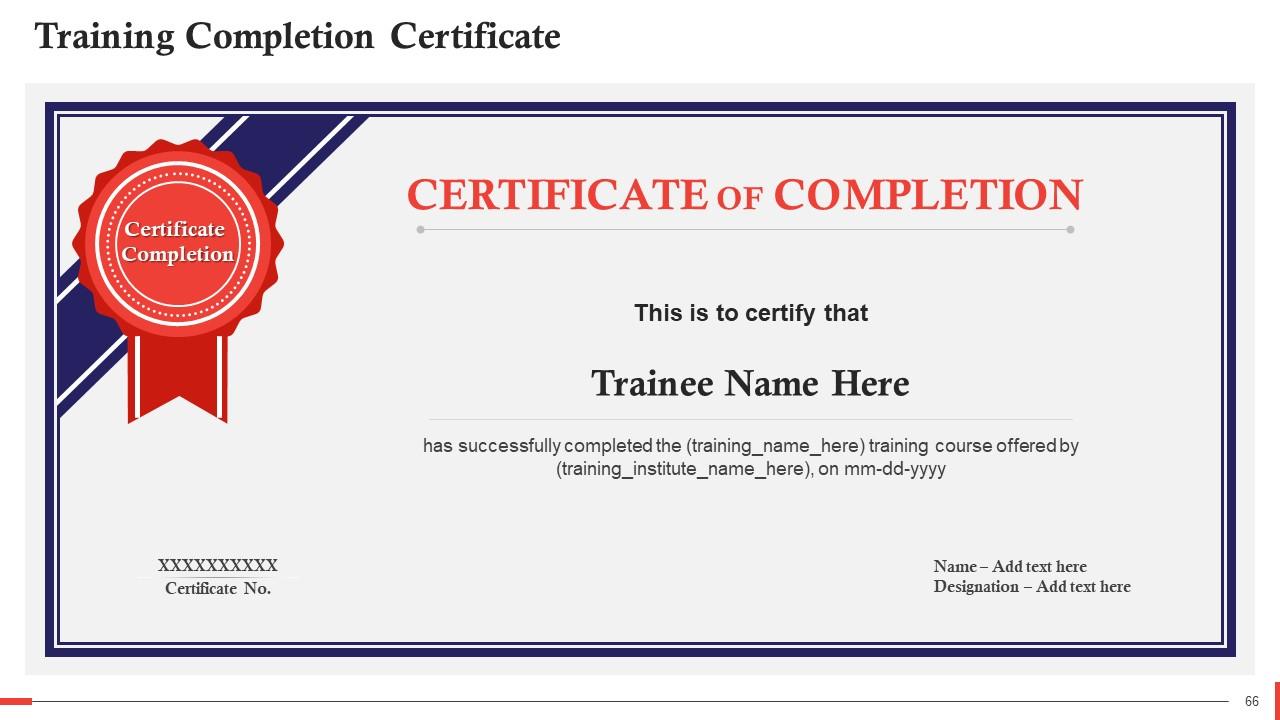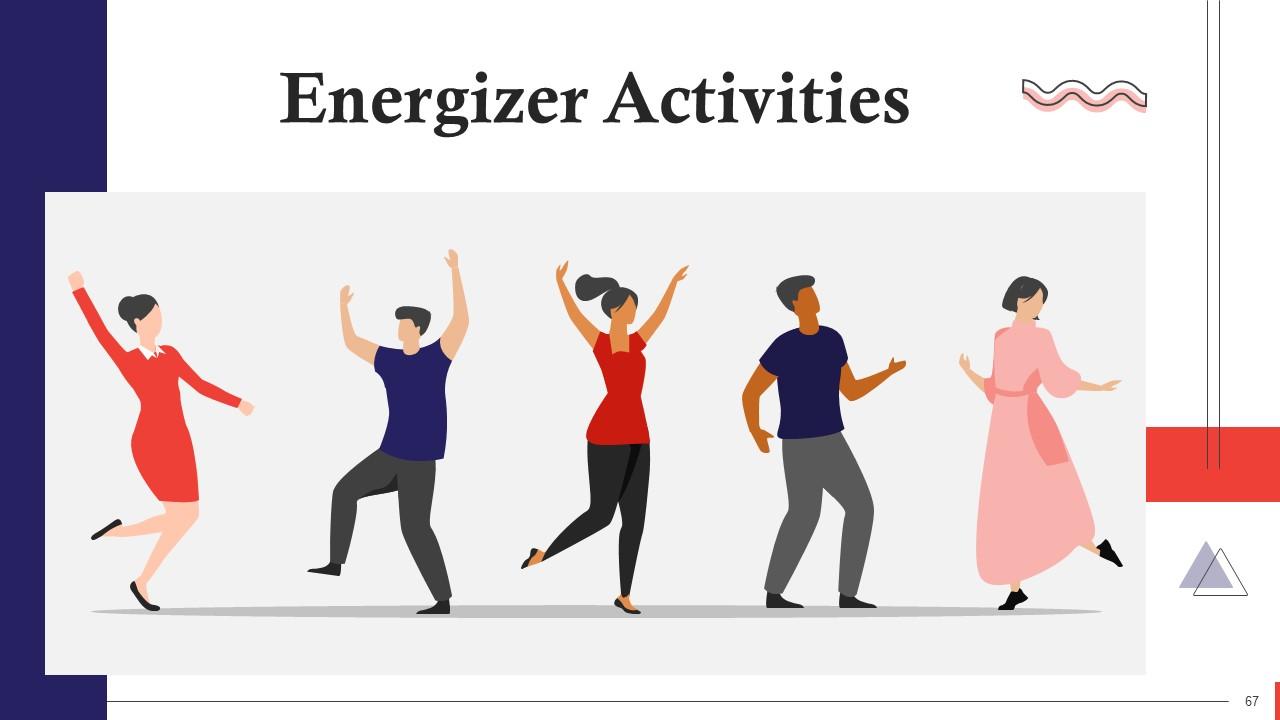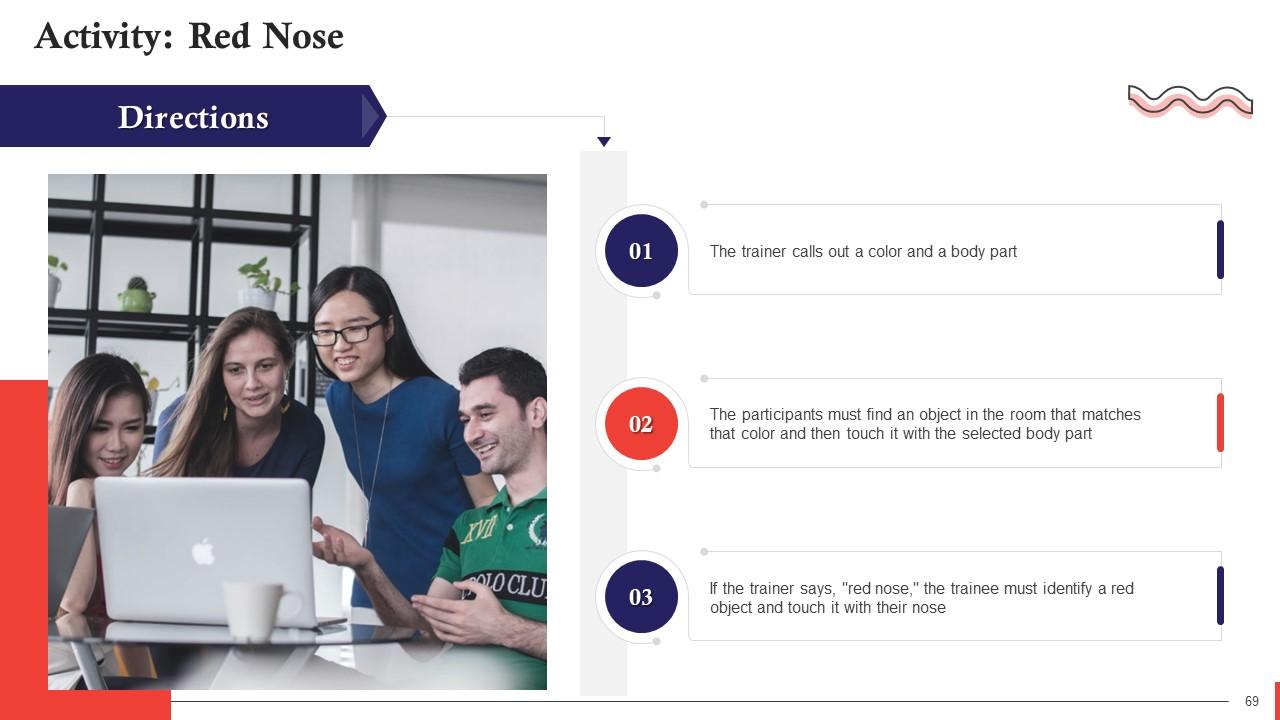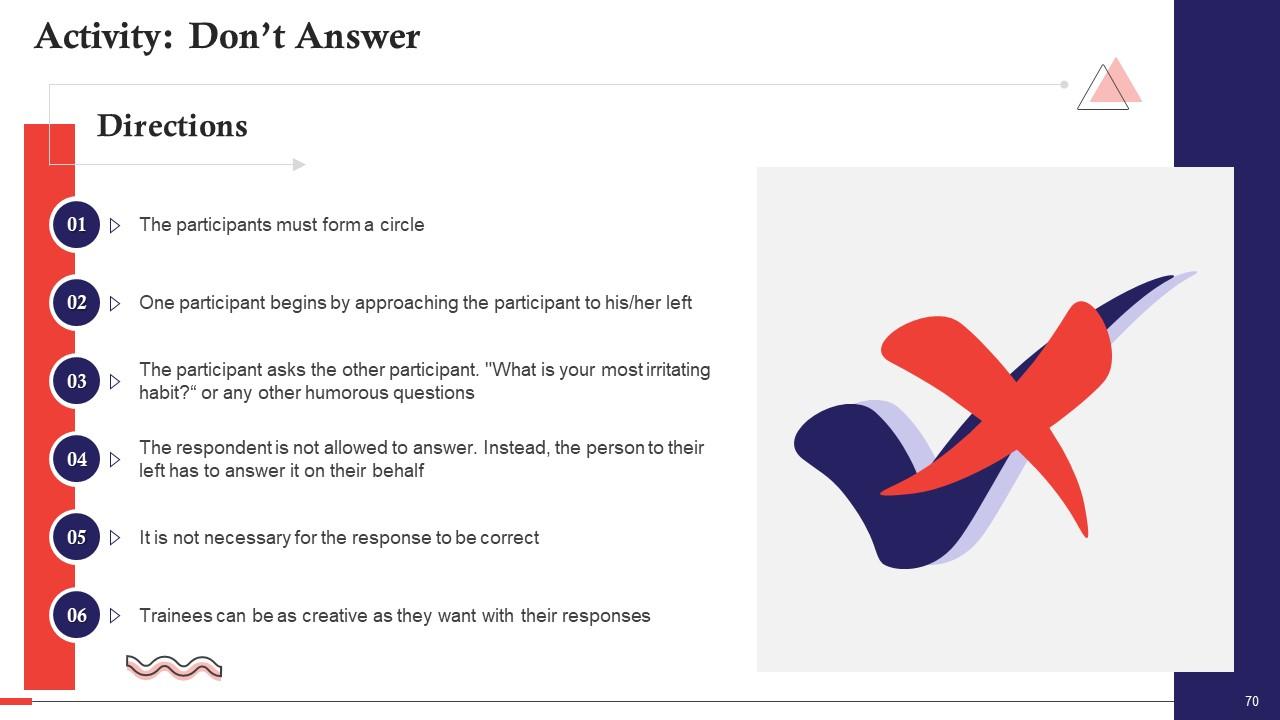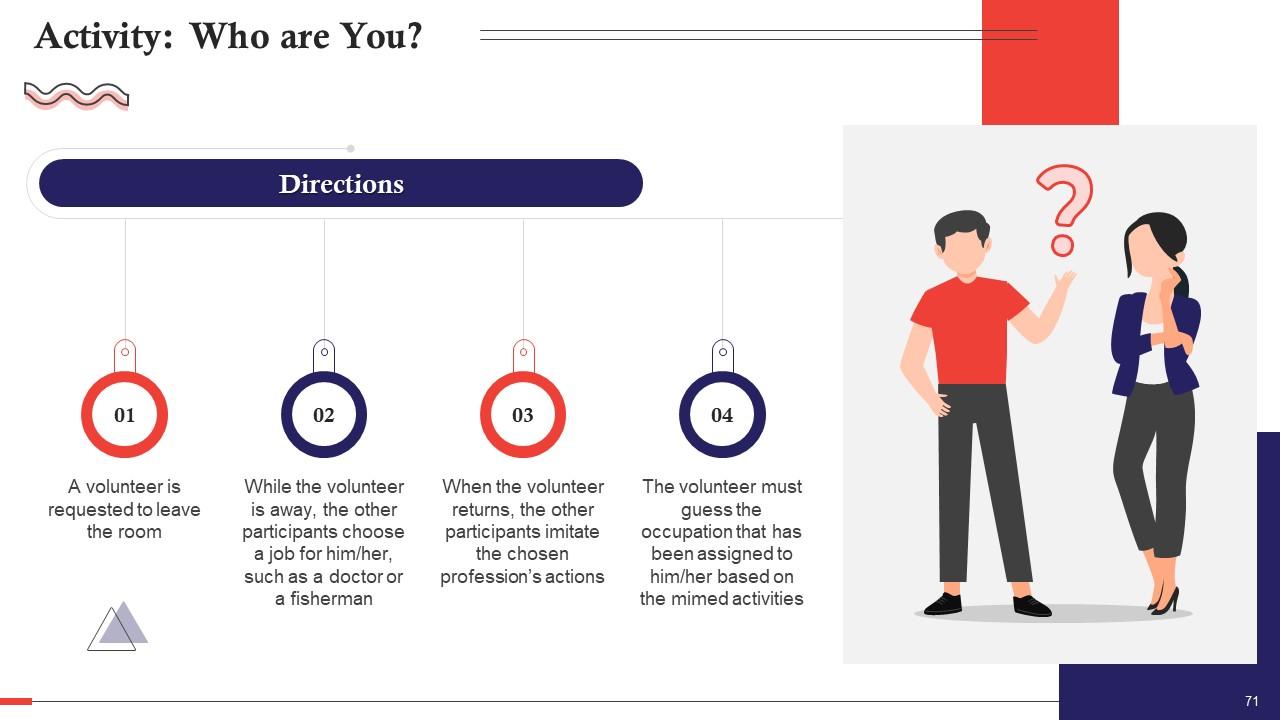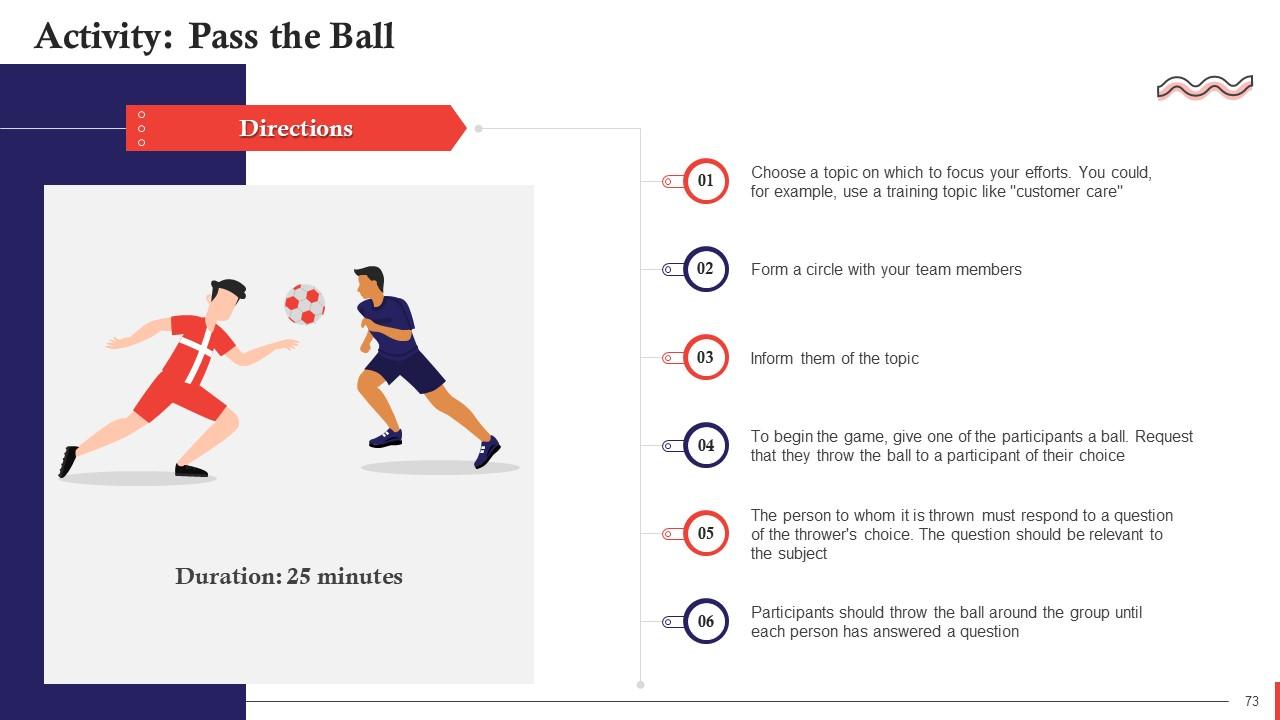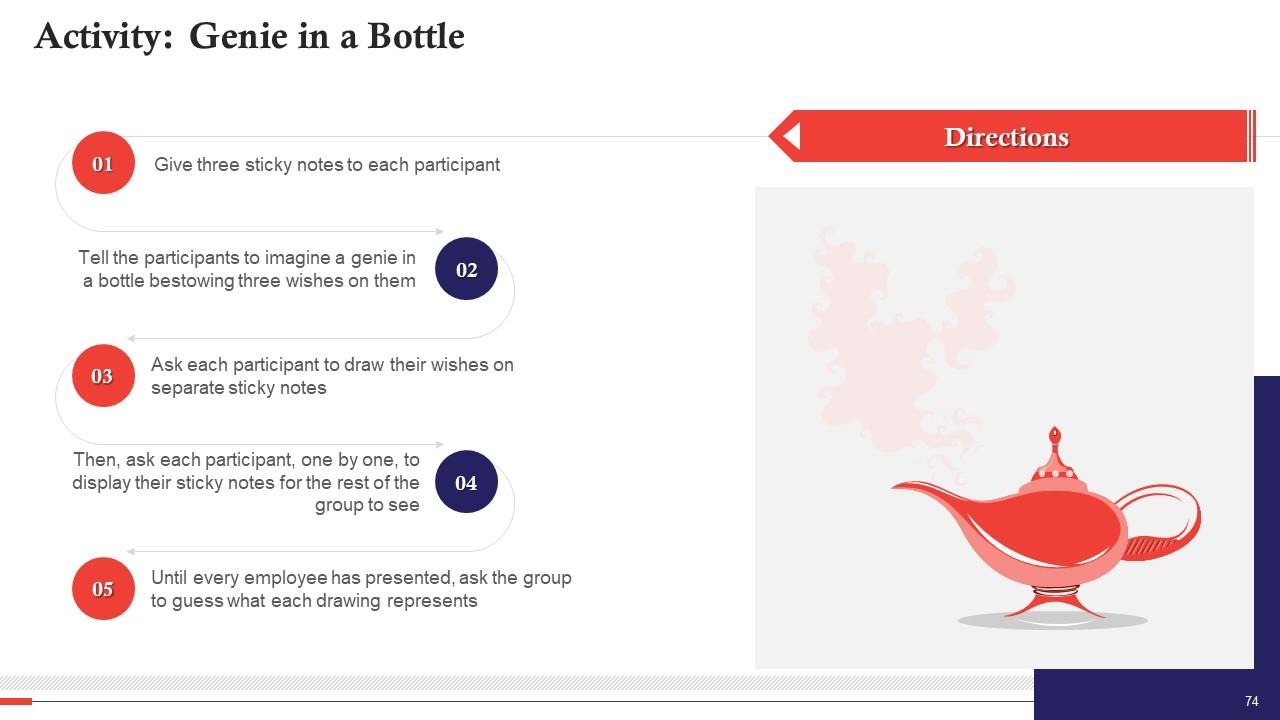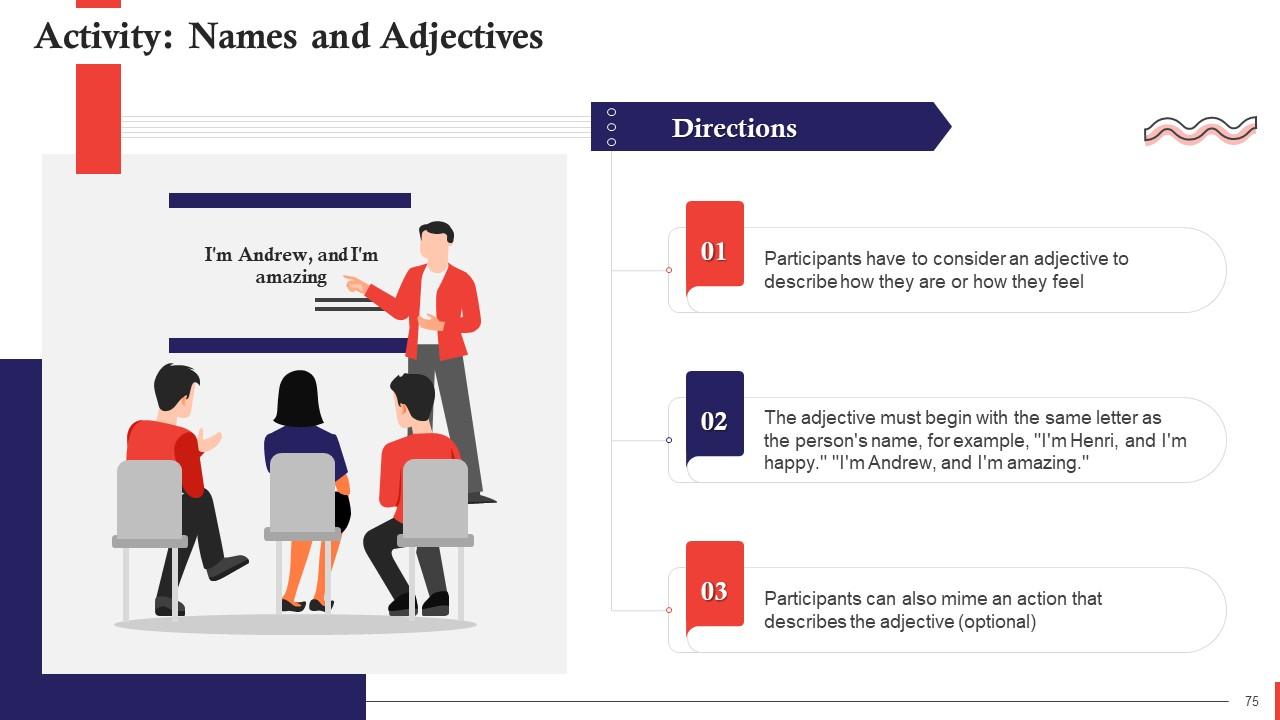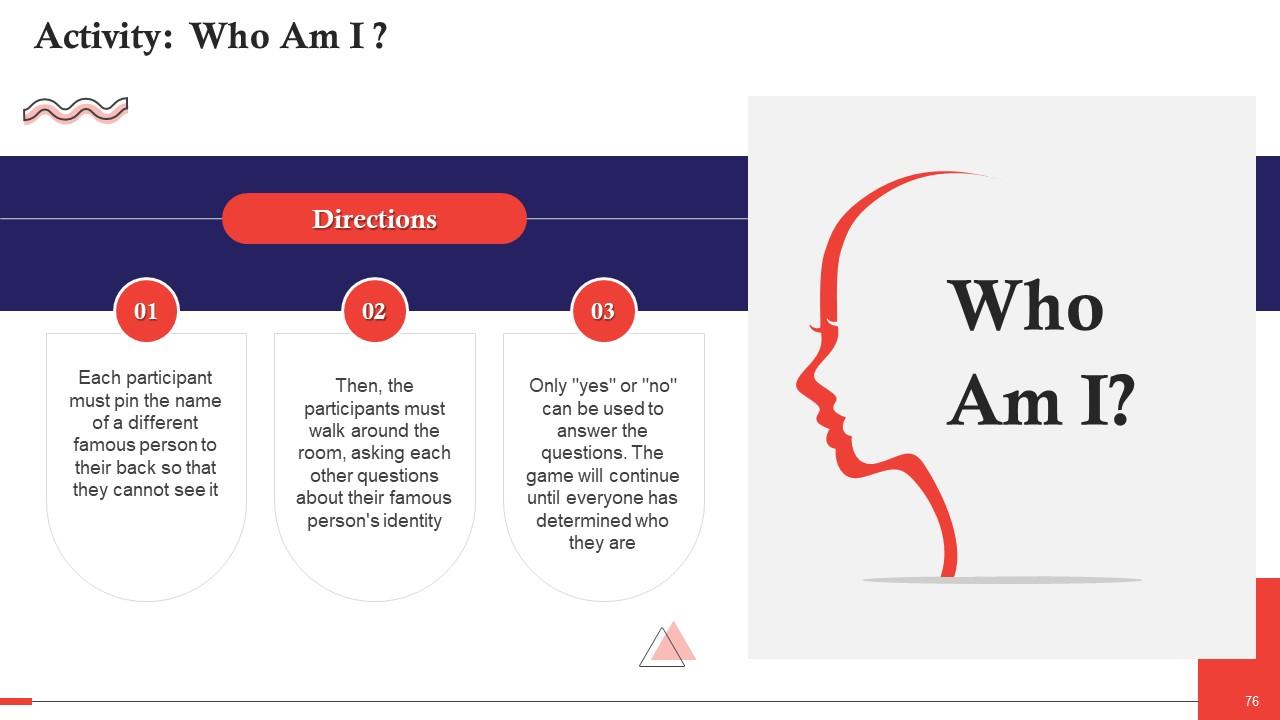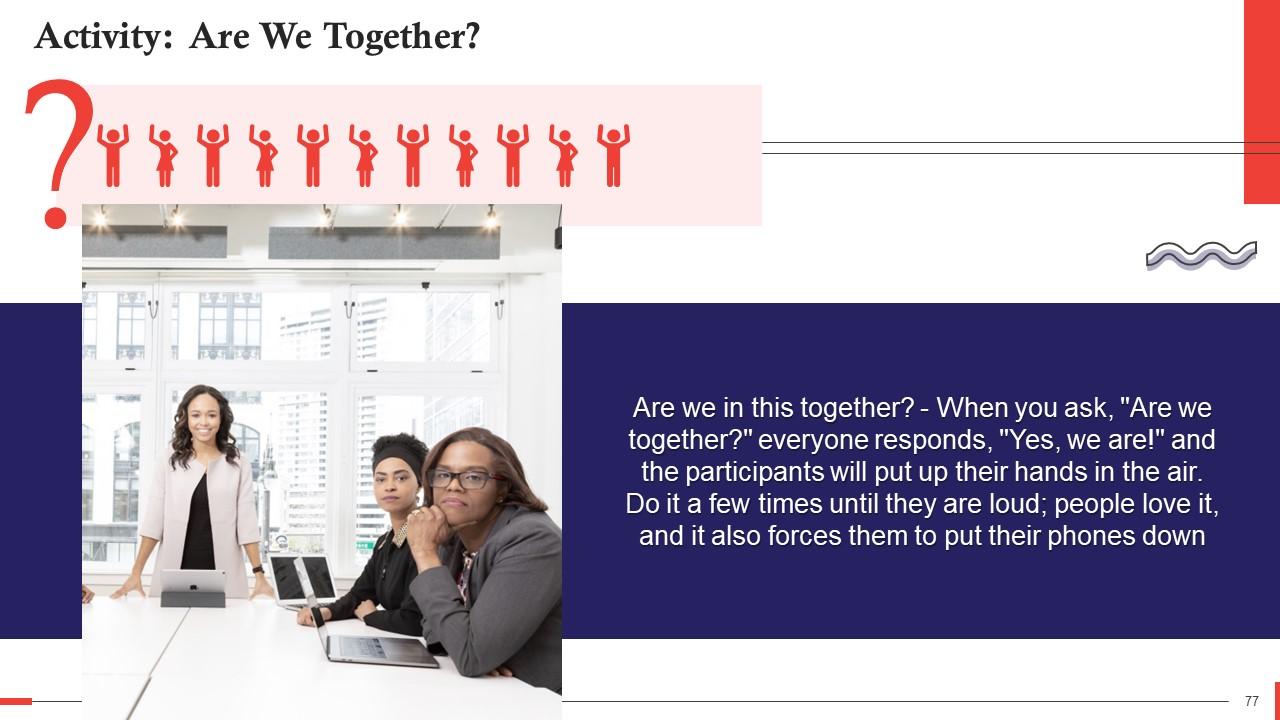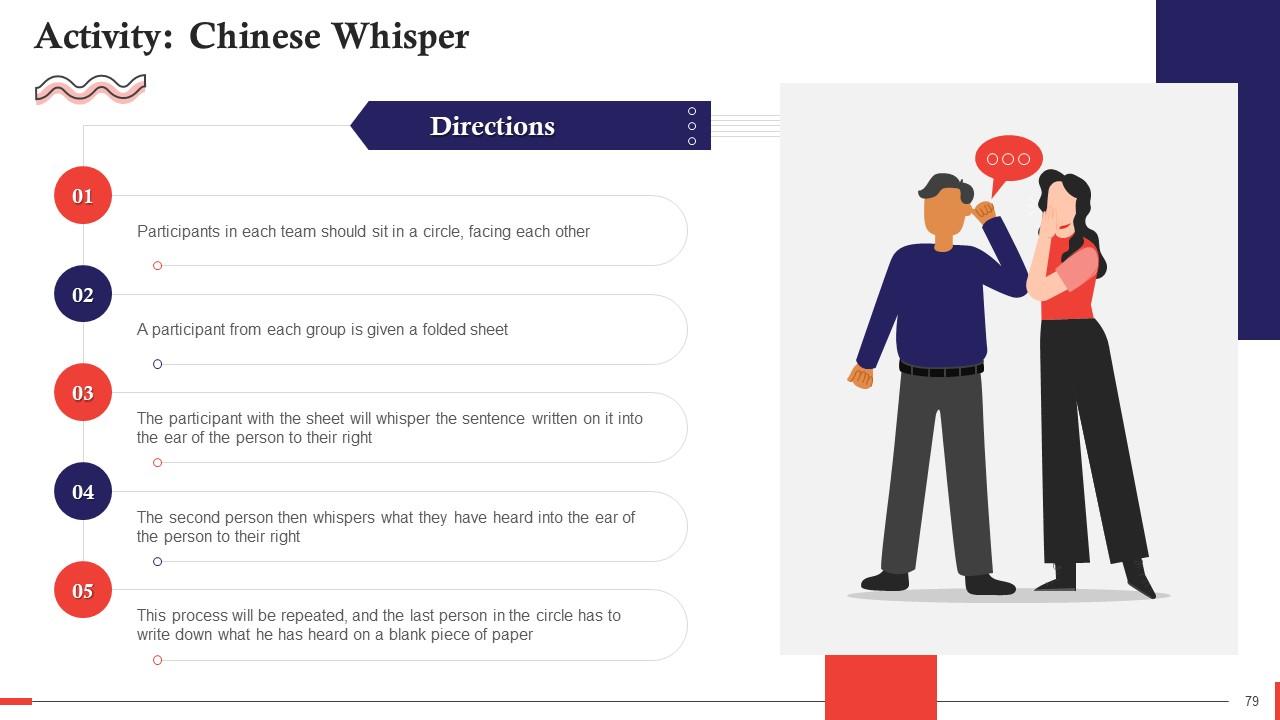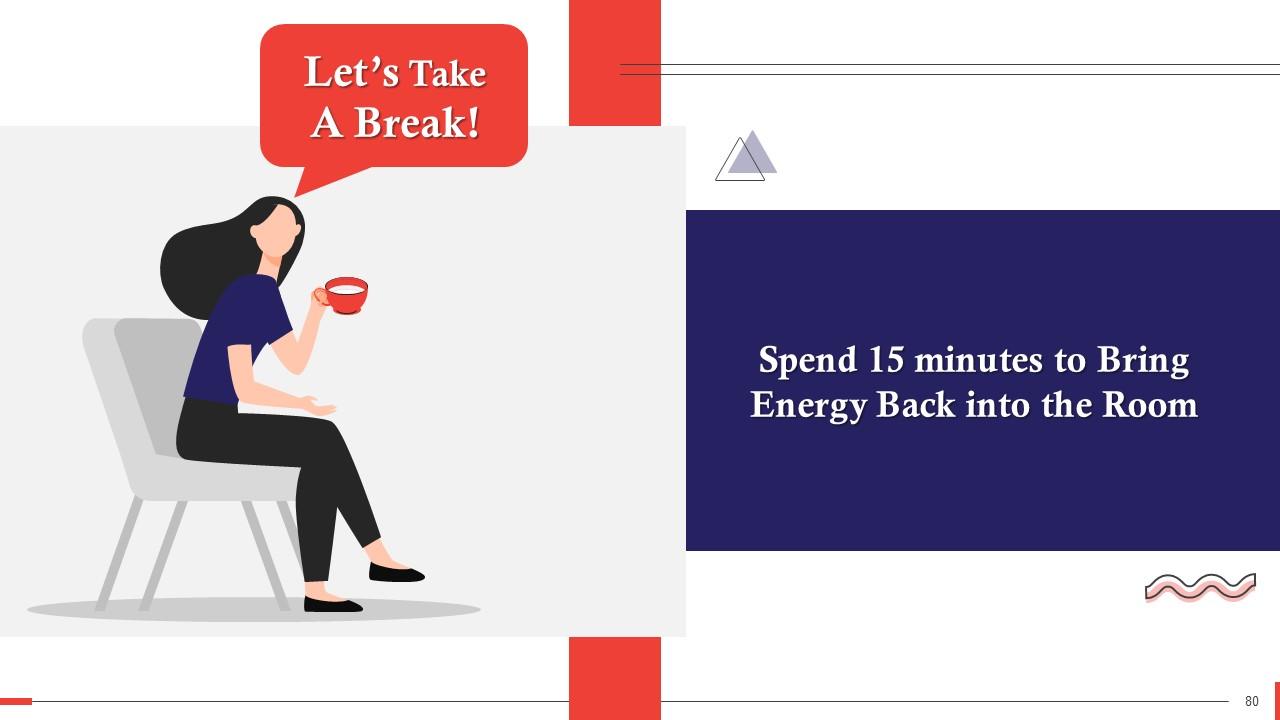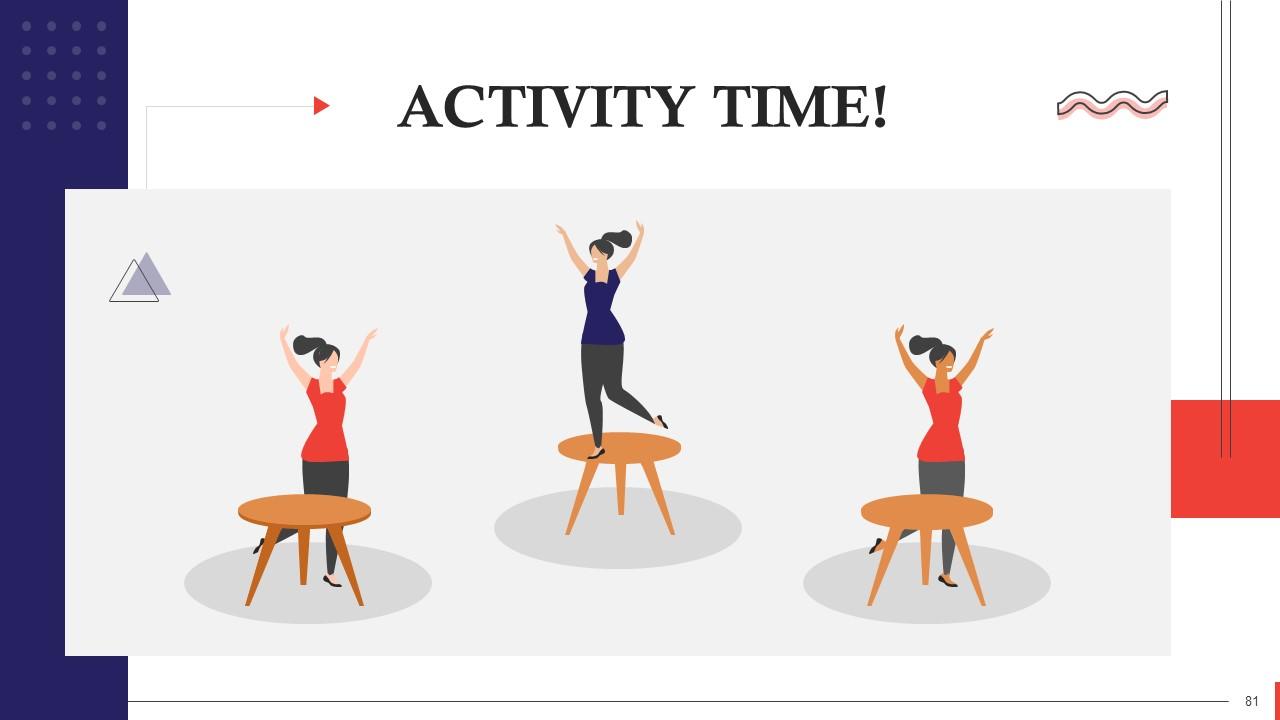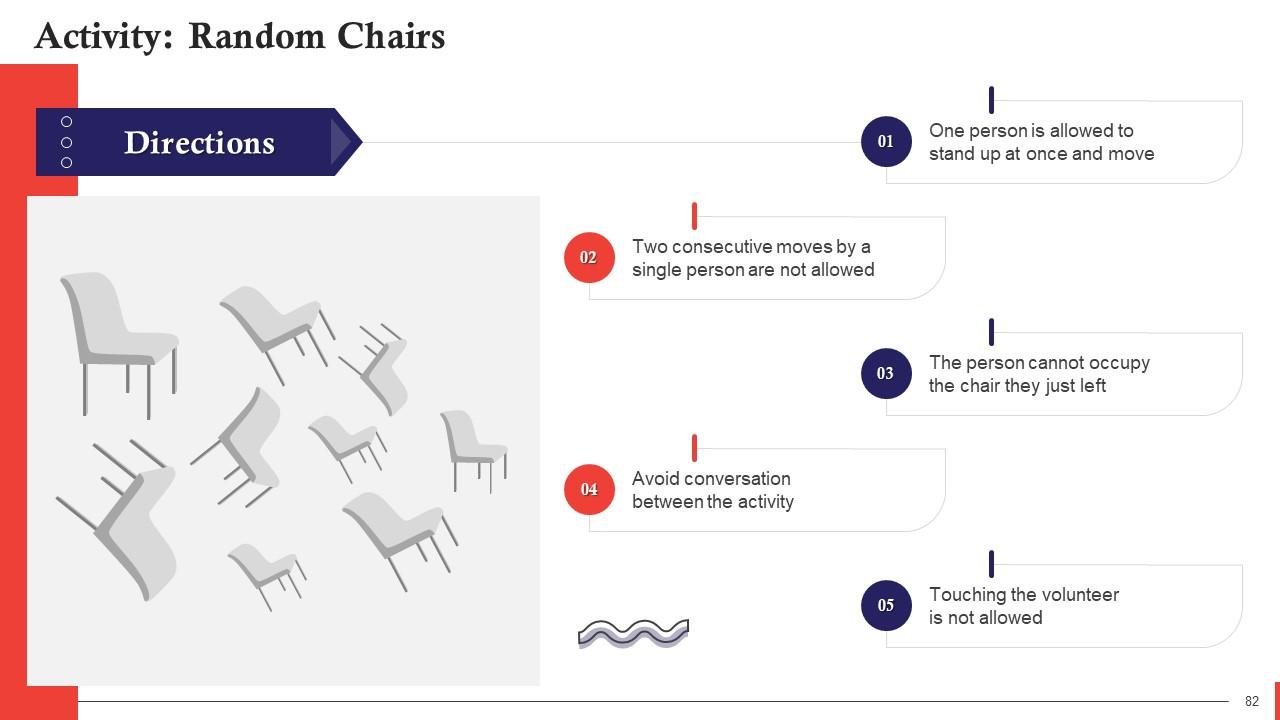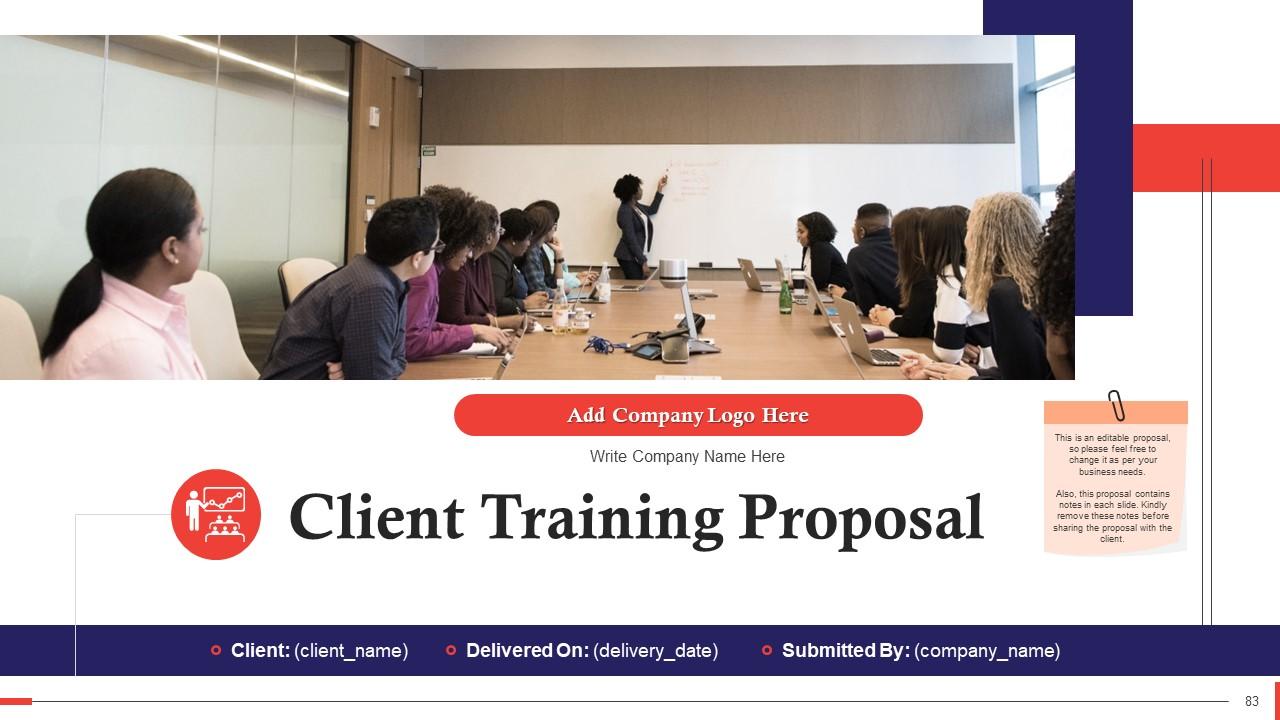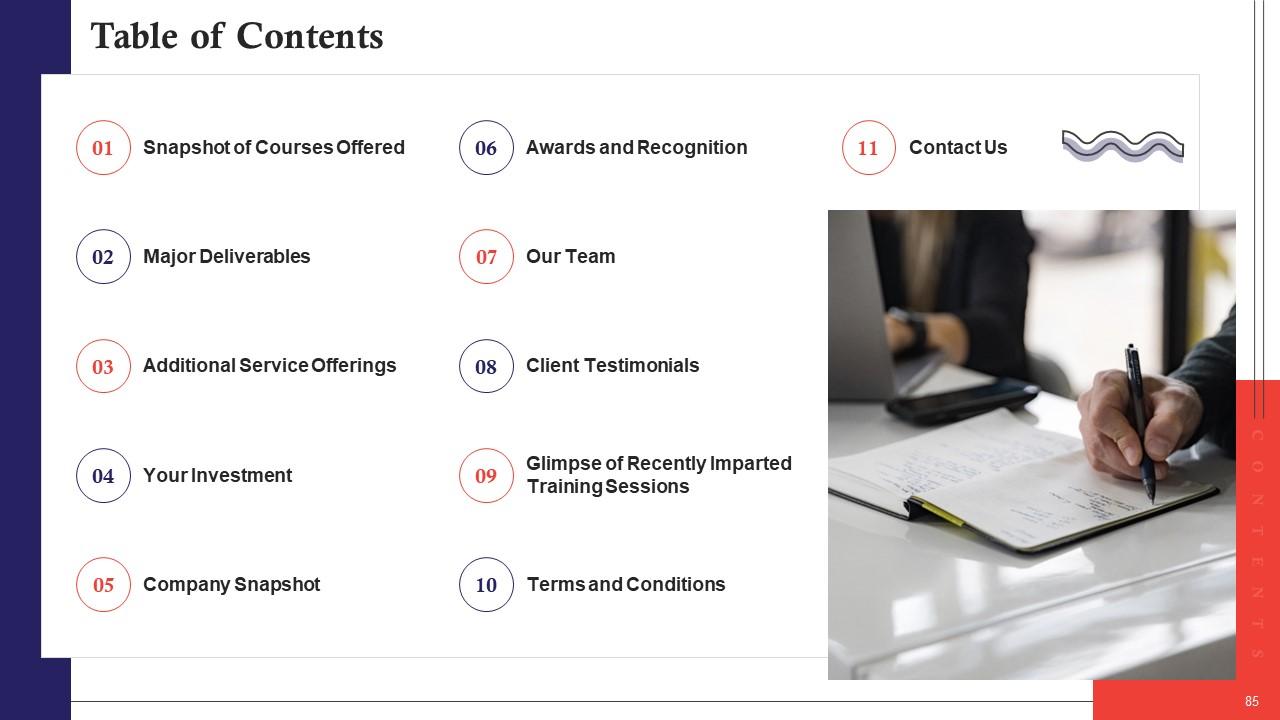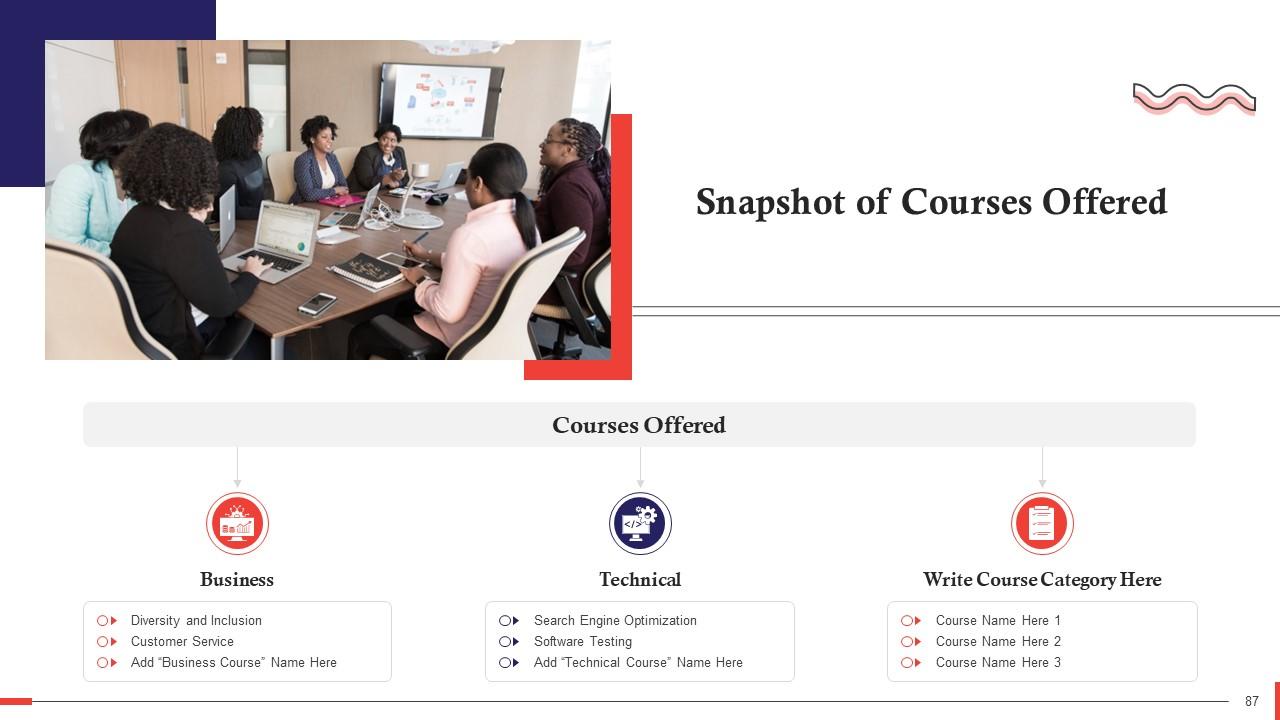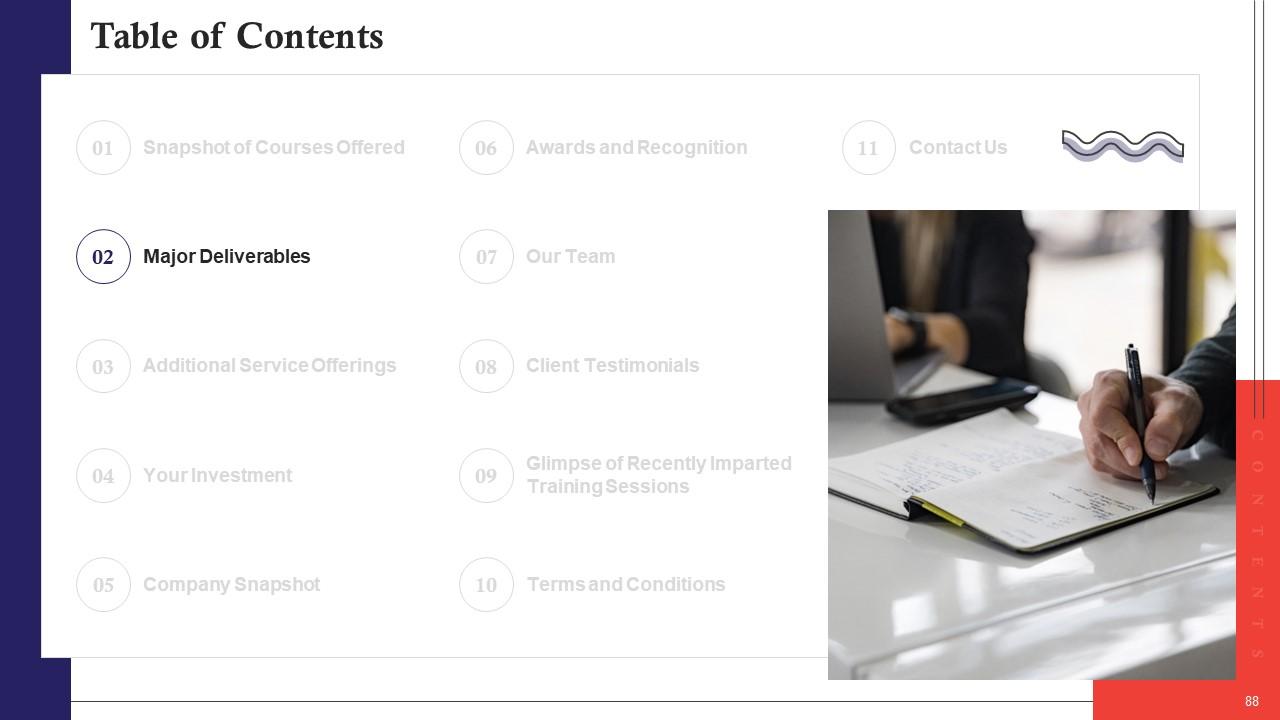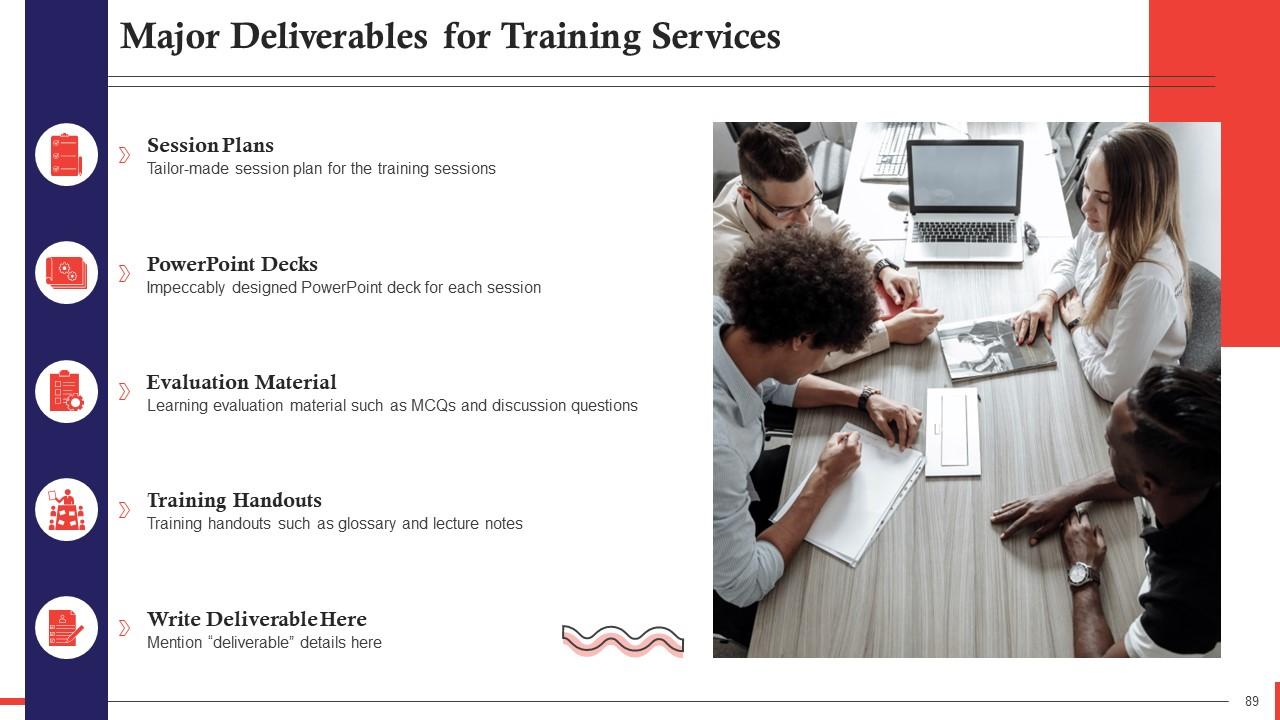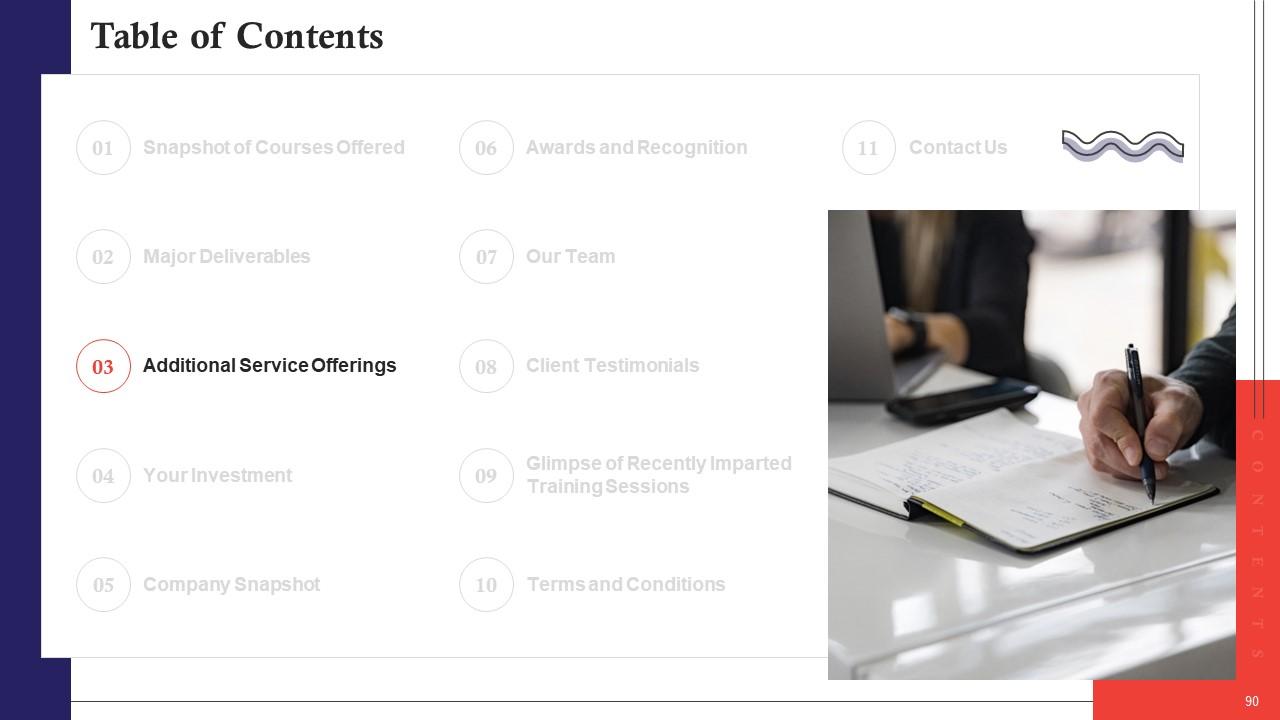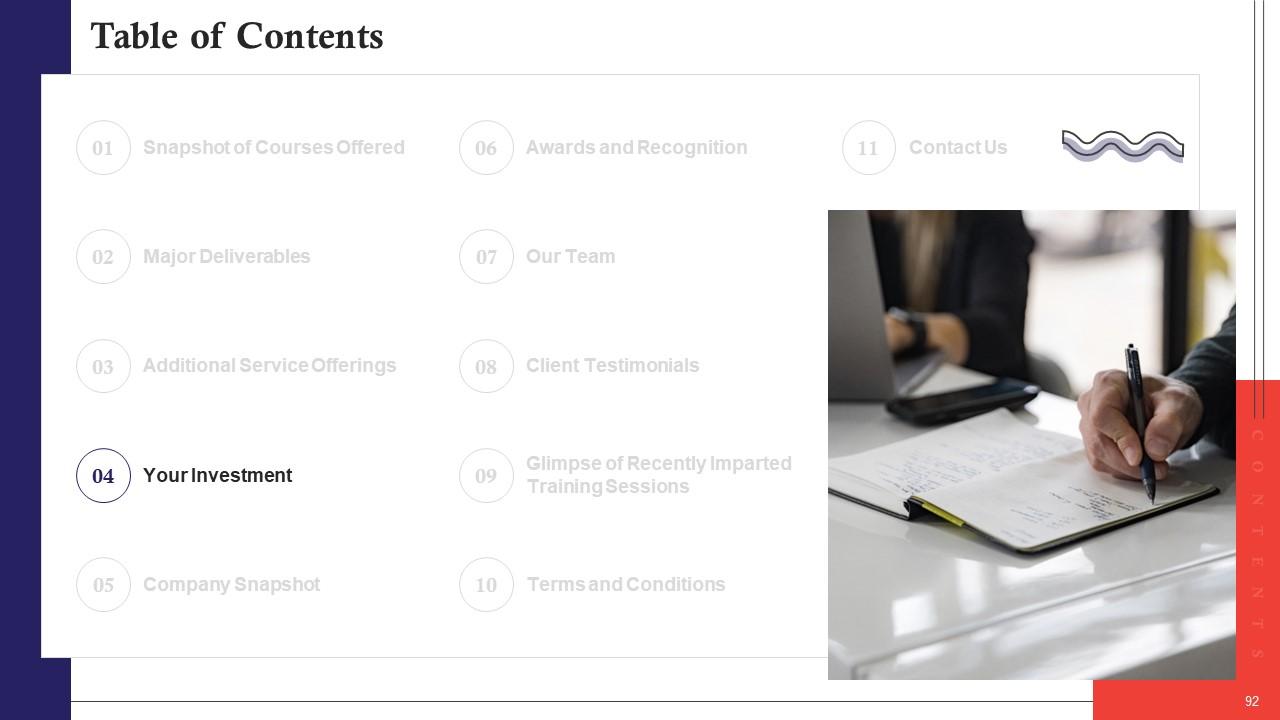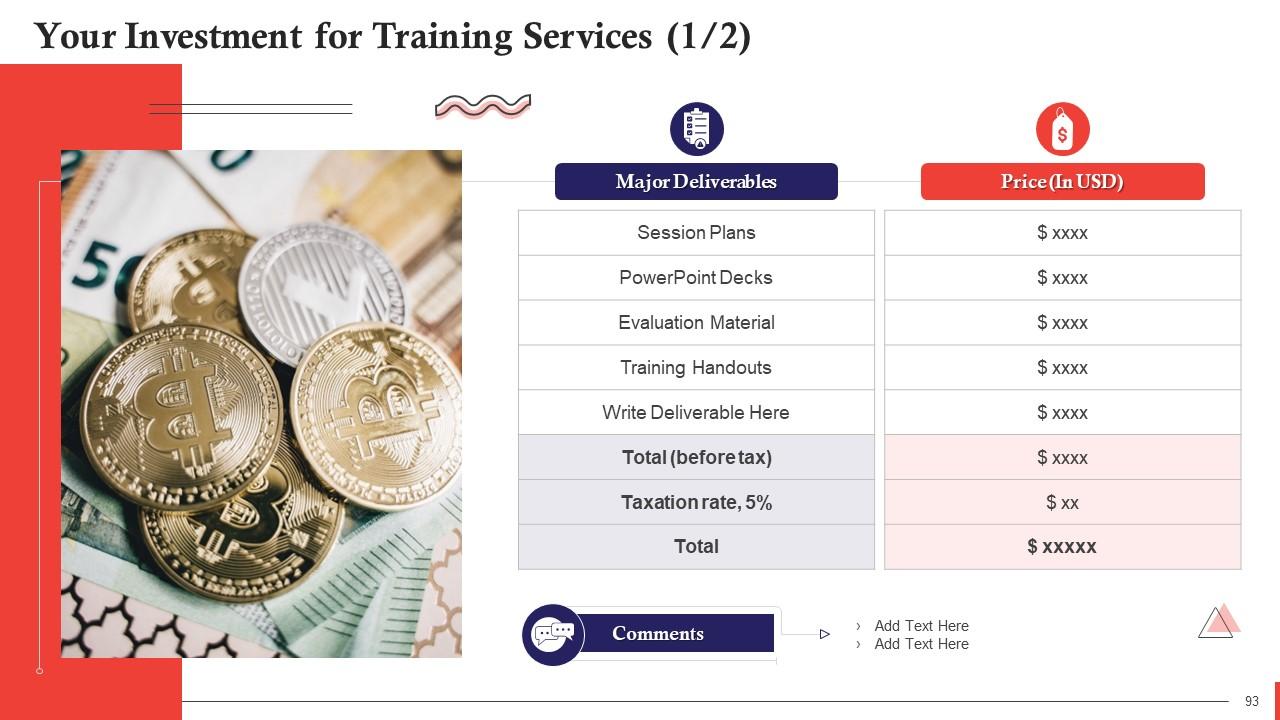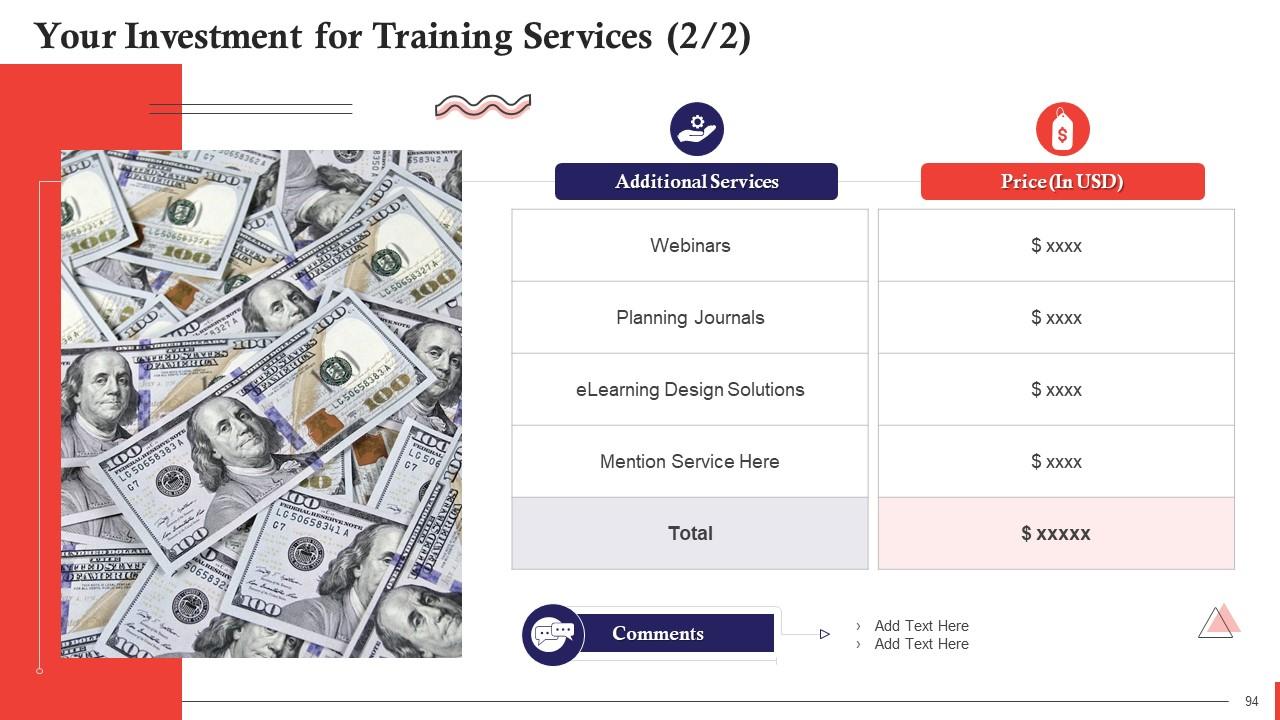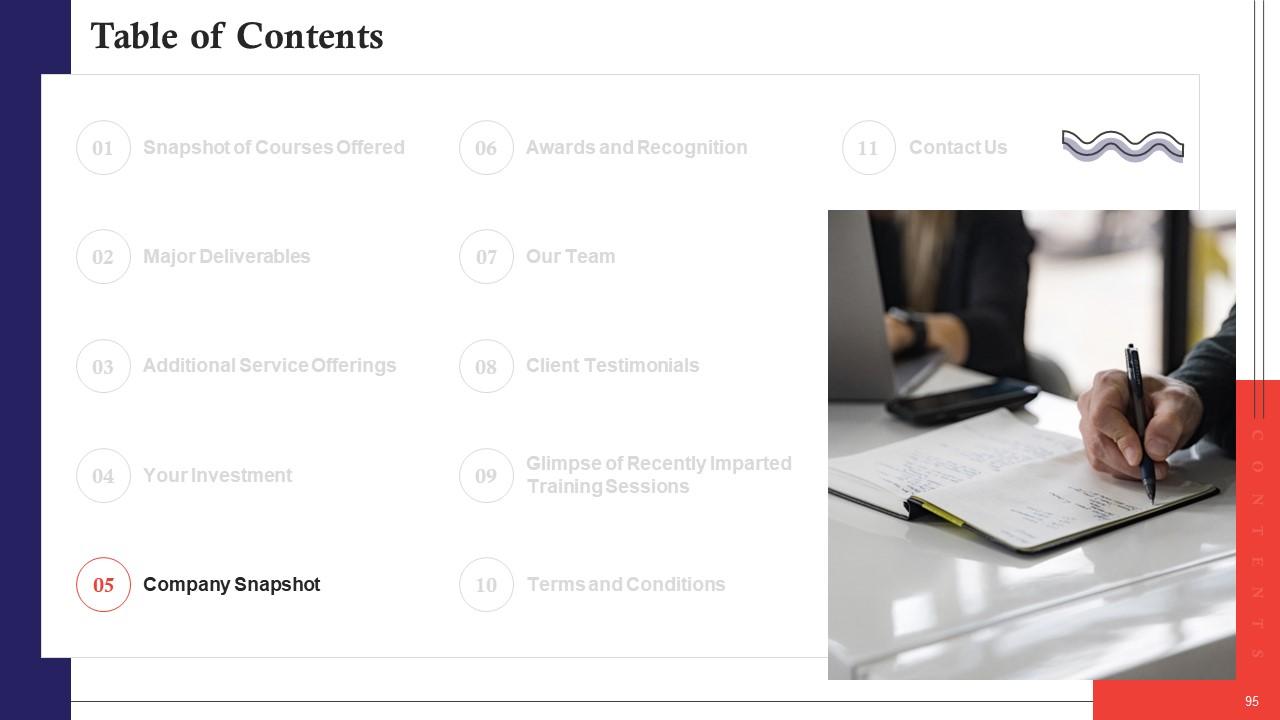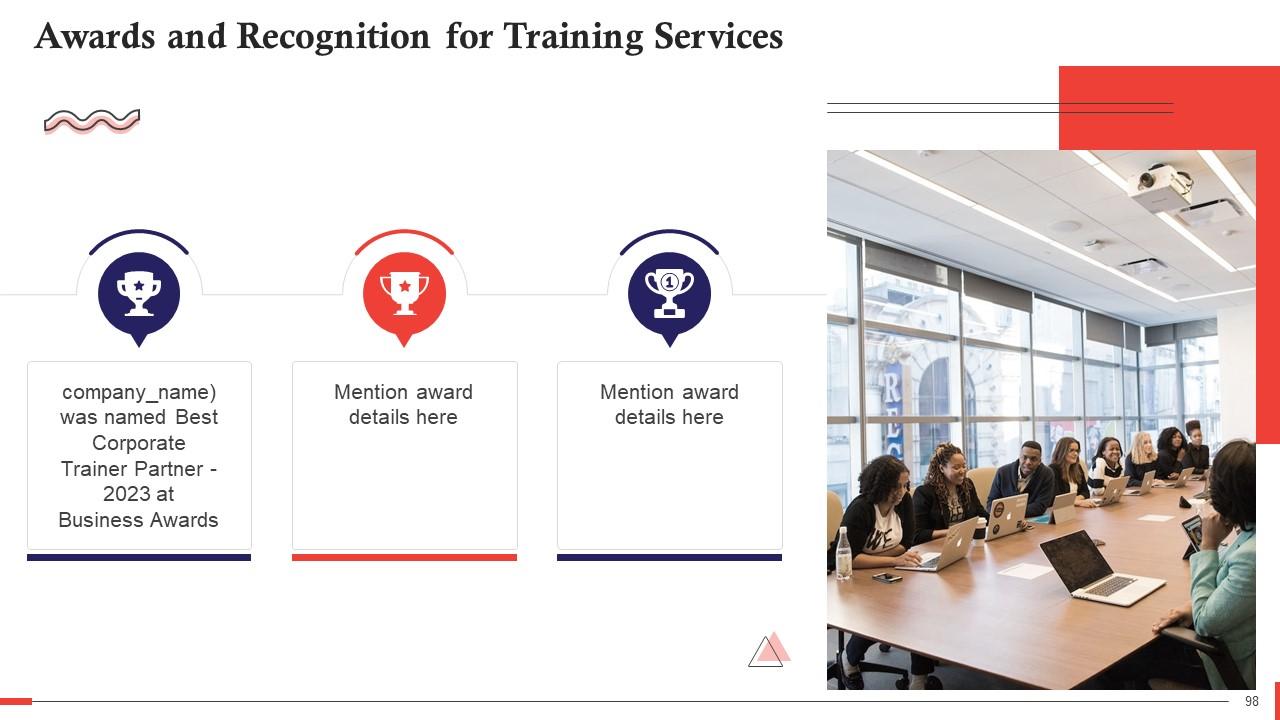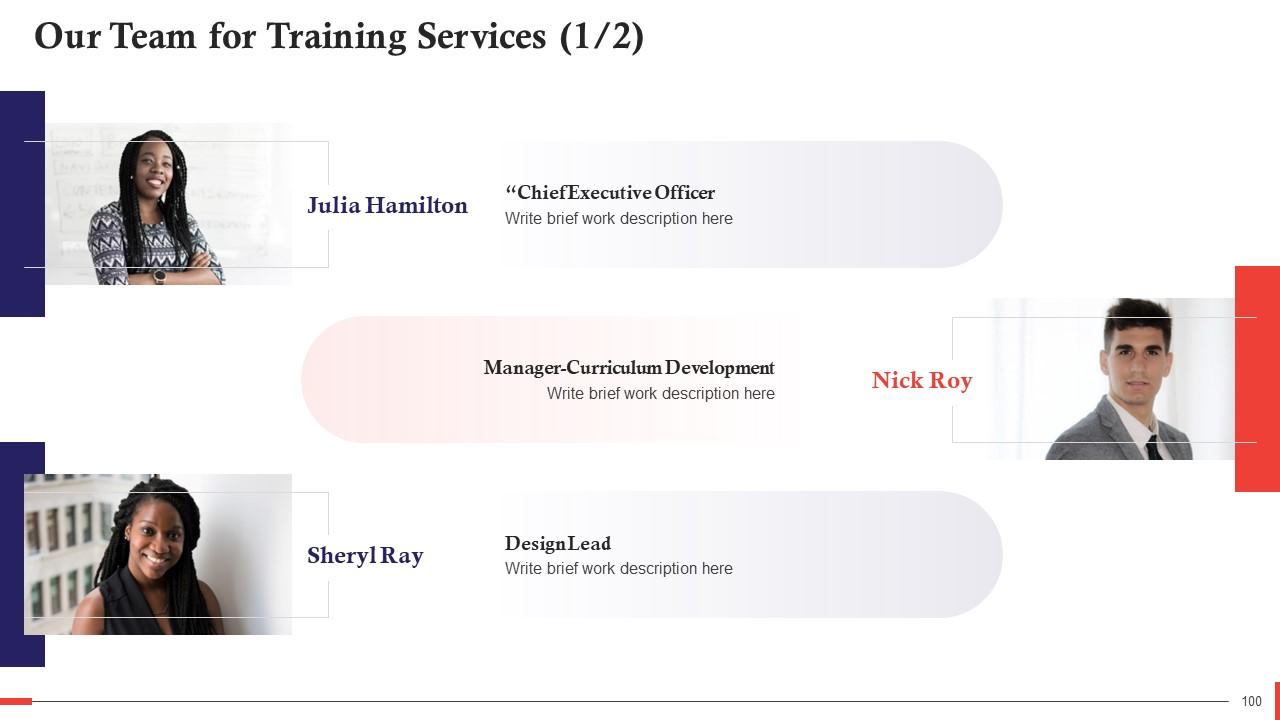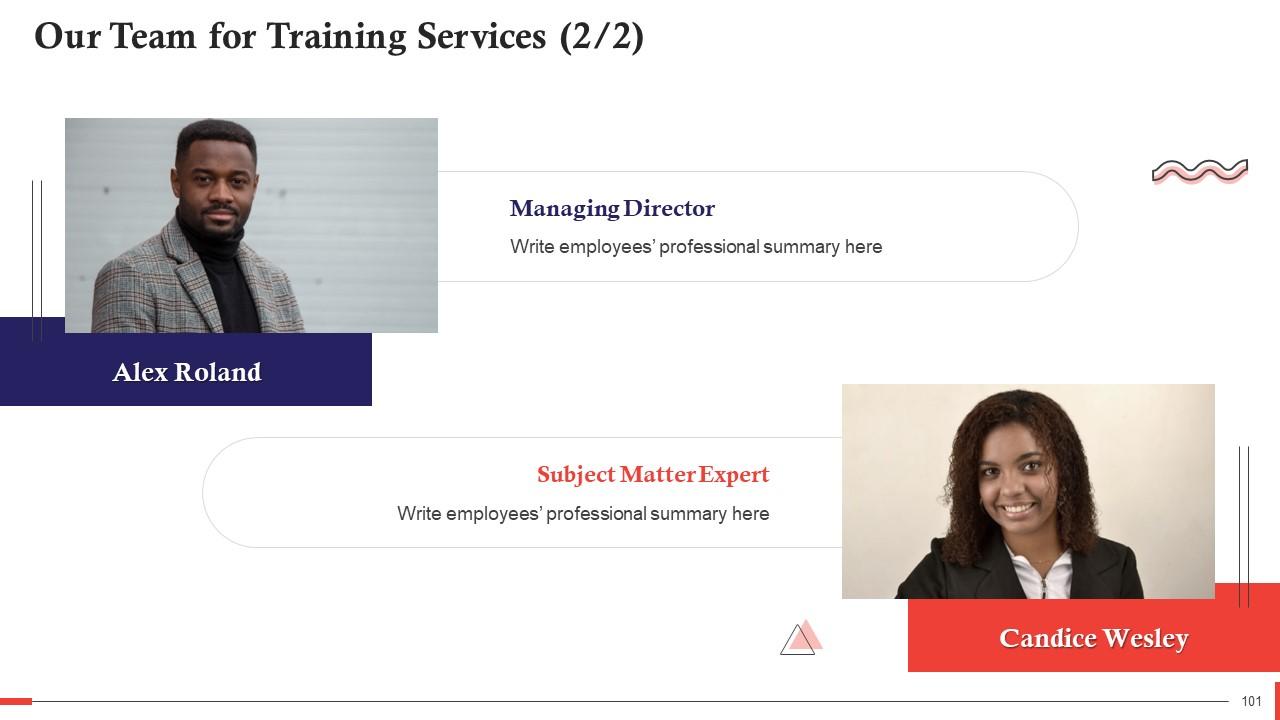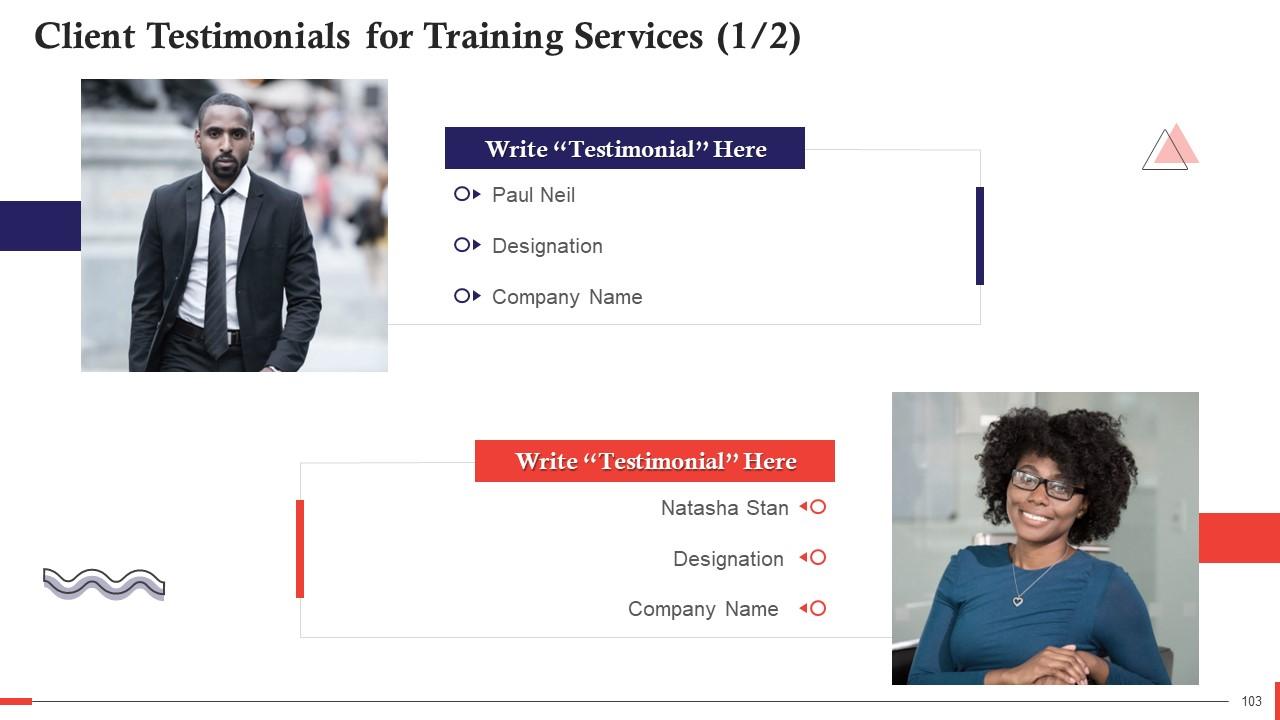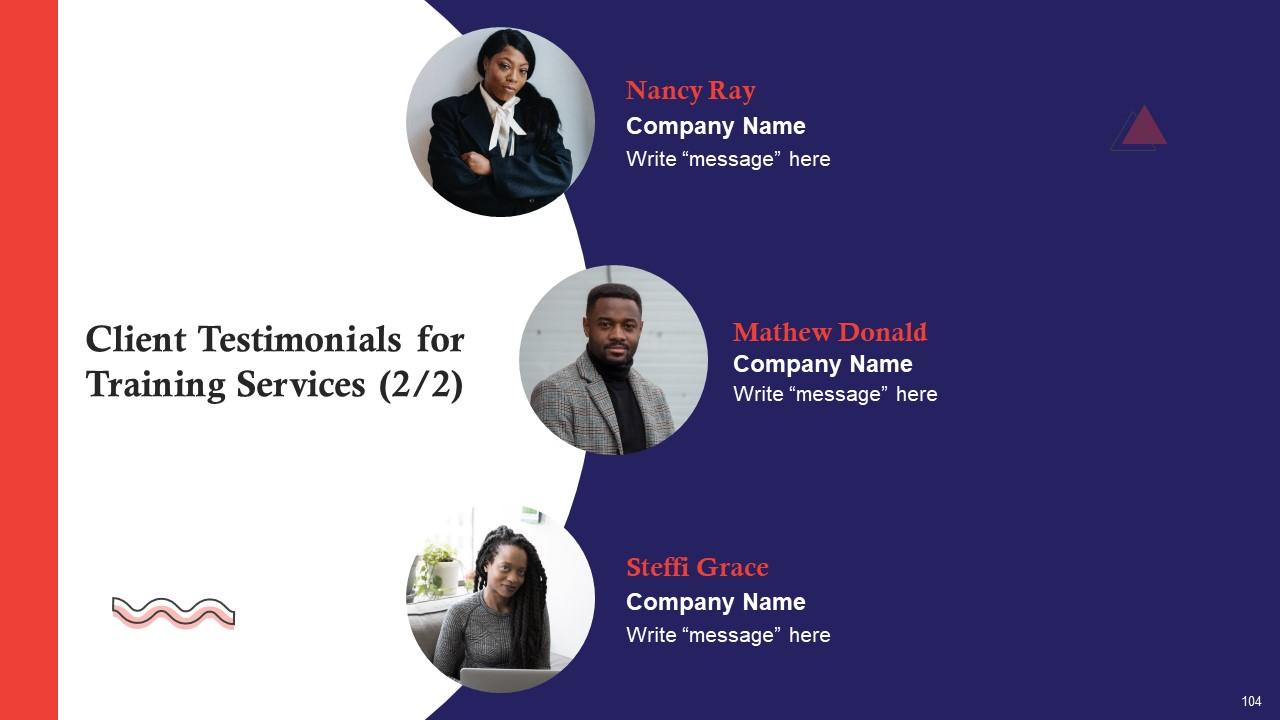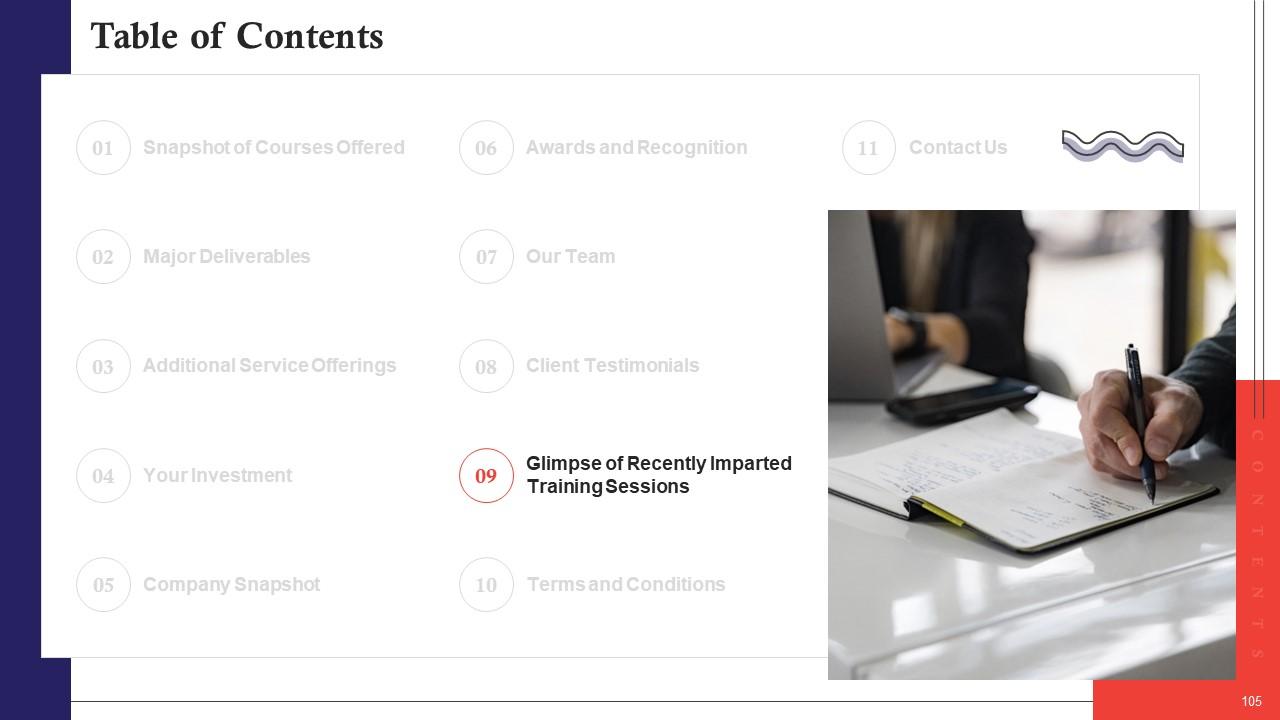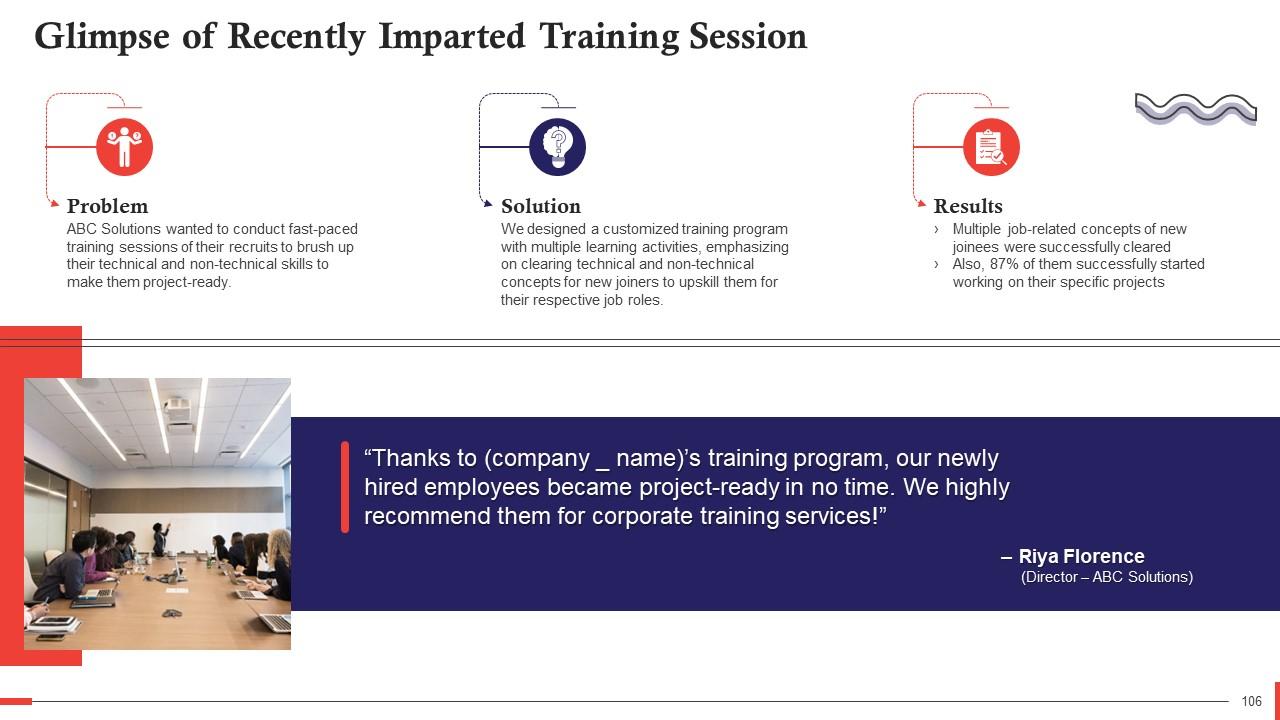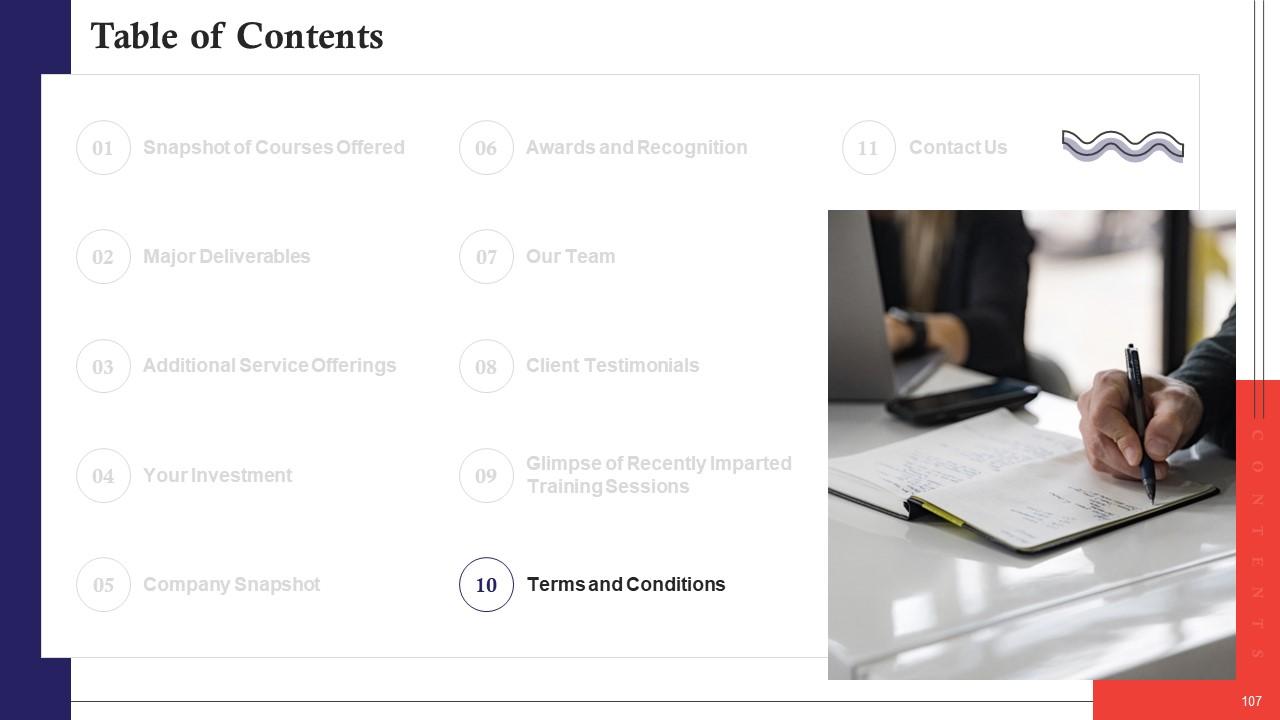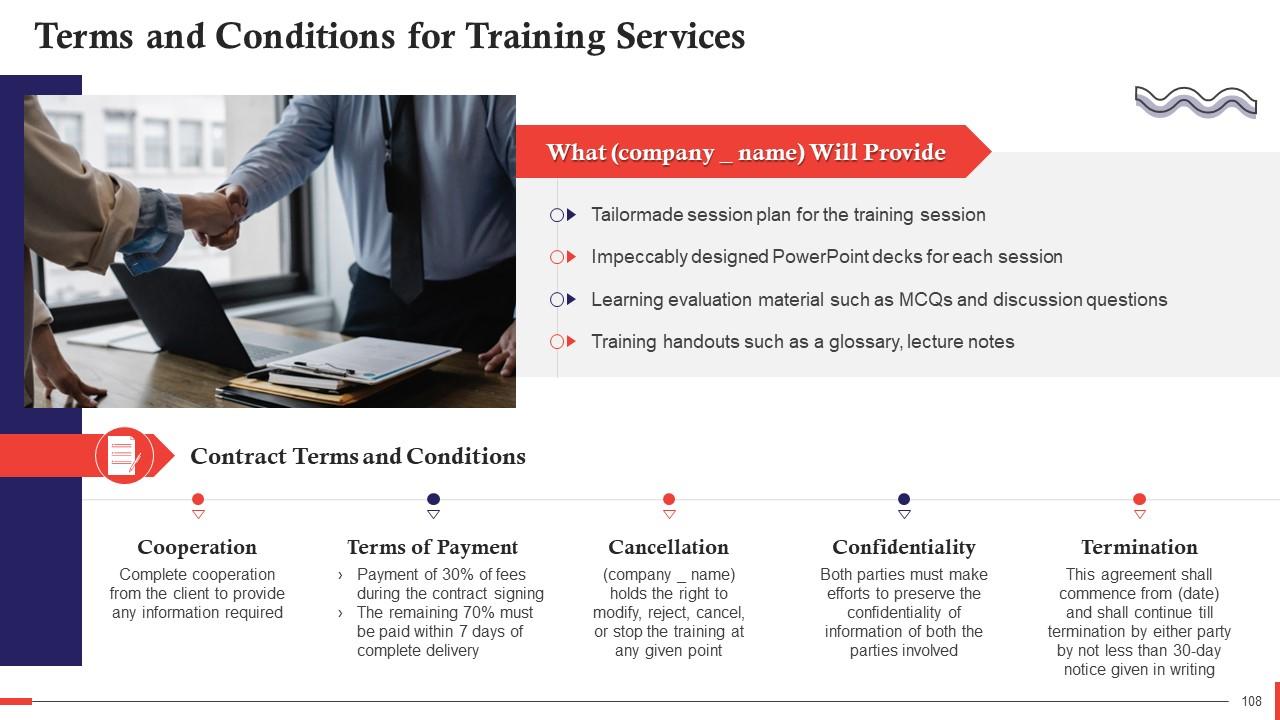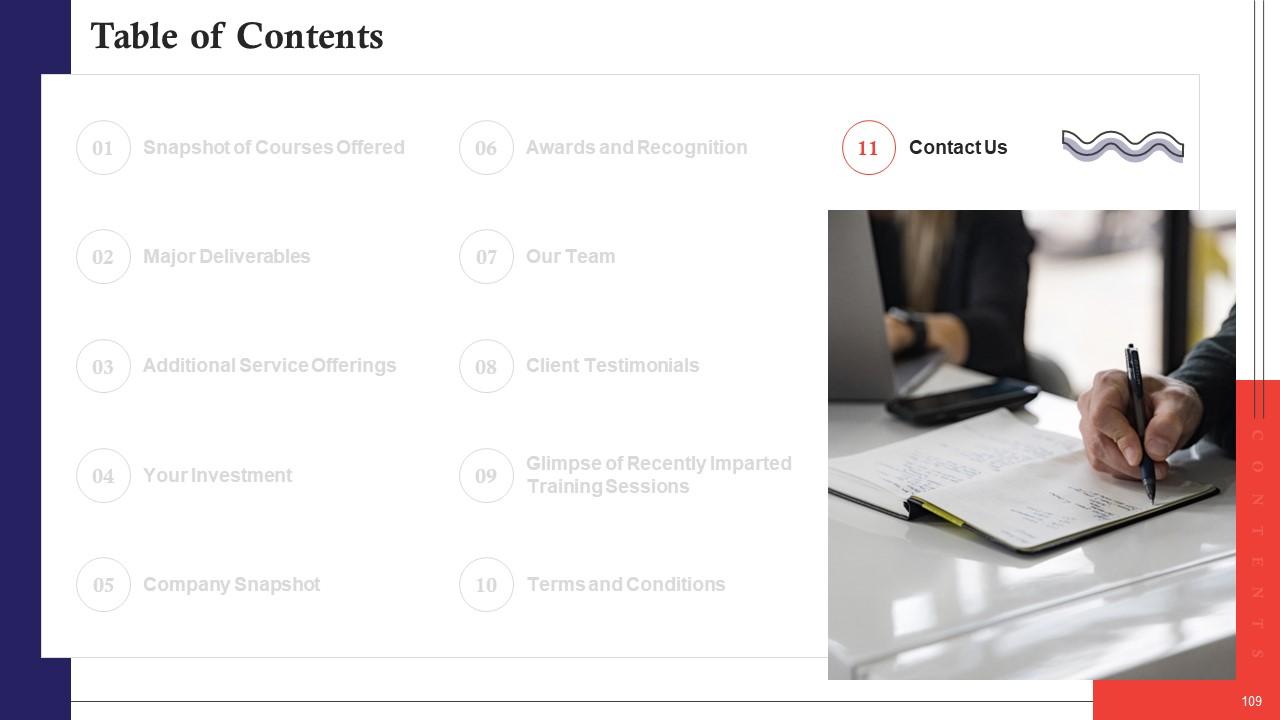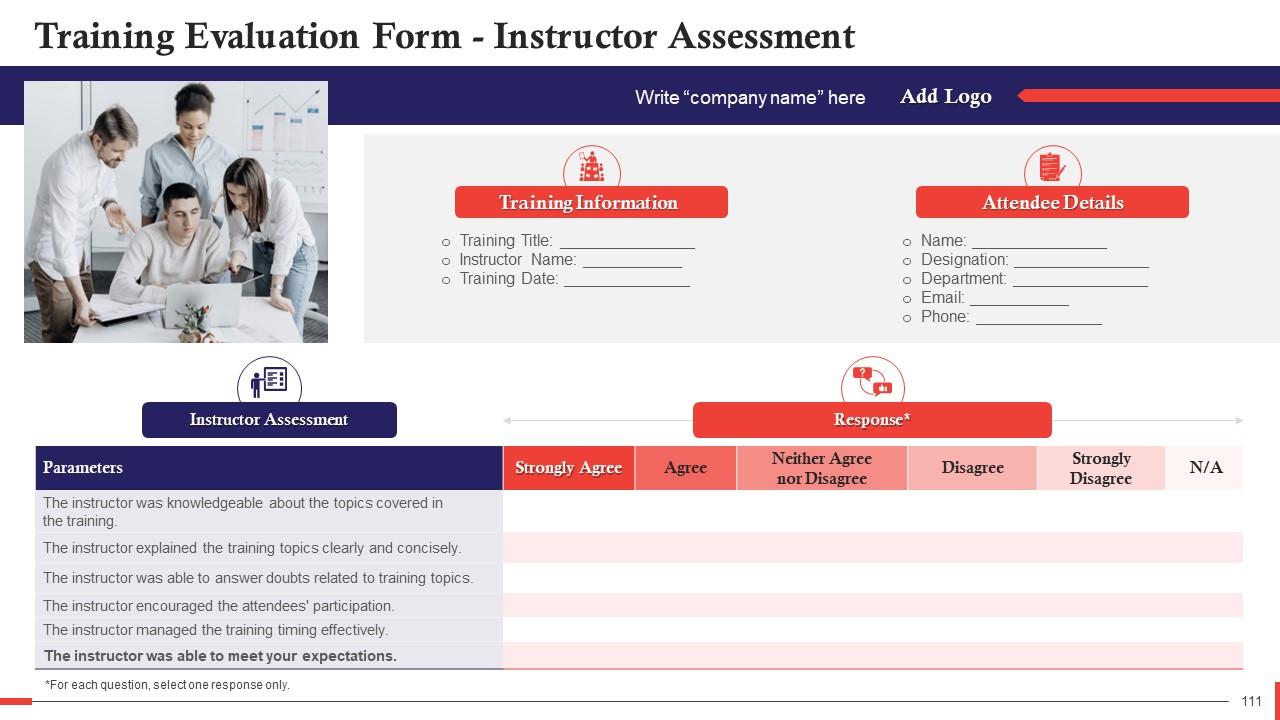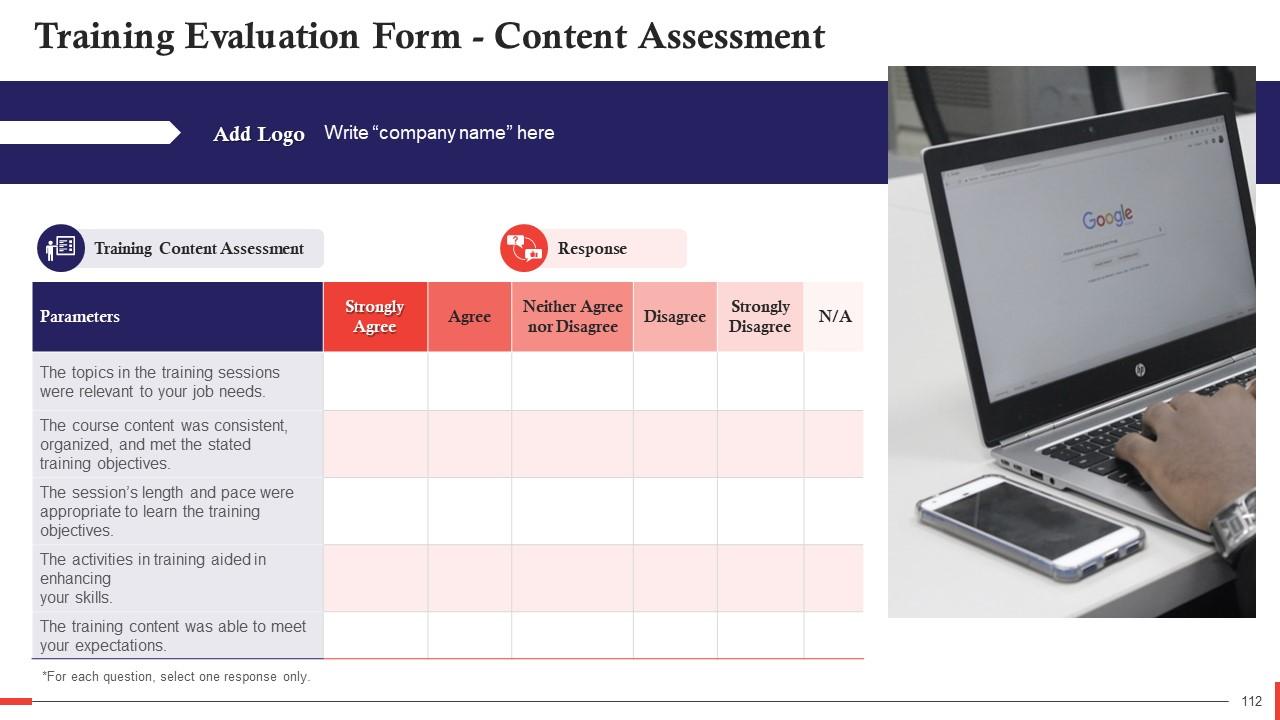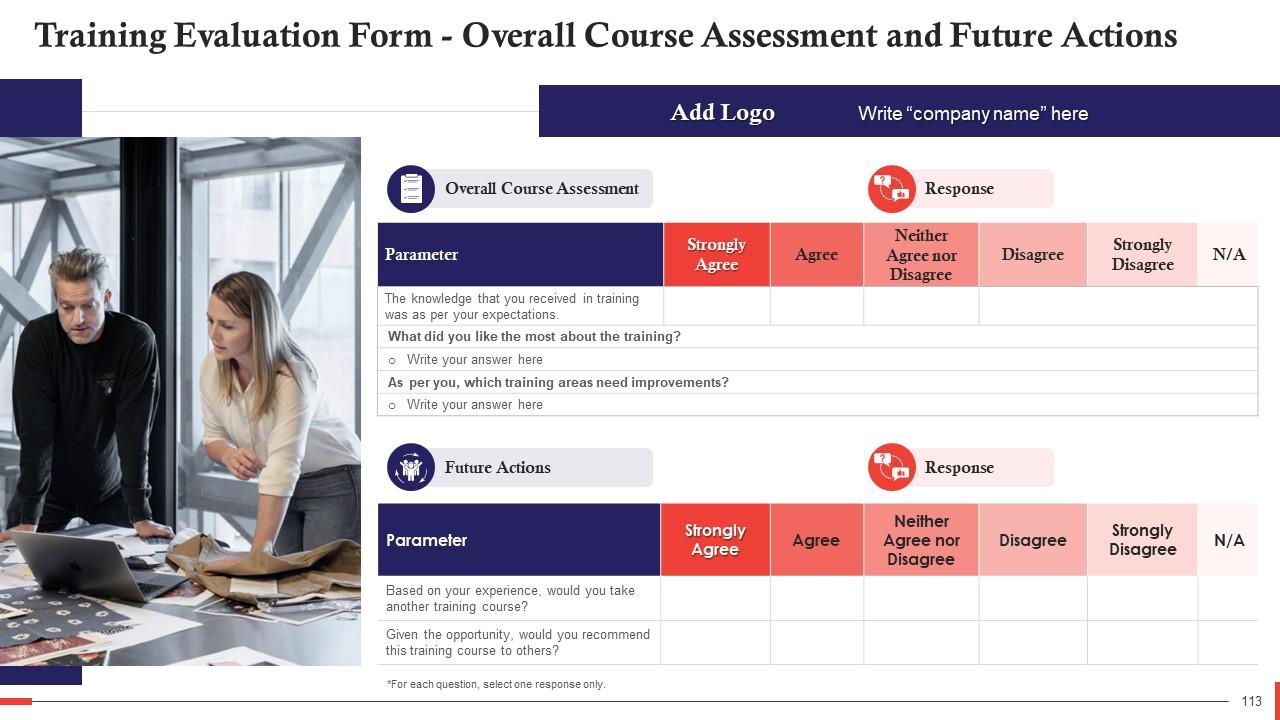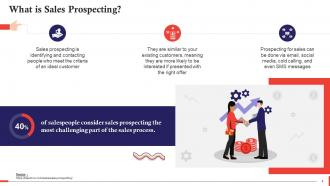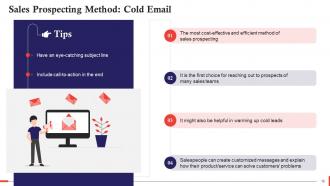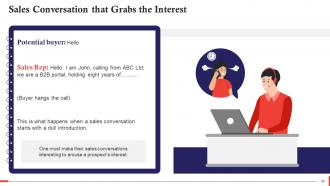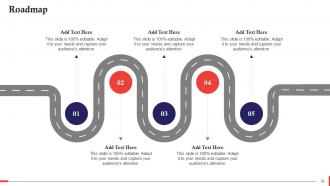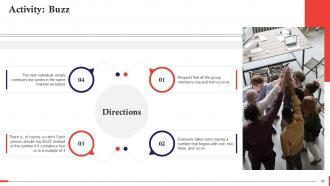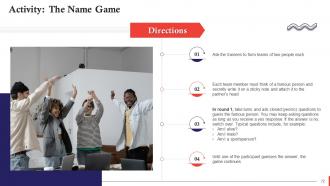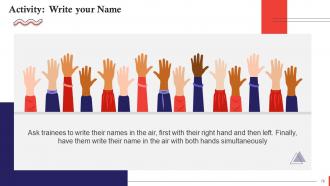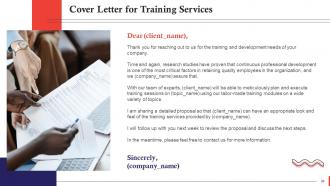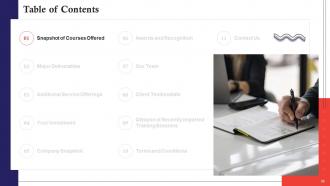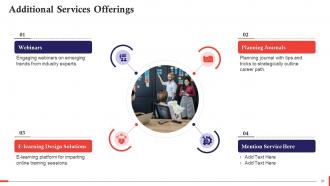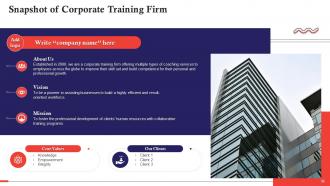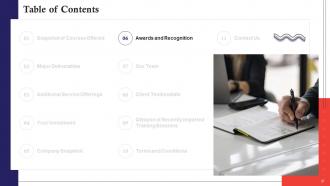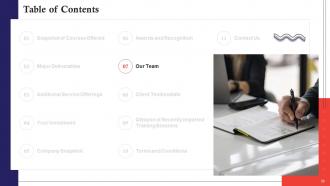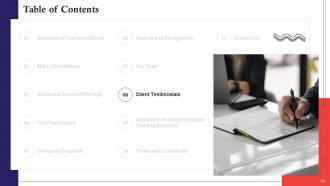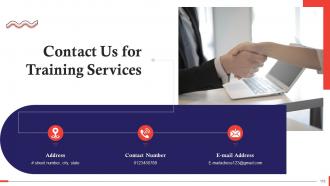Opening The Sales Conversation Training Ppt
This training module on Opening The Sales Conversation in depth covers Sales Prospecting and its Importance Increased Sales, More Revenue, Gained Insights, Increased Customer Lifetime Value, Sales Prospecting Process Research, Outreach, Discovery Call, Educate and Evaluate, Close, and Sales Prospecting Methods Cold Email, Cold Calling, Social Media, Webinars, Referral, Events. Further, it covers Steps to Get Past the Gatekeeper Treat the Gatekeeper as a Resource, Be Honest, Be Assertive, Dont Try to Sell to the Gatekeeper, Try Social Engagement, Dealing with Upfront Rejection in Sales Keep your Cool, Lower Resistance, and How to Have a Successful Sales Conversation. Have the Right Opening Statement, Personalized Conversation, Build Rapport, Maintain the Right Tone, Ask the Right Questions, Demonstrate your Expertise, Be Clear With the Next Step. It also includes Activities, Key Takeaways, and Discussion Questions related to the topic to make the coaching session more interactive. The deck has PPT slides on About Us, Vision, Mission, Goal, 30-60-90 Days Plan, Timeline, Roadmap, Training Completion Certificate, and Energizer Activities. It also includes a Client Proposal and Assessment Form for training evaluation.
- Google Slides is a new FREE Presentation software from Google.
- All our content is 100% compatible with Google Slides.
- Just download our designs, and upload them to Google Slides and they will work automatically.
- Amaze your audience with SlideTeam and Google Slides.
-
Want Changes to This PPT Slide? Check out our Presentation Design Services
- WideScreen Aspect ratio is becoming a very popular format. When you download this product, the downloaded ZIP will contain this product in both standard and widescreen format.
-

- Some older products that we have may only be in standard format, but they can easily be converted to widescreen.
- To do this, please open the SlideTeam product in Powerpoint, and go to
- Design ( On the top bar) -> Page Setup -> and select "On-screen Show (16:9)” in the drop down for "Slides Sized for".
- The slide or theme will change to widescreen, and all graphics will adjust automatically. You can similarly convert our content to any other desired screen aspect ratio.
Compatible With Google Slides

Get This In WideScreen
You must be logged in to download this presentation.
PowerPoint presentation slides
Presenting Training Deck on Opening the Sales Conversation. This presentation deck contains 113 well-researched and uniquely designed slides. These slides are 100 percent made in PowerPoint and are compatible with all screen types and monitors. They also support Google Slides. Premium Customer Support available. Suitable for use by managers, employees, and organizations. These slides are easily customizable. You can edit the color, text, icon, and font size to suit your requirements.
People who downloaded this PowerPoint presentation also viewed the following :
Content of this Powerpoint Presentation
Slide 4
This slide discusses sales prospecting. It emphasizes that sales prospecting is the process of identifying and contacting people who meet the requirements of an ideal customer. Email, social media, cold calling, and even SMS messages can be used. It also states that sales prospecting is the most challenging part of the sales process, according to 40% of salespeople.
Slide 5
This slide discusses the importance of sales prospecting. The benefits are: Increased sales, more revenue, gained insights, and increased customer lifetime value.
Instructor’s Notes:
The benefits of sales prospecting are:
- Increased Sales: An effective sales prospecting process can generate new sales opportunities for the sales team to pursue. It can help to accelerate growth and ensure that your company never runs out of leads in pipeline
- More Revenue: More sales opportunities imply more revenue, which the company can reinvest in growing its team, improving its products, or running more marketing campaigns
- Gained Insights: Businesses can identify patterns in prospect behavior by reaching out to more prospects and watching how they respond. Organizations will also better understand their ideal customers, which will positively impact all aspects of business, such as product development, marketing, and branding
- Increased Customer Lifetime Value: As you improve your sales prospecting process, you will better identify prospects that are more likely to stay with you for longer. And this can have a compounding effect by increasing customer lifetime value
Slide 6
This slide illustrates the stages of sales prospecting process. It highlights the transition of leads to opportunities to customers.
Slide 7
This slide discusses the significance of qualifying a prospect. It emphasizes the importance of qualifying a prospect, but it should not be confused with "deciding whether or not the person is important." Everyone you speak with is important because even if they aren't the right person to speak with, they can direct you to the right person. It also includes questions that can help a salesperson determine whether a prospect makes for a good fit.
Slide 8
This slide showcases the sales prospecting process. The steps of the process are: Research, outreach, discovery call, educate & evaluate, and close.
Slide 9
This slide explains the first step in the sales prospecting process, which is research. It highlights the importance of conducting additional research on prospects who are a good fit. It also states that during this phase, businesses seek to determine the prospect's quality and whether they will make a purchase based on their budget and needs.
Slide 10
This slide explains the second step in the sales prospecting process, which is outreach. It highlights that once a prospect has been qualified, the company should contact them, which could be done by sending them a sales prospecting email. It also mentions that the salesperson will come across a gatekeeper who will control access to a decision-maker during this step.
Slide 11
This slide explains the discovery call, the third step in the sales prospecting process. It highlights that Discovery Call is a salesperson's first point of contact with a prospect, with the goal of qualifying them for the next stage of the sales cycle. It also states that by asking the right questions during the discovery call, a salesperson learns the prospect's unique challenges and becomes more acquainted with their business.
Slide 12
This slide describes the fourth step in the sales prospecting process, i.e., educating and evaluating prospects. It highlights that this stage entails evaluating and qualifying the prospects' needs to determine how much they require your company's product/service to meet their business objectives. It also states that during this stage, a salesperson addresses prospects' pain points and the reasons for their objection.
Slide 13
This slide explains the fifth step in the sales prospecting process i.e., closing. It highlights that the salesperson is aware of the prospect's pain points, potential objections, and other reasons for purchasing the product/service by this time. The salesperson then attempts to convert them into customers by persuading them of the value they are receiving. It has one of the two outcomes: closed-won or closed-loss.
Slide 14
This slide depicts an activity that can be conducted during the training session.
Instructor’s Notes:
- This game is intended to determine how resourceful your team is and who needs to improve their research skills. This game works best as an individual exercise but can also be played in groups
- Clients’ could be one of your company's prospects or the CEO of a random competitor
Slide 15
This slide depicts the methods of sales prospecting. It emphasizes that the sales team employs many sales prospecting methods while prospecting for new customers. Cold email, cold calling, social media, webinars, referrals, and events are some of the methods mentioned.
Slide 16
This slide discusses cold email in the context of sales prospecting. It emphasizes that cold email is the most cost-effective and efficient method of sales prospecting, and it is many sales teams' first choice for reaching out to prospects. It also mentions that salespeople can create customized messages and explain how their product/service can solve their customers' problems.
Slide 17
This presentation discusses cold calling in the context of sales prospecting and mentions that cold calling is the first time you call a prospect. While email is a great first point of contact for sales prospects, nothing surpasses the power of a cold call-in shaping prospects' perceptions of your product and company.
Slide 18
This slide explains social media in the context of sales prospecting. It highlights that the average person spends about two hours and twenty minutes daily on social media. It also states that if prospects post about their needs and what is important to them on social media, the salesperson should be present there too.
Slide 19
This slide describes webinars in terms of sales prospecting. It highlights that webinars are an excellent way to target audiences and build prospect databases. It also mentions that the high-quality prospects are generated by the rich content delivered by the speakers in the webinars.
Slide 20
This slide describes referrals in terms of sales prospecting. It emphasizes that referrals significantly impact a consumer's purchasing decision and that existing customers are a great source of referrals. It also mentions that businesses must ensure every salesperson strives for referrals after each sale.
Slide 21
This slide describes events in terms of sales prospecting. It highlights those events, as a sales prospecting method, allows face-to-face interactions with potential customers in one location. It also mentions that industry events can help with network building. Even if the attendees do not require your product or service, they may be able to refer someone who does.
Slide 23
This slide provides information about decision maker in a company. It highlights that a decision maker is a person responsible for taking the final decision to purchase. It also mentions that in B2B sales, decision-makers are typically in the C-suite and have final purchase authority.
Slide 24
This slide discusses how to identify a company's decision-maker. It emphasizes how difficult it is to reach decision-makers as access to them is frequently obstructed by assistants, caller ID, and email filters. It also mentions that knowing who you're speaking with and their relationship with the decision-maker can save you a lot of time.
Slide 25
This slide depicts information about the gatekeeper and the types of prospects with whom the gatekeeper may connect the salesperson. A gatekeeper is a lower-level contact between you and the decision-maker, such as an assistant or associate. It also mentions that a gatekeeper can connect a salesperson with the decision-maker, influencer, self-proclaimed decision-maker, and blocker.
Slide 26
This slide shows how to get past the gatekeeper. The steps are: Treat the gatekeeper as a resource, be honest and assertive, don't try to sell to the gatekeeper, and try social engagement.
Slide 27
This slide discusses how to treat the gatekeeper as a resource. It highlights the importance of viewing the gatekeeper as a resource rather than an impediment for reaching the decision-maker. Gatekeepers (receptionists and assistants) have valuable information such as the decision makers’ location, schedule, phone number, e-mail address, etc. It also mentions that developing a relationship with the gatekeeper can help sales representatives prepare for their meeting with the decision maker.
Slide 28
This slide discusses being honest with the gatekeeper. It states that in business environment, gatekeepers are trained to keep sales representatives away from decision-makers. They know most of the tricks, and lying to them will make your job more difficult. It also states that you should try confidently leading them and informing them of the purpose of your call to contact the decision maker.
Slide 29
This slide discusses importance of being assertive with the gatekeeper. It states that a salesperson must maintain a friendly tone and light conversation while requesting to speak with their manager. Being aggressive toward a gatekeeper is one of the quickest ways to get blacklisted.
Slide 30
This slide discusses why a sales rep should not try to sell to the gatekeeper. It states that a salesperson should not try to sell to the gatekeeper because they are not the target persona and are thus uninterested in your offerings. It also states that when the gatekeeper asks, "What is the purpose of the call?" the sales rep must not jump into a sales pitch. Instead, they should try to obtain all pertinent information, such as the best time to call, email address, etc.
Slide 31
This slide explains about trying social engagement to get past the gatekeeper. It states that as gatekeepers do not monitor their social profiles, a sales rep can contact the decision maker via their social profiles such as LinkedIn, Email, Twitter, etc.
Slide 32
This slide discusses about upfront rejection in sales. It highlights that after delivering an opening pitch, a salesperson may face initial rejection or resistance to moving forward. Three rules for overcoming initial resistance are: Keep your cool, lower resistance, and realize that the prospects are easy to deal with.
Instructor’s Notes: Rules for Overcoming Early Rejections
- Keep your Cool: This is the first rule, which applies whether you're talking to a gatekeeper or a decision maker. Anyone you deal with early on or at any point during a sales conversation can be rude. The absolute inviolable rule while dealing with any resistance or upfront rejection is to keep your cool
- Lower Resistance: Disagreement will always lead to more resistance, and disarming the resisting person is the most effective way to reduce it. While attempting to reduce resistance, avoid selling yourself out of it. Instead of convincing the prospect that they are wrong, try agreeing with them to disarm them. For instance, if someone says, "I don't think you're right for me," reply, "but you could be right." Let us discuss it." The sales representative must put themselves in the buyer's shoes and consider which reaction they are most likely to respond to
- Realize these are Easy: A sales representative should not make a big deal out of rejections. After all, you'll hear the same handful of these things every day. You'll soon become so good at overcoming them that they won't bother you. The mistake that most salespeople make is that they believe something is wrong. Your attitude should be that these are easy to respond to, that they are to be expected, and that they are not a big deal
Slide 33
This slide discusses about keeping your cool as the appropriate response to deal with upfront rejection in sales. It highlights that this is the first rule, which applies whether you're talking to a gatekeeper or a decision maker. Anyone you deal with early on or at any point during a sales conversation can be rude. It also mentions that the absolute inviolable rule while dealing with any resistance or upfront rejection is to keep your cool.
Slide 34
This slide discusses dealing with initial rejection in sales with less resistance. It highlights that disagreement always leads to more resistance, and disarming the resister is the most effective way to reduce it. It also states that instead of convincing the prospect that they are wrong, a sales representative should try to agree with them to disarm them.
Slide 35
This slide discusses the importance of recognizing that prospects are easy to deal with in sales. It emphasizes the importance of a sales representative not making a big deal out of rejections. After all, you're bound to hear a few of these daily. It also mentions the common mistake most salespeople make, which is believing something is wrong. Your attitude should be that these rejections and off-the-cuff reactions simple to respond to, are to be expected, and are not a big deal.
Slide 36
This slide explains why the buyers are unhappy. It highlights that rejections arise when buyers/decision makers refuse to buy your product/service. Handling these rejections can be stressful, mainly if they are not handled in person. It also mentions the reasons why the buyer is opposed to the purchase.
Slide 37
This slide provides an activity on rejection handling that the trainer can perform during the training session.
Instructor’s Note:
- The trainer is to distribute/collect the common rejection reasons forms from the trainees
- Ask trainees to participate in a rejection handling practice activity
- Repeat the exercise until trainees have discussed each option
Slide 39
This slide illustrates key statistics on sales cycles. It highlights that according to 69% of sellers, getting the first conversation is more complex than presenting a solution or closing the deal.
Slide 40
This slide depicts an example where a sales conversation begins with a dull introduction.
Slide 41
This slide lists the tips for a successful sales conversation. The tips are: Have the right opening statement, personalized conversation, build rapport, maintain the right tone, ask the right questions, demonstrate your expertise, and be clear with the next step.
Slide 42
This slide explains the importance of having the correct opening statement for a successful sales conversation. It mentions how critical first impressions are in sales. Prospects may not return your call if you do not impress them. It also emphasizes the importance of your opening statements in convincing the prospect to stay on the line and listen to you.
Slide 43
This slide discusses the importance of personalized conversation for a successful sales conversation. It highlights that without personalization, engaging a prospect is difficult. It can make sales conversations more interactive and compelling. It also mentions that businesses must conduct extensive research for personalization. Gather basic information about the prospect and discover their areas of interest.
Slide 44
This slide discusses the significance of building rapport in a successful sales conversation. It emphasizes the importance of establishing rapport with the prospect before making a sales pitch by learning about their needs and interests. It also mentions that buyers are more likely to return for future purchases after establishing a rapport.
Slide 45
This slide illustrates the importance of maintaining the appropriate tone during a successful sales conversation. It emphasizes the importance of having the right pitch, tone, and pace for effective sales communication. It also emphasizes the importance of striking a balance. The prospect will lose interest and leave if they do not understand what you are saying.
Slide 46
This slide emphasizes the importance of asking the right questions during a sales conversation. It mentions how questions help prospects engage by allowing them to speak and keep the conversation going. As a result, a sales representative must ask pertinent questions to prospects. It also includes examples of questions that a sales representative might ask prospects.
Slide 47
This slide emphasizes the significance of demonstrating expertise during a sales conversation. It mentions that a salesperson can sometimes act as a consultant, assisting prospects in overcoming business obstacles. It also mentions that modern business nowadays requires proof of expertise in a specific domain, and sellers must demonstrate that they have the necessary expertise to solve the prospect's problem.
Slide 48
This slide emphasizes the importance of clarifying the next step during a sales conversation. It states that a sales representative must define their next step before concluding the call. It also includes examples of the sales representatives' next steps.
Slide 49
This slide discusses the guidelines for developing opening conversation. It highlights that our opening conversation must be brief, clear & precise, relevant, and unique.
Slide 67 to 82
These slides contain energizer activities to engage the audience of the training session.
Slide 83 to 110
These slides contain a training proposal covering what the company providing corporate training can accomplish for the client.
Slide 111 to 113
These slides include a training evaluation form for instructor, content and course assessment.
Opening The Sales Conversation Training Ppt with all 118 slides:
Use our Opening The Sales Conversation Training Ppt to effectively help you save your valuable time. They are readymade to fit into any presentation structure.
-
A fantastic collection of templates. I'll likely use this as my go-to resource for future templates and support.
-
Wow, never been this impressed with any online service provider. Really appreciate the customer support all along from the navigation to purchasing the right products.


